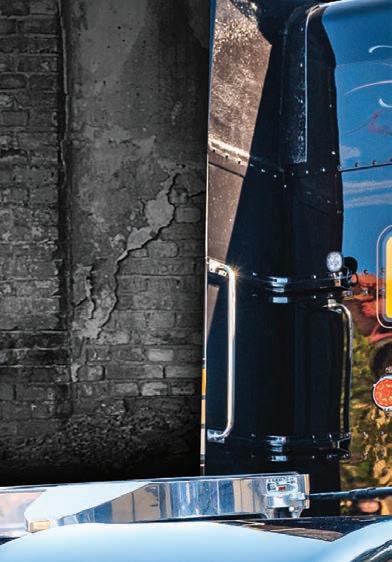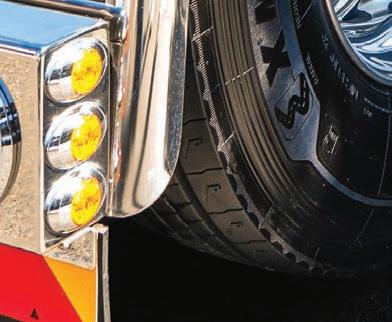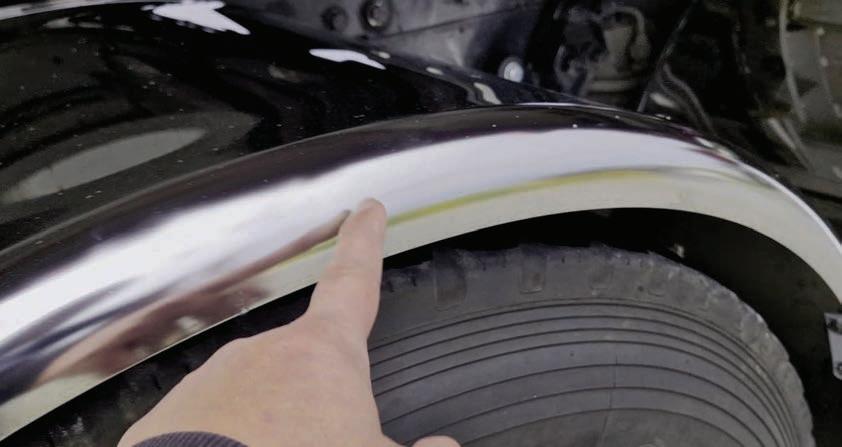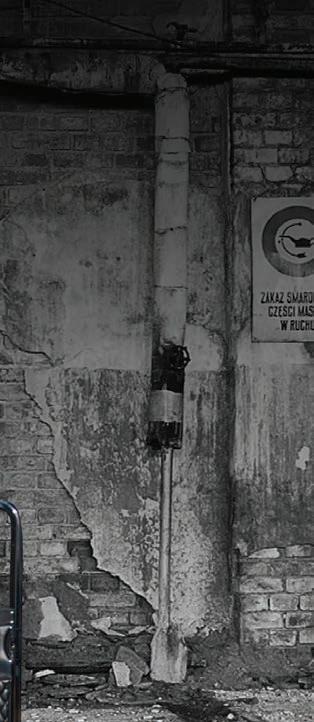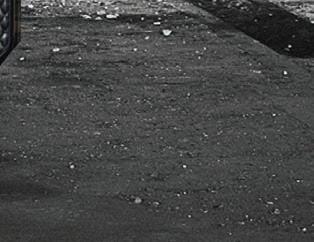












































































Bulk and Rural Carriers Association (LBRCA) of NSW, Wade Lewis, has condemned the actions of those behind the recent vandalism of two
The peak NSW livestock body issued a warning to livestock operators around the country following two alleged acts of animal activism in southern NSW.
The incidents occurred while the livestock trailers were parked and unattended – one at Goulburn on Saturday March 8 and another on the Olympic Highway near Wagga Wagga on Monday March 10.
Both operators were left with a hefty repair bill as a result.
“The damage was extensive and included derogato-
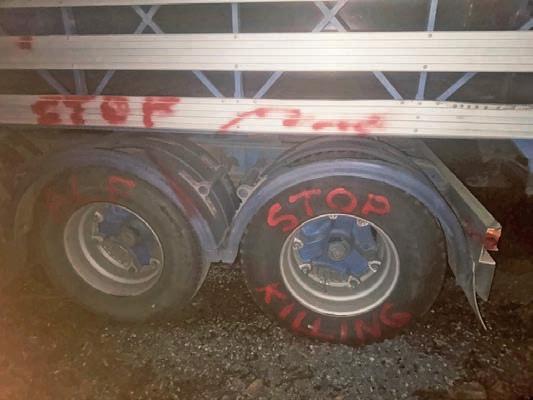
adding there was also significant damage to cabling.
“They’re doing things like cutting airlines, which is a major safety issue for the operator.”
Lewis says this sort of behaviour not only impacts operators financially but can also have a psychological impact too.
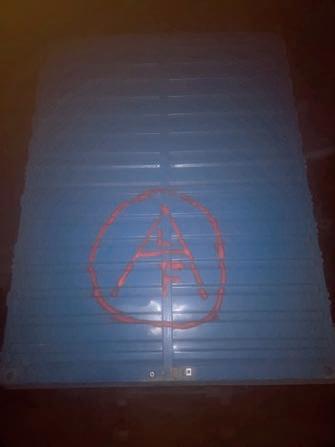
“It has a flow-on effect,” he said. “These operators couldn’t go and pick up their loads, so the livestock is sitting around waiting to be transported. What these activists have done is counterproductive.
“In Australia, we have some of the highest standards in the world when it comes to livestock transport. Our industry contributes $5 billion to the economy each year –and then you have these people who contribute nothing to
society and are causing these sorts of issues, with no consequences.”
According to Lewis, one of the operators targeted is a young owner operator in his twenties. “He’s doing his best to try and make a go of it and make a living for himself. He’s also a member of our association and is committed to contributing to the betterment of the industry,” explained Lewis.
The operator commented, “As an owner operator, I depend on my equipment to earn a living. I’m looking at a repair cost of around $1015,000.”
Lewis added that the statebased livestock animal associations and the national body – the Australian Livestock and Rural Transporters Association (ALRTA) – work closely with various animal


welfare organisations includ ing RSCPA and Animal An gels.
Lewis says the actions of those responsible for the trail er damage is not only coward ly, but also totally misguided.
“They’ve targeted trailers on an isolated part of the highway – and they’ve totally missed the mark. All they’ve done is make more people angry with them rather than making any sort of difference.

“Instead of coming to the table with sensible discussion, they’ve chosen destruction to try and get their message across – and it has failed miserably.
“We’re seeing this sort of thing happen more regularly now. It’s not coming from the established animal welfare groups, it’s the smaller splinter groups.
“We’re asking livestock operators right across Australia to just be vigilant and make sure they do their pre-start checks.”
ALRTA President Gerard Johnson also slammed the actions of those responsible, “While peaceful activism is a cornerstone of democratic societies, illegal activities that harm small businesspeople and their property is completely unacceptable.
“These actions are not only unlawful but deeply harmful to the livelihoods and emotional wellbeing of those affected. Hard working rural Australians need to be pro-
tected from such groups.”
LBRCA shared a photo of an emblem spraypainted on the back of one of the trailers, resembling the same one used by the Animal Liberation Front (ALF), suggesting that the damage may have been carried out by this group.
The Animal Liberation Front is reportedly an international, underground “leaderless resistance” that engages in illegal direct action in pursuit of animal liberation.
The Australian faction has a Facebook group with 5500 followers where it also spruiks t-shirts sporting the logo “gives businesses a fright”. The site hasn’t been active since 2020.
Lewis is calling on police to help find the culprits. “If livestock operators are experiencing this sort of vandalism, we also encourage them to let us know so we can get as much information as we can to the authorities to help put an end to this sort of behaviour.”

























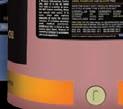



























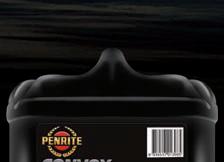













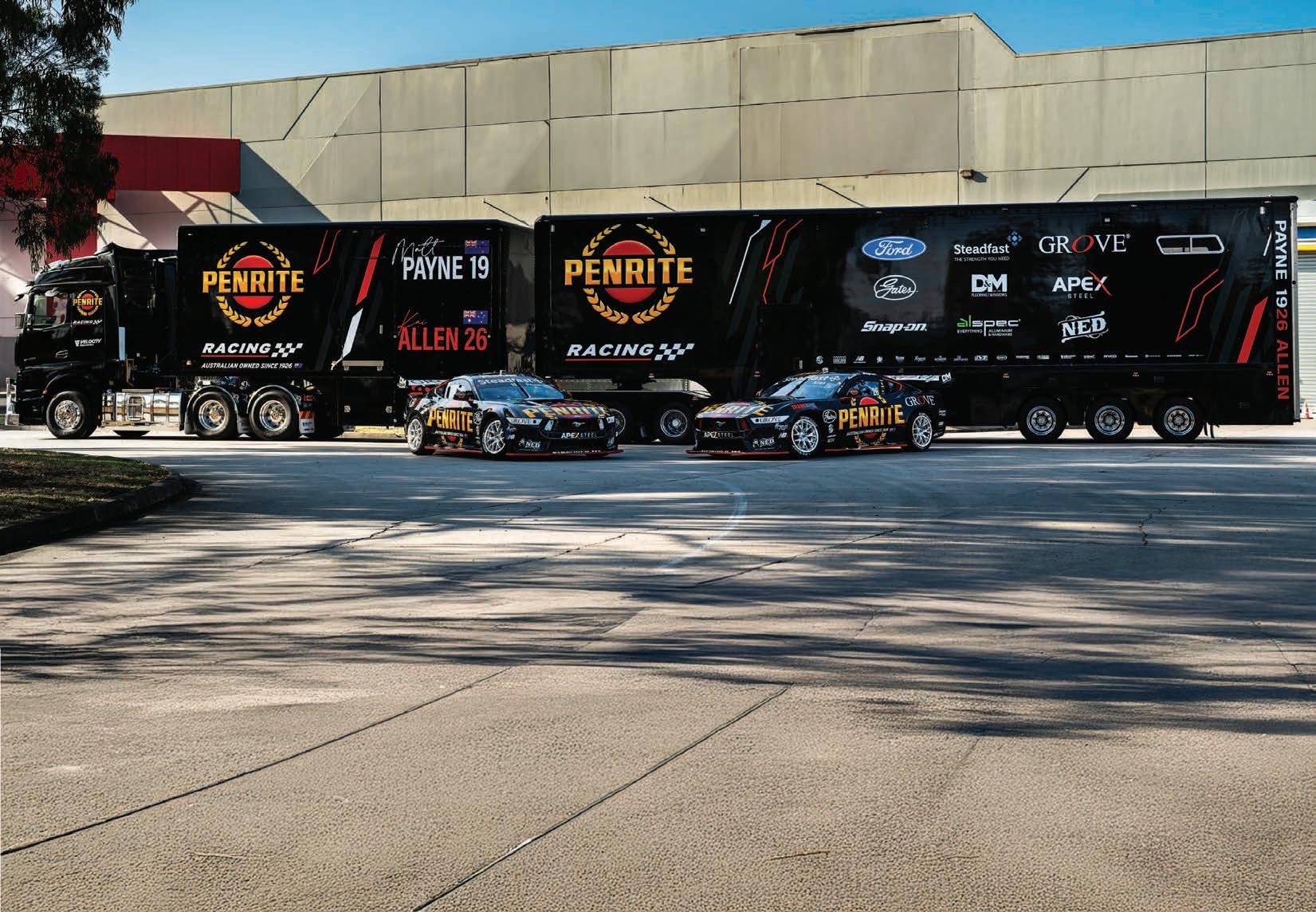

THE rst anyone knew something was amiss was at 4.30am on March 6 when truckie Danny Martin checked in with his after-hours manager at Beerwah-based Armesto’s Transport.
Martin told the o ce he was “helping a new guy”, according to the widely circulated social media post by the Queensland operator later that same day, also asking for industry help to locate Martin.
But Armesto’s also said that didn’t make any sense because there were no breakdowns in the area at the time, the company added.
Martin had been on his usual run from Brisbane to Melbourne at the time of his disapperance.
Later that same morning, police went to the parking

bay at Widgiewa rest area, just south of Narrandera and found Danny’s truck parked in “an odd way”. “ e sleeper air-con was running, keys in the ignition,
tools sitting on step, Danny’s nowhere to be seen.”
NSW Police media released a statement the same day saying that shortly before 9am on March 6 o cers from Murrumbidgee Police District – with the assistance of the SES and VRA – commenced a search of bushland o the Newell Highway, Morundah, for a 50-year-old man.
“Inquiries have established that the man may have suffered a medical episode and walked into bushland about 4am after stopping the truck he was driving along the side of the road,” the police statement read.
It took another 24 hours, or so, before Martin was found, much to the enormous relief of family, friends and the outpouring of support from industry on social media plat-
forms all around Australia.
“He’s alive and well and is just being taken to hospital for precautionary measures – it’s a good result, Inspector Jason Dunn told Big Rigs on the morning of March 7.
“He’s been out in the elements for a day and a half, but he’s alright.”
An Armesto’s spokesperson con rmed to Big Rigs via email that Martin was suffering from dehydration but otherwise okay.
“How good is this news,” wrote Ian Drury on our Facebook page after reading that Martin was found safe and well, a sentiment shared by thousands of other well-wishers.
“Proud of the industry at the moment for their help in trying to nd ol’ mate too, well done all.”
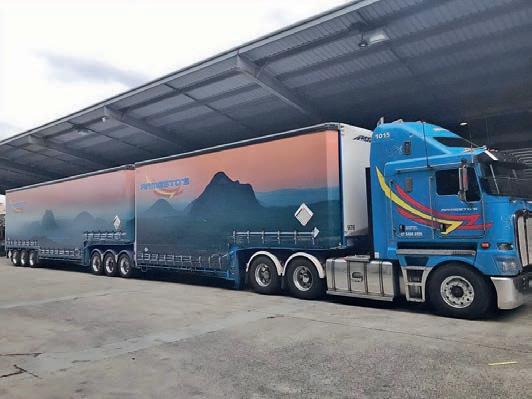
Added Luan Berry: “Well done to Armesto’s Transport for picking it so quickly and raising the alarm. What a great company to work for.”
Armesto’s General Manager Teresa Armesto said Martin was released from Narrandera District Hospital just under a week after he was found.
She couldn’t elaborate on what caused the incident, other than to say she believed it was a medical issue.
Armesto also thanked the emergency services who
found Martin – and the industry for an overwhelming response to the company’s call for help on social media.
“It was just so out of character that we thought something untoward had happened, that was the concern, but I honestly didn’t realise it [the post] was going to go like it did. It was crazy.
“It’s sad that the industry has lost some of that banding together over time, but it’s good to see at times like this that they still can.”
CRIPPLING bridge assessment fees for operators that can run into the tens of thousands will soon be scrapped under a new permit scheme in Victoria.
Known as the Heavy Vehicle Structural Assessment Permit System, it will automate up to 85 per cent of structural assessments for Class 1 and 2 heavy vehicles, signi cantly reducing assessment and response times, and eliminating all fees for industry.
It is expected to be available from January 1, 2026, nally bringing Victoria into line with other jurisdictions which already have a similar system in place.
e cessation of the fees will result in easier access pathways for many heavy vehicle combinations, including innovative B-doubles, A-doubles, Performance
Based Standards (PBS) vehicles, quad-axle semi-trailers, and combinations featuring next-generation low- and zero-emissions trucks.
Victorian Transport Association (VTA) CEO Peter Anderson said the news this week is a big win for industry and the collaboration between the VTA, Heavy Vehicle Industry Australia (HVIA) and NatRoad which lobbied the state government for the change.
“We’re very grateful for the [roads] minister to understand the issues within the industry and to respond so positively and so quickly,”
Anderson said.
“It just shows we have a progressive roads minister in Victoria who is doing the best for our industry.”
Anderson said it’ll take a lot of costs out of getting permits

and running large vehicles on the state’s roads: “It’ll mean we get safer trucks on our roads and means our industry will get greater opportunity to do a better job than what they do today.”
In 2021, leading enginner Robert Smedley told Big Rigs that Victoria is seeing bridge assessments as a “cash cow”, charging anywhere from $5000 to $20,000 per bridge, and sometimes up to $80,000 for a single route, and taking six months to do it.
Other states, meanwhile, are providing the same service for free and turn around applications in less than four weeks.
Anderson agreed that the industry is currently drowning in red tape and unnecessary costs, putting operators under undue nancial pressures.
He cited the example of one VTA member who re-
cently copped a ne from the National Heavy Vehicle Regulator of $54,000 on one load because they were one tonne over on the steer axle and 20kg over on the drive.
“ is is how absurd it is in terms of trying to run a transport business, and how hard it is.
“ e costs that the [federal] government puts on us are absolutely huge.
“So for the Victorian state government to not try and grab every cent they can and to actually acknowledge what the industry has asked them and say we’ll do something to help you is just a remarkable achievement.”
HVIA CEO Todd Hacking said the new permit system is an “absolute win” for industry.
“And also for the wider Victorian community, who
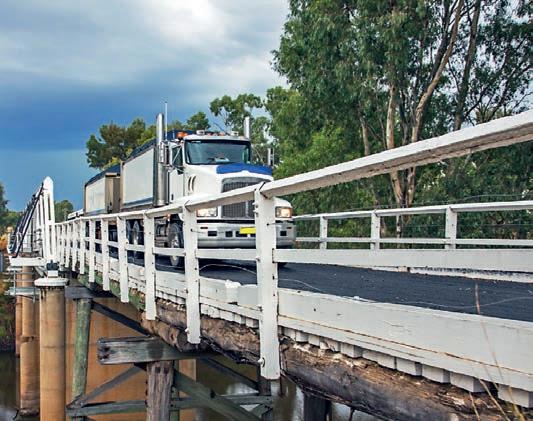
will enjoy the bene ts of a greater number of safer, more productive and more e cient trucks in the years to come.”
NatRoad CEO Warren Clark agreed that this is a great outcome for road transport operators.
“We acknowledge the Victorian Government’s commitment to reducing red tape and improving the e ciency and productivity of our industry.”
To expand its capabilities, Armoury has opened a new workshop in Melbourne, Victoria. Located near the Kenworth factory, this workshop is able to service dealers Australia-wide.
Contact our team to discuss your requirements.


DURING a month-long blitz across three states, targeting heavy vehicles during grape harvest season, the National Heavy Vehicle Regulator (NHVR) says 38 per cent of those intercepted were found to be “non-compliant”.
‘Operation Forti ed’ occurred across New South Wales, Victoria and South Australia, with more than 270 heavy vehicles intercepted.
NHVR Acting Director of Southern Region Stephen Bryers said Safety and Compliance O cers (SCOs) concentrated compliance and enforcement e orts on strategic locations across these states, providing education to drivers on how to meet their safety obligations in 88 of the intercepts conducted.
“We detected a non-compliance rate of around 38 during this year’s operation,” he said. e NHVR con rmed that mechanical issues were the leading cause of non-compliance during this year’s operation. SCOs also recorded low levels of non-compliance with fatigue, permits, mass and dimension.
“ is is the fth time Operation Forti ed has been undertaken in both SA and Vic, and each time the NHVR has led this operation we have seen the rate of non-compliance steadily decrease,” Bryers added.
“ is is down from a non-compliance rate of 42.2 per cent in 2023, 59 per cent in 2022, and 61 per cent in 2021 – this is a true testament

to industry’s collective e orts in driving continuous improvement.”
NHVR Chief Operations
O cer Paul Salvati said Operation Forti ed was critical to ensure the smooth and safe de-
livery of grapes and local produce, from vineyard to shelf.
“Heavy vehicles are currently hitting the road in force as the grape harvest season peaks, however it’s important to remember that safety is always in
season,” Salvati said.
“SA alone produces more that 50 per cent of Australia’s wine, and in 2021-2022, the state’s industry produced more than 800,000 tonnes of grapes valued at $622 million.
“ is just goes to show what a major contributor the industry is to the national economy, and with this kind of scale, it’s vital that the transport of these valuable crops is as smooth as ne wine.”
Operation Forti ed focused on fatigue management, monitoring and identifying potential grape spillage incidents, and mechanical inspections to ensure compliance.
“We know this is busy time of year for the agricultural sector, but we can’t a ord to let
any lapses in safety spoil what should be a very productive season,” Salvati added.
“Some of the primary risks related to grape harvest transportation include driver fatigue, particularly at the end of night shifts or from wait times to either load or o oad, in addition to spillage due to overloading.
“Grape spills have a significant impact on the safety of other road users, creating slippery surfaces that can lead to a vehicle losing control and increasing the risk of catastrophic accidents occurring.”
Salvati said this operation was a crucial step forward in the regulator’s ongoing e orts to reduce crashes and ensure the safety of everyone on the road.
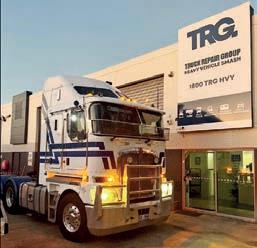
THE liquidator of a national truck repair group has raised concerns in a recent report about undeclared company shares and vehicles and said the company may have traded insolvent from mid-2022.
Truck Repair Group (TRG) went into voluntary liquidation in December owing more than $3.9 million - most of that to the ATO - but is still being operated in ve different locations by the same family under a di erent name, TRG Heavy Vehicle Smash,
owned by TRG Group of Companies.
e liquidated company was solely directed by Scott Hunter, who used to work for the previous owner, Russ Hill, as the General Manager.
Big Rigs spoke to Hunter, but he declined to comment on record. He said his only role was to help the administrators with the closure of the old business.
According to a detailed report sighted by Big Rigs from liquidator Nick Combis of
Vincents, the new company had agreed to pay $117,243 for TRG’s business operations and assets, an amount which should have been $262,543 as “a best-case scenario”.
e liquidator said he had requested funds from the new company, including a $70,000 instalment already due under the existing sale agreement on March 9 and “possible further amount of $192,559”, due by March 17, to cover the shortfall.
e report said the collapsed
company owned shares in related company, TRG Parts & Accessories, which were not declared by the director and had been transferred after the liquidator had been appointed.
“My investigations of this matter are continuing,” Combis said.
Hill said he’s more concerned about the impact the liquidation will have on the smaller operators than recovering what he’s owed by TRG, his long service leave entitle-
ment of $38,000.
“A lot of the people have been ringing me asking what’s going on,” said Hill who sold the business in 2020.
“I have to remind them that I’m on that [creditors’] list too remember, and I haven’t been there for four or ve years.” Creditors have been asked to submit proof of debt forms with the liquidator as soon as possible and also to cast their votes in relation to the payment of liquidation costs by 6pm (AEST) on April 4.






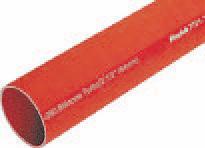



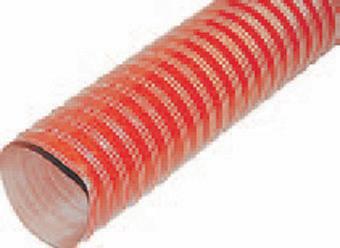


BY JAMES GRAHAM
TRUCK parts bosses are urging customers to be on guard after a spate of online scams have eeced unsuspecting buyers.
Fraudsters are setting up fake websites and Facebook pages, impersonating legitimate truck parts suppliers, and tricking online users into paying for goods that never arrive.
Ben, the General Manager at Rocklea Truck Parts in Queensland, has been at the forefront of battling these con tricks.
“ ey’ve copied our name, our logo, everything,” Ben told Big Rigs
“Customers ring us thinking they’ve placed an order with us, only to nd out they’ve been scammed. It’s infuriating.”
e scammers are using Facebook business pages as their main point of operation, creating cloned versions of legitimate truck parts businesses to deceive customers.
According to Ben, Facebook has been largely ine ective in tackling the problem, despite multiple reports from victims and a ected businesses.
“Facebook could shut this down in a heartbeat, but nothing happens. ere’s a reporting function that just seems to be there to make people think action is being taken when in reality, it isn’t,” he said.

pattern: victims come across a seemingly legitimate truck parts supplier on Facebook, place an order, and are then instructed to transfer money to a bank account.
Once the money is received, the scammers disappear, often blocking their victims from further contact.
foreign accents, suggesting the operation may be based oshore. e nancial losses incurred by customers are signi cant. One unsuspecting buyer lost $4000, while Ben estimates that the total amount scammed
on the fake Rocklea Truck Parts pages could be upwards
“Customers are getting stitched up. It puts a bad taste in people’s mouths when they think they’re dealing with us, only to realise they’ve been scammed,” he said.
Queensland Truck Spares has also been a ected, with
SYDNEY
510 Victoria Street, Wetherill Park NSW 2164 Ph. 02 9756 6199, email: isri@isri.com.au, www.isri.com.au
BRISBANE
co-owner and director Nick Wirth con rming to Big Rigs that they had managed to get one fraudulent Facebook account shut down after extensive e ort.
However, he remains skeptical about whether this will have a lasting impact.
“With a lot of back and forth, requiring people to individually report posts and accounts, we had the scammer successfully removed from Facebook - for now.
“But we know this is only a temporary x. Facebook’s platform has aws in preventing these scams.”
Wendy Berry, co-owner of Rocklea Truck Spares, said it’s an ongoing battle to stay one step ahead of the scammers.
A few weeks ago, she successfully got a fake page removed from Facebook after three months of daily reports, only for it to reappear four days later with Sean back at the helm.
Berry said her scammer now operates on Facebook’s Marketplace platform advertising truck wrecking under their business name.
“He sends them a message back saying it’s going to cost this much money, this much freight, you need to pay this much deposit, then he sends them an invoice.
“Our advice is to never buy o Marketplace if they want a deposit, or you can’t check out
the item rst. If he was a real company you’d also be able to ring his business.”
NQ Truck Wreckers is another Queensland company impacted by the scammers who is urging customers to stay alert.
“Yes people, double check your facts,” the company posted online. “We have had a Facebook ‘impersonator’ for almost two years now! So hard to get them taken down!!!!!” Ben suggests that a deep dive into advertisements can sometimes reveal inconsistencies, as scammers often copy marketing material from multiple sources, including international truck parts dealers.
“If you look close enough, you’ll see that the ads show products from multiple locations.
“But most customers don’t notice these details,” he said. As the scam continues to evolve, industry members are calling for increased vigilance and stronger intervention from authorities and social media companies.
“At the end of the day, customers need to do their due diligence before making payments online,” Ben advised.
“Check the legitimacy of the business, con rm contact details, and avoid direct bank transfers when possible.” Facebook has been contacted for comment.


3/120 Gardens Drive, Willawong QLD 4110 Ph. 07 3275 2044, email: sales@isribrisbane.com.au, www.isribrisbane.com.au
BRISBANE NORTH
1/259 Cullen Av, Eagle Farm QLD 4009 Ph 1300 11 4774, email: seats@isrinb.com.au, www.isrinb.com.au
MELBOURNE
Unit 1/569 Somerville Rd, Sunshine West VIC, 3020 Ph. 03 9311 5544, email: sales@isrisunshine.com.au, www.isri.com.au
MACKAY
110 – 120 Maggiolo Drive, Paget QLD 4740 Ph. 07 4952 1844, email: admin@isrimky.com.au, www.isriseatsmackay.com.au
PERTH
408 Welshpool Rd, Welshpool WA 6106 Ph. 08 9362 6800, email: info@mmtisri.com.au, www.mmtisri.com.au
DARWIN
Mobile Sales and Service
Ph. 08 8927 0986, email: info@isridarwin.com.au, www.isridarwin.com.au
NEWCASTLE/HUNTER VALLEY
Ph 02 4932 0600,
Unit 2/13 Hinkler Ave, Rutherford NSW 2320 email: sales@hvss.com.au www.isri.com.au






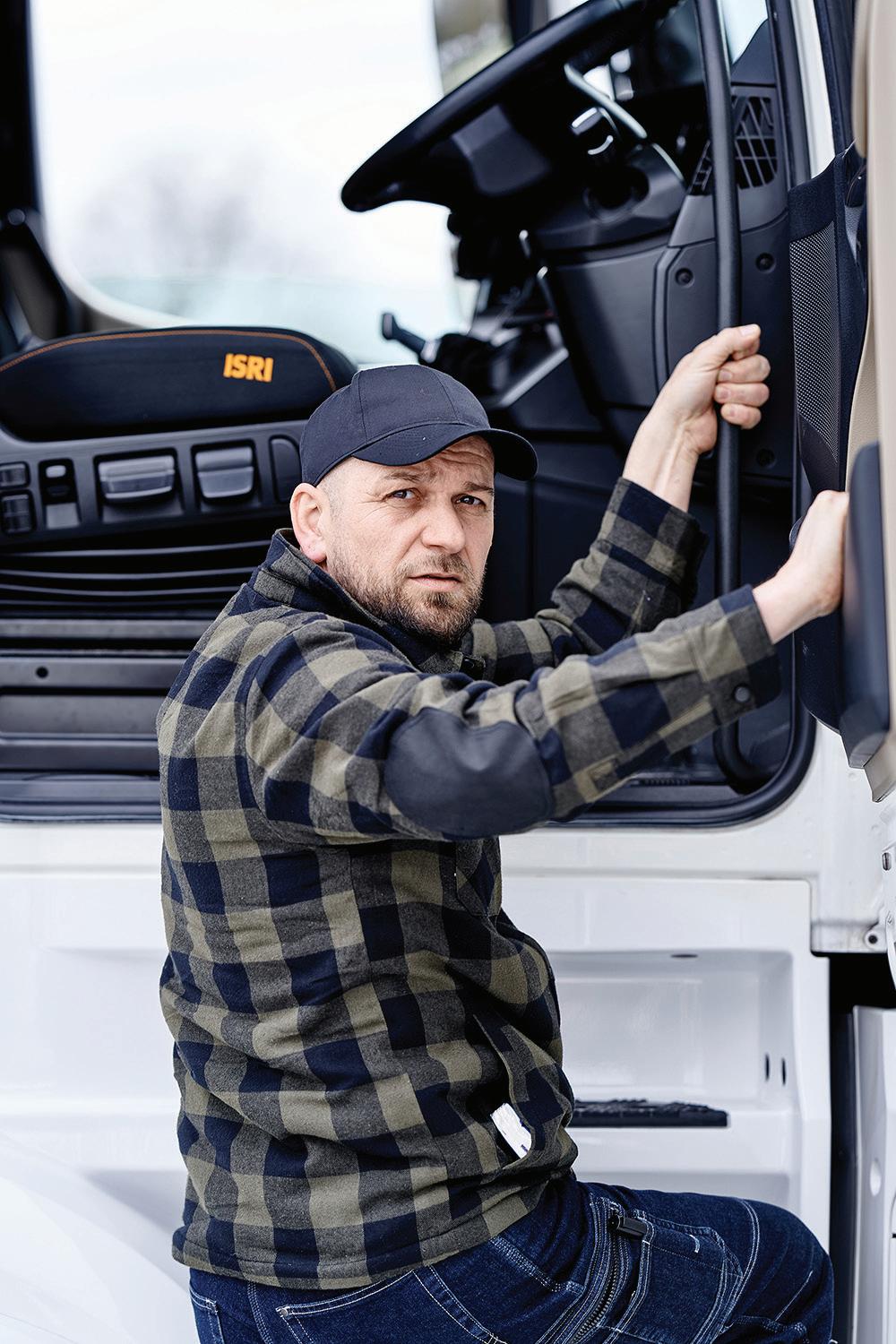

BY JAMES GRAHAM
WHEN Jim Foody’s truck was pulled over on the Kennedy Highway near Mareeba, he expected a routine inspection.
What unfolded instead was an incident he said raised serious questions about the National Heavy Vehicle Regulator’s (NHVR) understanding of Dangerous Goods (DG) compliance – questions that could have had severe safety implications.
Foody, the owner of Bamaga Transport and star of the popular Outback Truckers, TV series, runs a demanding freight operation between Cairns and the tip of Cape York, often carrying LPG gas cylinders for BOC.
Given the nature of his cargo, he ensures his team is wellversed in DG regulations. In December, both he and his driver completed DG licensing to stay updated with the latest safety and compliance requirements. He said that knowledge, however, was ignored when NHVR o cers made a surprising demand.
“ ey pulled my driver over and asked if the gas bottles were empty. When he said yes, they went o , consulted someone over the phone, and came back saying we needed to remove the DG placards,” Foody explained.
“ at’s completely against the law. An LPG cylinder is still classi ed as Dangerous Goods unless it has been purged with nitrogen and certi ed as empty.”
According to Australian DG laws, gas cylinders - whether
full or empty - must remain placarded unless they’ve been professionally purged.
Ignoring this regulation could lead to severe consequences in the event of an accident. Yet, Foody said the NHVR o cers insisted the placards be removed, under the reasoning that emergency services needed to know the cylinders were empty.
“ is wasn’t just a simple misunderstanding - it was dangerous,” Foody emphasised.
“Had my driver been involved in an accident while descending the Kuranda Range, emergency responders would have had no way of knowing they were dealing with LPG. at’s beyond serious – it’s reckless.”
e NHVR didn’t issue a ne, which Foody believes indicates uncertainty on their part.
“If they were con dent in their decision, they would’ve ned us,” he said. “But they didn’t, which tells me they weren’t sure themselves.”
Foody said he’s become increasingly concerned about the knowledge and training of NHVR o cers since the regulator took over compliance and enforcement duties in the state in early 2024 - especially when it comes to DG compliance.
“I’ve tried reaching out to them, but no one’s interested in discussing it,” he said.
“I’ve heard similar complaints from others in the industry. It seems like they’re sending out undertrained ofcers who don’t fully under-
stand what they’re enforcing.”
Bamaga Transport operates in one of Australia’s toughest environments. Roads are brutal, and a single trip can take a severe toll on vehicles. Foody, who has expanded from a small truck-and-dog operation in 2020 to running triple road trains, understands the importance of compliance and maintenance.
“We run up to Bamaga every 12 days in the dry season. e terrain is unforgiving. ere are stretches where it takes us six or seven hours to cover just 12 kilometres,” he explained.
“As well as routine maintenance every trip, we do full maintenance every wet season, going over everything to ensure our trucks are in top condition. You can’t take shortcuts up there - it’ll come back to bite you.”
His Isuzu truck, pulled over just 70km from its home depot after a 1000km return trip from Bamaga, was already scheduled for repairs. While he had no issue with the defect notices issued he was frustrated by the o cers’ approach.
“ ey told my driver to drive the truck [with DG placards removed] 70km to the Kenny St Transport Inspection Facility in Cairns so it could have a pit inspection and brake test. All the major defects found were already known to us and occurred on the current trip. But some of the so-called defects they found were absurd.
“ e truck is a 2004 model, and they defected it because the dashboard lights didn’t come on when the key was turned to accessory mode.
at’s not a fault – it was never designed to do that.”
“We were then told to drive the truck to a repair facility and get it re-inspected before we could use it again, which I have no issue with.”
Foody, who has worked with NHVR o cers in the past, has noticed a decline in knowledge and professionalism.
“ e rst NHVR guys I dealt with were great. ey understood compliance and appreciated operators who did their best to stay within the rules. But now, it feels like we’re dealing with a whole new crew who don’t have the training they need.”
e incident on Australia Day, January 26, was the nal straw.
“I usually let these things slide, but this time, it felt bigger. If enforcement o cers don’t understand the Dangerous Goods Act, they’re putting people at risk.”
He has compiled the exact clauses NHVR o cers ignored and is willing to provide them to authorities – if they’re willing to listen.
“I even consulted with the expert who trained us in DG licensing, and he con rmed we were in the right. But NHVR doesn’t seem interested in that.”
Foody isn’t against regulation. In fact, he believes a well-run NHVR bene ts the industry.
“When done right, NHVR simpli es things – permits, compliance, and wide loads are all much better managed now. But enforcement needs
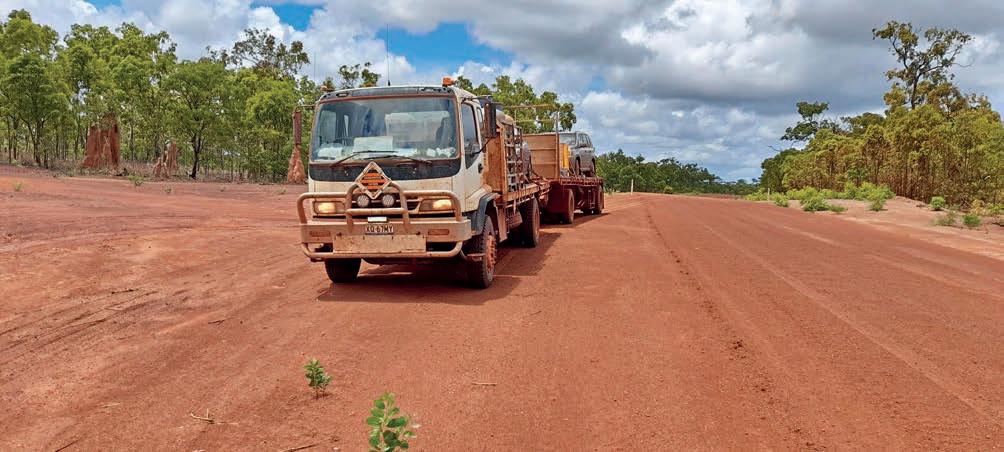



to be consistent and knowledgeable. Right now, that’s not happening.”
Despite the frustrations, Foody said he remains committed to running a compliant operation, regardless of the challenges posed by regulators.
“We take our responsibilities seriously, but we need regulators who do the same.”
An NHVR spokesperson told Big Rigs that as a safety and customer-focused organisation, the National Heavy Vehicle Regulator is committed to resolving complaints in a timely and professional manner.
“Should an individual have
feedback about our service delivery, we encourage them to get in touch.”
e spokesperson said more information about how to make a complaint can be found on its website at nhvr. gov.au/contact-us. Meanwhile, the National Transport Commission (NTC) is currently conducting the rst comprehensive review of the Australian Dangerous Goods Code in 15 years.
Over the coming months, the NTC will host regular webinar ‘drop-in’ sessions to keep stakeholders informed about the feedback received and how it is being incorpo-




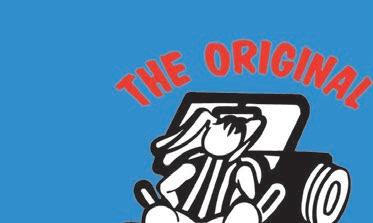






NSW-BASED electric truck converter, Janus Electric, should soon be a publicly listed company with backing to rapidly scale up its expansion plans.
e Central Coast start-up has struck up a reverse takeover deal with the ASX-listed ReNu Energy, an Australia-based company that delivers clean energy products and services.
Instead of going through a costly and time-consuming listing process itself, Janus will use the shell of ReNu Energy which already has all the ASX structure in place. ReNu divested itself of its hydrogen interests last month to reposition itself as a heavy transport electri cation business.
ReNu will acquire 100 per cent of Janus’ issued share capital in exchange for ReNu shares and be renamed Janus Electric Holdings Limited when the acquisition is nalised. e new company is expected to start trading on the ASX on April 22. To support the transition, ReNu released a Capital Raising O er (CRO) at 20 cents per ordinary share to raise between $8 million and $10 million.
e deal will also see a new management structure with Ian Campbell, a former Citigroup Australia banker as managing director, and co-founder Lex Forsyth taking on the chief operating ofcer duties.
Forsyth told Big Rigs that
he’s excited about the di erence the deal will make to the growth at Janus, which has not been without its teething problems in the early stages.
One of the biggest setbacks was a re in one of its trucks on the West Gate Freeway in 2023, which was a caused by a rogue battery cell issue.
Forsyth said 30 per cent of the CRO allocation had already been picked up by day one and he is con dent that the initial o ering will be closed out quickly.
“It’ll see us scale production and assembly of trucks and lift our build rate quite signi cantly,” said Forsyth when asked about what di erence the new funds will make.
“It will also lead to an infrastructure and battery fund



that will scale the volume of batteries within the business as well.”
Janus already boasts 23 converted trucks with high-prole clients that include Fennell Forestry, Cement Australia, Qube Bulk, NewCold and Symons & Clark Transport.
Forsyth said the company also has another 142 contracted orders on the books.
“I think it’s a an extremely well-valued o er,” Forsyth said of the deal with ReNu.
“I know the under-pinning value in the business. I’ve reinvested into the business and so has my family.
“We are a big believer in what we’re achieving, and I know what the future holds and where energy is going as
a whole for the transport industry.”
Campbell said there were 80,000 prime movers that were less than 15 years old on Australian roads, and these were the main target market
for conversions which cost around $175,000.
“ ere is room for disruption. is is one of those events where there is a market large enough for a disrupter,” he said.
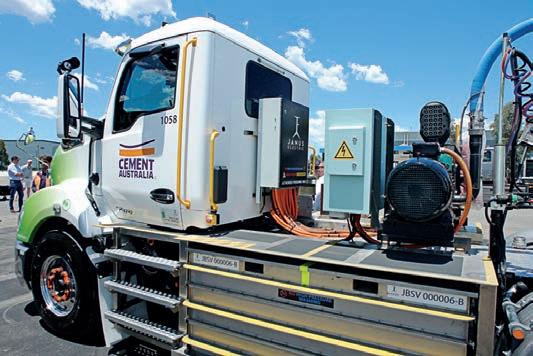
Driving Concepts Pty Ltd, an entity controlled by Ron Finemore Transport, has snapped up 28 million shares in Lindsay Australia.
e deal was announced earlier this week for $0.6200 per share, resulting in a 8.89 per cent interest in Lindsay for the Wodonga-based company.
Lindsay Australia has a $227 million market value
and made a $15.8 million underlying net pro t for the six months to December.
e Brisbane-based giant recently revealed an acquisition of its own with the purchase of WA operator GJ Freight, an operator that generates more than $20 million in annual revenue.
Lindsay Australia also has a new Perth depot due for completion later this year.
is development is expected to deliver operational eciencies and synergy bene ts with the GJ Freight acquisition.
Late last year, Ron Finemore hired former Australia Post executive James Dixon to become chief executive.
Dixon declined to comment about the Safe Driving Concepts buy-up of Lindsay Australia shares and what it






might mean for Ron Finemore Transport when approached by Big Rigs With 280 prime movers and 900 sta , Ron Finemore Transport provides regional and inter-capital city linehaul road transport services across two major operating divisions – food, produce (either ambient or temperature controlled) and manufactured goods and bulk liquids.























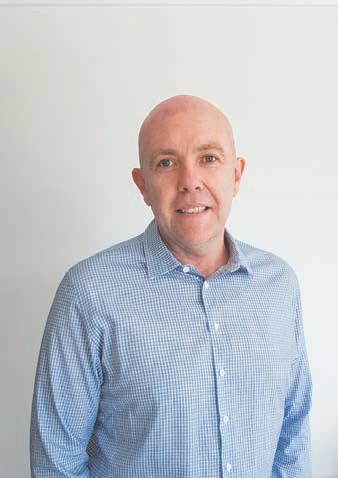
EDITOR JAMES GRAHAM
It proves that drivers are still looking out for each other when it matters most, as we also saw recently in the North Queensland floods.
We can only hope that transport ministers have the same empathy for truckies when they see the first draft of the new-look Heavy Vehicle National Law later this year.
Our columnist Jodie Broadbent wasn’t holding out much hope in her well-read column in out last issue, ‘Why can others make mistakes without consequences while truckies are fined?
It got a phenomenal response online and also inspired this issue’s cartoon on the right by Ryan-Lee Taylor.
It’s no wonder we have a driver shortage with the ever-present threat of losing a week’s wages for an issue that doesn’t affect anyone’s safety.

JODIE Broadbent’s column in our last issue about disparities in penalties for truckies compared with other roles and industries touched a raw nerve amongst readers.
“Yeah, what other industry in Australia can you get fined some stupid amount for forgetting to tick a box on a page? Absolute BS, nothing to do with safety at all,” wrote Ryan Edwards.
John Klye said police should stay out of drivers’ logbooks: “It’s not their job any more. They can look after the road rules only - like speeding. And going after the REAL
road safety problem - car drivers . They’re not qualified to manage fatigue regulation.
I’ve seen one copper ignore an NHVR officer’s ruled line and go back further to find something to issue a ticket.”
Joy Burns believes the only way to solve the issue is if the industry stopped.
“It would be sorted in about three weeks to a month. Hurt the bulk of the population. No fuel, food, medicines, etc. The problem is the big companies won’t do it, and the little blokes can’t do it on their own.”
Operator Sally Tipping said
Covid was the time to push for an image change for the industry.
“I pushed this to the big end but they could not/ would not see the potential in promoting our industry.
Now we see a floundering industry, with multiple start-up companies lasting a year or two while stripping the hell out of rates.”
Chris Cartwright said it’s all about attitude: “Been fined plenty of times, and not one of them I didn’t earn by my choices…change your choices and you change your outcome.”
NEWS that NSW will ick the switch on cameras to capture speeding light vehicles on sections of the Paci c and Hume Highways was met with resounding cheers by online readers.
“I love how everyone gets upset when they do stuff like this car drives but don’t care when it is happening to truck drivers I say if it good for one it is good the other,” wrote Glenn Smerdon.
Rod Leven also had little sympathy for car drivers.
“Not getting enough money from truck drivers because of speed limiters or from the NHVR for defective or
overloaded vehicles, those poor politicians aren’t getting enough money. Poor Buggers, I feel sorry for them NOT!”
Added Davos Trading:
“What better time to bring up the subject of how dangerous speed limiters are.
“They have several bad flaws that cause significant danger ous and regular safety risks. More so to a new operator.
“So, before they encourage more accidents, they should at least understand how they ac tually cause them now, first.”
Chris Kohen joked that the government is now considering logbooks for car drivers as well so they can better manage
ANDY Hughes also stirred up plenty of debate with his column in the February 28 issue about the role driving instructors play in keeping roads safe.
Truckie Niell Graham told us that he’d stumbled across a company in Victoria advertising for a driver-trainer and you only needed to have had your truck licence for 12 months.
“I would’ve thought you would need a minimum of five years because you learn nothing in 12 months.”
Paul Warren said driver instructor training is the key.
“They need to be trained and shown how to do the job properly. If they can’t read, write, and
their fatigue, and cars towing caravans will be directed to weighbridges for checks.
“I suppose that’s fair; same rules for everyone.”
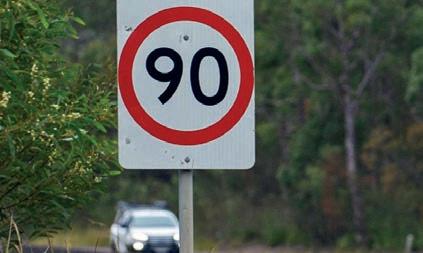
THE Australian Trucking Association’s pre-election plea for the government to do more to support trainee drivers and their employers was another hot button issue for our Facebook followers.
“Employers want fully trained drivers with 50 years’ experience at 21 years of age, they don’t want to train them,” said Bruce Skelton.
“You start in the yard and work your way up, but today’s drivers want the big shiny banners with all the bells and whistles straight away.”
Adrian Bates said it’s a licence holder’s reasonability to know
speak English, and they can’t reverse, then no licence should be handed out.”
Ross Boothby agreed that instructors have a major role to play to get new drivers ready, confident and competent with all aspects of driving.
“But nowdays the drivers only see trucking as a job, they don’t see it as a craft. Like anything in life, you need to learn your craft in order to become better. That’s where I feel we fall off the wagon in this industry.”
Ash Anderson said she’s a Queensland-based instructor where an RTO’s only involvement is for an MC licence.
“But I do find it shocking that there is no set standards for the
all rules and regulations pertaining to the class of license they hold and to the class of vehicle they are driving.
“A one day driving courses and $700 gets a driver a license but no knowledge. “Where would a new heavy vehicle driver be able to find the information, they need to know to be safe out on the road. The driving schools need to do more to inform their students when training them.” Added Brendan Callon: “Since when does one need to undertake an apprenticeship to drive a truck, you bloody twits! There is already too much BS
lower license classes. It is up to us instructors to get the students to test standard so that they will pass, where there is no requirement for discussion or education on load restraint, using a work diary or fatigue management.”

red tape and ‘training’, cough, cough.”
Brad Dean said this system is already in place. “Plenty of large companies sign their drivers up as trainees, and the government subsidises their wages.”




































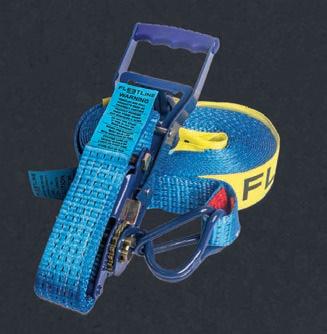
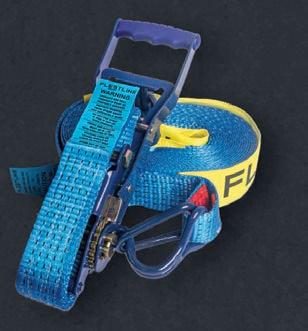






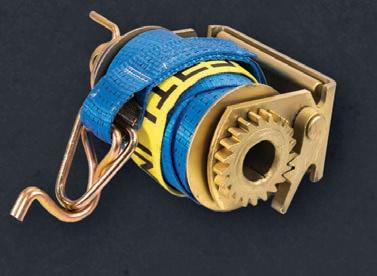




























True
to form, Darren Nolan took the burden away from distraught family members to talk about their loss
BY TIM GILES
THE funeral for trucking industry identity, Darren Nolan, of Nolan’s Interstate Transport, took place at Saint Mary’s Catholic Church, in Gatton, Queensland on March 15.
Darren sadly passed away on March 6, aged 54, after a prolonged battle with cancer, the same cancer which his father, another industry icon, Terry Nolan, had died from.
In what was described as a “truly unique and heartfelt gesture”, Darren, true to form, had actually prepared his own eulogy on video for the packed funeral service, a video that left most of the mourners in attendance in tears.
Organising this video was a typical Darren thing to do, taking the burden away from distraught family members to talk in public about the man and their loss, handling it himself.
e attendance showed the a ection for Darren and his family in the trucking industry, and the importance of this large family-run trucking business in bringing progress across a wide range of areas, for the Gatton community and the trucking industry as a whole.
“I’m doing this eulogy to take the pressure o of making someone t years and
years of my lifetime into 15 minutes and feel incredibly nervous about doing it,” said Darren on video.
“Sit back, relax and enjoy the show.”
Darren’s parents, Terry and Daphne Nolan, had seen their eet grow fast at the same time as road transport became such a major factor in the Australian economy.
In the 90s, in the aftermath of the Grafton and Clybucca truck and bus crashes, there was an increased emphasis on safety in eets and new accreditation schemes were being developed.
One of the eets involved was Nolan’s. e workshop manager at the time, Craig Roseneder, was a pioneer in creating a robust system to ensure safe trucks on our roads, and Nolans’ membership number for TruckSafe is 001, as a result.
Terry Nolan insisted that his children had to work outside of the business, before working in the Nolans enterprise.
For Darren this was a period of working in the hospitality industry and overseas in Norway.
When he did return to the trucking game, Darren was given a number of roles before settling into one assisting Craig Roseneder. e task at hand was to be part of the pilot scheme,
with a video that left mourners in tears.
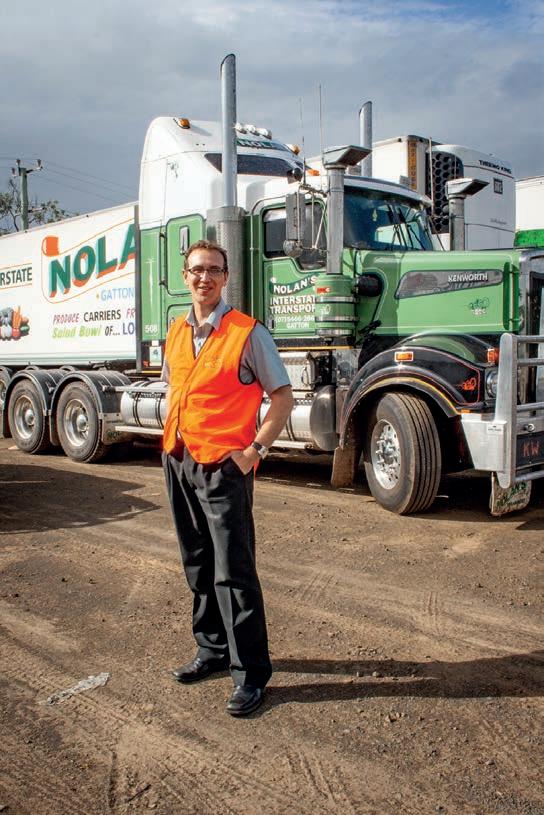
developing an improved regime, which would enhance fatigue management in the trucking industry, but also enable productivity levels to
be maintained.
is was a process of rewriting and re ning the standards of the time, putting processes in place and working out what kind of paper trail was needed. an important part of this was developing new ways of recording various aspects of truck maintenance.

is was the template used to develop AFM, BFM and standard hours, as well as the Trucksafe scheme we have
After Craig’s passing Darren took on more of the compliance role and developed the ideas they had developed
He also became an advocate for safety and compliance systems, ending up on the Trucksafe board for several years, and speaking nationally and internationally on the
Until last year, Darren continued his roles within the family business, working with his brother, Flea, to steer the continuing upward trajectory in the Nolan’s Interstate Transport business. Darren will be remembered, both for his genuine thoughtfulness towards others and his passion and vision to bring improved outcomes into the trucking industry.
He was also a gure who could present a positive and considered argument to those legislating and regulating the trucking game.
“ e many people that I
Industry tributes
I’m saddened by this news. Darren was an amazing individual, someone who would always be ready to lend a hand if it meant that industry would be the eneficiar a s thin in for the enefit of a arren as an in str cha pion an honest carin individual and my friend. I will miss him dearly and o r tho hts are ith arena e ai e an the No an family. RIP my friend.
Jacquelene Brotherton, Chair Transport Women Australia Limited
tre e sa ne s con o ences to the fa i arren as s ch an a a in a ocate for the in str
Gary Mahon, CEO Queensland Trucking Association
We were saddened to hear the news of Darren’s passin after a on att e ith cancer On eha f of the oar an staff offer eepest con o ences to arren s ife arena an a hter e ai e the entire No an fa i an the No an s nterstate ransport fa i arren as e no n to an in the in str for his or in the safet an co p iance area a on stan in oar e er of r c safe as e as an other oar s an co ittees
Ben Maguire, former CEO Australian Trucking Association con o ences to the No an fa i arren as s ch a professiona an s ch a in an
Steve Shearer, Executive Officer, South Australian Road Transport Association he in str has ost one of its est On eha f of R o r e ers an a in the in str ho ha the pri i e e to or ith or no arren e e press o r eepest con o ences to arren s fa i an or co ea es He a e a si nificant contri tion to the in str an to an peop e s i es One of the nicest an ost sincere so s e er to race this in str
Todd Hacking, CEO at Heavy Vehicle Industry Australia ncre i sa ne s n a so te ent e an tte
worked with were exceptional people, very skilled at what they did,” said Darren in his eulogy.
“ ey would probably call me a hard boss to work with.
I suppose I have pretty high expectations, you might have to ask them, but I couldn’t have done what I do without the group of people that I worked with and a huge amount of assistance from my mum.
“Quite often she doesn’t get the credit that she deserves. She’s looked after everyone, from her sister who was ill, to her mother, to all these people, she’s always put them rst. She’s had to go through the aches and pains, and she managed that without whinging once about the situation.
“I believe that she’s the cement, the glue, that holds everything together for the family. What she’s been able
to do in her lifetime is phenomenal, she’s an extraordinary woman.”
On a personal note, I would like to add that I had the privilege of working with Darren in writing a book about the history of the Nolan’s business, back in 2007, for the operation’s 100th anniversary.
I can attest to the qualities many others recognised in him. He was great to work with, considerate and reliable. He was also hot on getting the details right and, surprisingly, a pretty damn good photographer, and we used many of his shots in the book.
“How would I like my life to be celebrated?” said Darren via his farewell video. “Well, French champagne is number one.”
Darren is survived by wife Sarena and their daughter Adelaide.

Mack is more than a truck. From uptime services to parts and maintenance, Mack is an indispensable part of your business.
Mack. By Australia’s Side.

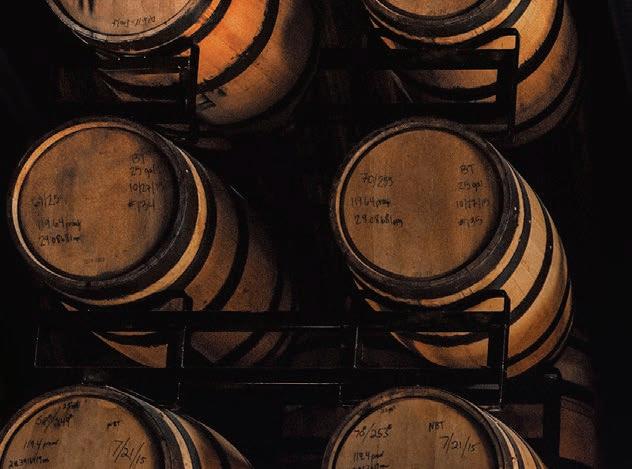

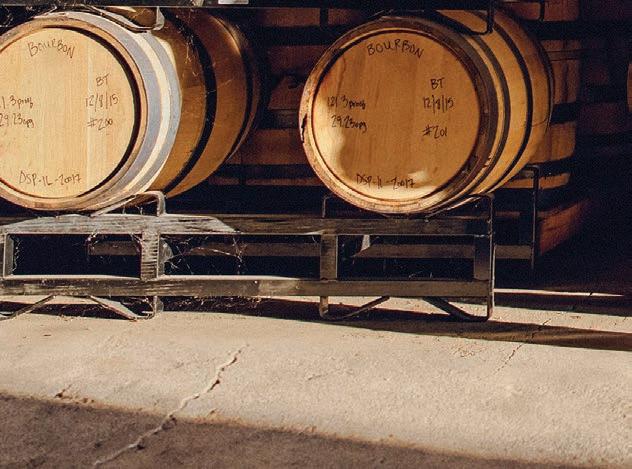



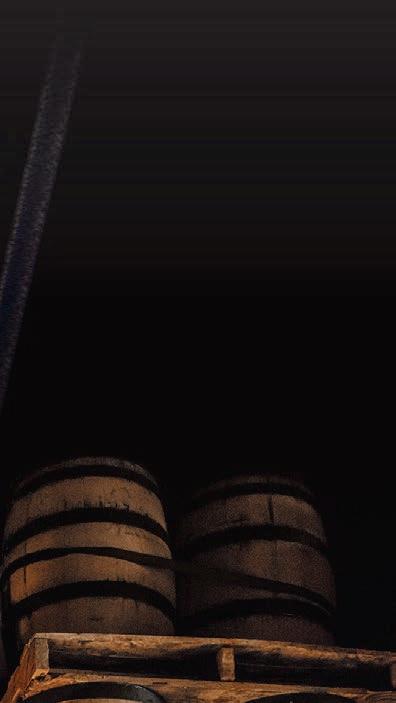

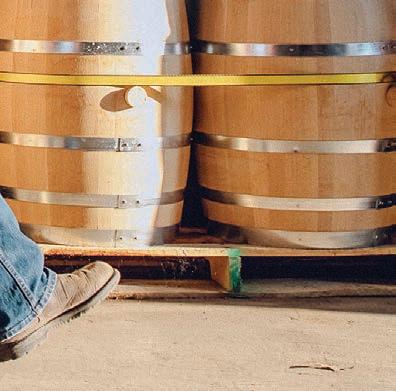





The first 780hp Mack Super-Liner in New Zealand couldn’t have gone to a better home than Golden Contracting, specialists in cartage and aggregate supply.
MARK ‘Skip’ Golden reached a major milestone in his long career in the transport industry when he rst laid eyes on his brand new Mack Super-Liner at the manufacturer’s Brisbane HQ earlier this month.
“When I heard about the 780hp Super-Liner from a conference call, I thought ‘imagine getting the rst one o the line for New Zealand?’” said Skip, who is also celebrating 25 years since he bought his rst truck.
“I initialled an agreement without even asking the purchase price.”
As a proud Mack owner, the boss of Golden Contracting, based in Silverdale, 30km north of Auckland, said there was never any question about his decision.
“ is wasn’t just about the horsepower, it’s the conventional look of the Mack, especially with the commemorative big hood Mack o ered to t on this truck.
“It’s a numbered truck, I want it to be remembered, and Taite who will be pedalling it, is Mack through and through himself.”
But while it might sound like an emotion-based acquisition to the eet, Skip said there’s some hard business logic behind it as well.
“I rate trucks by their cents-per-kilometre over the life of the vehicle, and the Macks have consistently outperformed other brands when it comes to durability, reliability and fuel e ciency,” he said.
“We had a Trident that we ran for 550,000km before it went for a mid-life, and that cost us a fraction of what we were expecting.”
Skip’s drivers also love the Macks, something he attributes in part to the mDRIVE automated transmission.
“No other transmission gets near it,” Skip said. “Just when you’re thinking you might need to change gear it does it. It’s so intuitive, it knows exactly when to shift and it’s very smooth on the pedal. It’s peace of mind in the gnarly terrain.
“Some people may call me soft for not using a manual, I just say, ‘What are you doing to yourself? Why get fatigued driving when the mDRIVE can just drive you around, and with better fuel e ciency?’”
Skip said the Super-Liner’s 780hp Euro 6 engine is also something he’s looking forward to driving.
“It’s not like we need that much power, but it gives even better fuel e ciency, and you know if you really want to let the Big Dog out to eat then it’s there,” he said.
“We are more than happy to be passed on the ats, but you’d want to be checking your mirrors on the climb!”
Golden Contracting, specialists in cartage and aggregate supply, work their trucks hard, doing double shifts, supporting roading, commercial projects and rural farms around the upper North Island for over 800 customers.
“You need a mixed eet for the di erent things we do, and the Macks give us impressive tare weight, good ground clearance, great visibility and a tight turning circle. e Macks t us like a glove really,” Skip said.
Skip’s association with Mack goes back to the days when he was working as an engineer, and his friend Dale Fenton had a R Model and a 440 Super-Liner in a yard across the road.
“I was into anything with moving parts, and I just formed a bond with these trucks, I was really drawn to them,” Skip said.
“It was 2015 when our rst bulldog entered the eet, a Mack Trident. Word went out I was in the market and salesmen turned up from every brand, but I took that Trident around the block just once and I was sold.”
After 15 years in the game, Skip nally had a Dog out the front.
He also once bought a Trident at such a good price that he kept in the shed for six years until he needed it. He nicknamed it ‘Not Ready’.
Skip also now has a 100year anniversary Super-Liner with the bonnet badge ‘ ird Wife’, as he said “it’s cheaper to marry a Mack”, and another Trident named ‘Born Ready’.
“Even now we’re looking at the next acquisition, and we’ll keep buying them.
“I’ve always been a bit of a bulldog myself, so the Mack is the ideal truck for me, but there’s more to it than that.
“We go into some pretty rough o -road terrain: forestry skid-sites, farm tracks, loose metal, you name it, and the traction and high torque curve on the Macks is ideally suited for this work.
“If I go into some of the rough country up the top of the North Island in a Mack, I know I’m coming home that night, they’re dependable.”
is dependability is something he’s come to expect not just from his trucks, but from Mack as a company.
“Mack take things seriously,” Skip said. “You’ve heard people talk about being part of the Mack family? Well, it really is like that.
“It’s a unique community you join when you buy a

Mack. It’s a bit like rugby; there’s a lot of camaraderie beyond the business.”
At this month’s handover, Tony O’Connell, Vice President Mack Trucks Australia, said he was thrilled to be able to deliver this example of Mack’s engineering skills to Golden Contracting.
“ is is a company that understands the true value Mack o ers, not just in terms of our trucks, but the long-term relationships we build,” O’Connell said.
“We couldn’t be prouder to see the NZ Number One 780hp Super-Liner joining the Golden Contracting stable in New Zealand.”
Scott Holt, General Manager of MTD, Mack Trucks New Zealand’s distributor was also pleased to see the very rst 780hp Mack for New Zealand going into the Golden eet, alongside its other Super-Liner.
“ is is certainly a re ection of the strong relationship Skip has with our team and the outstanding quality and performance of Mack over the long term.
“ e handover of this unit at VGA in Brisbane is a pivotal moment for Mack in New Zealand, heralding the class leading MP11 Super-Liners and Titans as they start hitting the roads here.
“We are proud to have supported Skip and his team with this impressive Super-Liner that is purpose built for the job, and look forward to seeing it take pride of place on Skip’s Silverdale yard.”




A small two-man operation with just two trucks has quickly blossomed into a seven-day-a-week business that now employs 14 staff.
BY DAVID VILE
‘FROM little things, big things grow’ adorns the eet of vehicles owned by Mick Johnson of Cooma, and it sums up nicely the evolution of his family’s company, which has grown from a twoman operation in 2006 to one which today runs a number of trucks and employs 14 people.
Running under the banner of Monaro Milk and Juice, the company trucks cover the Snowy Mountains and South Coast regions of New South Wales, with the terrain covered some of Australia’s most picturesque and challenging for road transport.
With a number of his eet on show late last year at the bi-annual Cooma Motorfest, Mick gave Big Rigs a rundown on his company and in particular how the last few years has seen the business, and eet, expand.
“We bought a business called High Country Wholesale with two trucks, and in the last 4-5 years with the Snowy 2.0 project coming on we look after the essential food services for them - anything consumable we cart into the work sites including Lobs Hole and Tantangara,” Mick said.
“Over that time, we have gained ve new rigids and four prime movers as well. In addition, the company also services the ski resorts of Perisher Valley and redbo along with the South Coast towns of Bermagui, Bega, Merimbula and Eden.”
With the Snowy 2.0 construction in full swing, it makes for a busy work schedule for the eet, said Mick.
“Cooma is the hub with our depot at Polo Flat. Our rigids are 8-10-14 pallet units and with the semis we run slider-sides and pans.
“Carting into the work sites we run about four semis a week plus the rigids - generally we will have one truck in there a day so from Monday afternoon through the rest of the week it’s full on.
“From our association with

that work we also cart all the fruit and vegetables out of Sydney and the meat up out of Wodonga.”
Operating a eet of trucks in the alpine environment yearround has its own set of challenges, most notably in winter and with the Snowy project work continuing through the snow season.
Future Generation, who is overseeing the construction of the Snowy project on behalf of Snowy Hydro, also has a high priority on safety and compliance with Mick making the investment in equipment that is up to the task.
“If the winter weather is too bad Future Generation won’t have us going on site. [ e year] 2022 was a big winter and if our trucks have to go into redbo or Perisher they have to t chains, so in the last 12 months we have had a couple of trucks tted with RotoGrip chains.
“We try and use one of these
the chains do a great job. We also update the drivers each year with tting the chainswe have been lucky with our driver base; we have some really good sta .”
Mick said the Monaro operation has worked for Snowy Hydro for 18 years and they keep an eye on everything.
“Our trucks are tracked, which is handy as you don’t have to hassle drivers, you know where they are. Compliance has helped us get where we are today, as a lot of customers expect that now as a matter of course and you have to have the right gear for the right job.”
e Johnson eet is primarily PACCAR-oriented, running Kenworth K200s and a T909 along with DAF CF and LF rigid units across a variety of con gurations.
With a MAN also part of the eet, Mick has worked on standardisation across the


costs on track.
“We have looked at getting everything in the one stable, all vehicles bar one have the same tyre size and so forth. With our work out of Wodonga we can get the trucks serviced there (Twin City/ KenworthDAF Wodonga) and Monaro Trucks here in Cooma are really good to us with tune ups and so forth,” he said.
For Mick, the wheel has pretty much turned full circle. A lifelong Cooma local, he has been around transport all his life with a family association with both trucking and the original Snowy Mountains Scheme which was built between 1949 and 1974.
“Dad did a lot with the Snowy - he used to cart fruit and vegetables o the train to all the work sites - Eucumbene, Island Band, Cabramur-
there wasn’t much time o !
We have always had trucks.”
Coming o a stint in logging, Mick took on the High Country Wholesale operation in 2006 and it has been all go since then.
“Our accountant looked at it and said, ‘People need milk all the time’ and here we are today, we started with two guys. It was only meant to be four-days-a-week and now it’s a seven-day-a-week operation - we subbie a bit of stu out as the work doesn’t stop.
“ ere’s a couple of good transport companies we work with such as Murphys at Bombala, and we have good relationships with our suppliers, and we all work in together.”
Sitting at Mick’s home is the rst truck he bought, a C-Line International which is being restored as time allows.
“It was at a mate’s place for about 10 years, and we have been getting it going with a few parts - my wife Debbie bought it back for me. I have had a couple of panel beaters and so forth looking at it but for its age its pretty good.”
For Mick, the last few years have been busy ones and with the Snowy project ongoing it appears the Johnson trucks will be a regular xture throughout the Snowy Mountains and South Coast regions for some time yet. Mick reckons the investment made and the ongoing work means a bright outlook for the future.
“We have upgraded our eet in the last three years, and we have spent a lot of money getting to where we are now, but you have to have good gear to do the job. (Snowy 2.0) has certainly been a positive thing for our business.”






























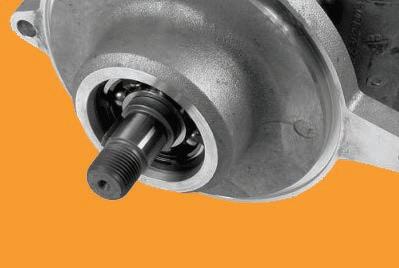































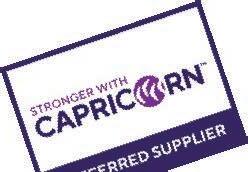
























































































Thanks to a specialist team, an entire herd of Asian elephants recently hit the road to be safely transported to their new $88 million purpose-built home.
BY DANIELLE GULLACI
IN one of the biggest moves to ever be undertaken in the history of Zoos Victoria – both in terms of its complexity and the sheer size of the animals – all nine of Melbourne Zoo’s Asian elephants have been welcomed to their new home at Werribee Open Range Zoo.
Elephants have called Melbourne Zoo home for the past 160 years, so this move to their new habitat was quite the momentous occasion.
It took around two and half years of meticulous planning, including crate training for the elephants, to see this come to fruition.
e logistics team was made up of many, with Linfox and Membrey’s Transport and Crane Hire tasked with the logistics of moving the herd from Melbourne Zoo in the city’s inner north, to Werribee Open Range Zoo, around 40 kilometres away.
ey were assisted by the 21-strong team of elephant keepers, a team of veterinarians, the Department of Transport and Victoria Police.
ree moves took place across ve days, to get the entire herd to their new $88 million habitat at Werribee Open Range Zoo. e impressive 21-hectare space is the size of the entirety of Melbourne Zoo.
e space has been thoughtfully designed to replicate the elephants’ natural habitat, complete with huge open spaces to roam, deep-water pools, mud baths and more.
Leading the on-road convoy for each of the three moves was veteran truck driver Mick Best, 75, who is no stranger to transporting these incredible gentle giants. Working for Linfox since 1992 – along with a threeyear stint with the company
back in the 1970s – Mick has seen and done some incredi ble things across his long ca reer, but he says this project was de nitely a highlight.
Mick was involved in this elephant move from the getgo, managing Linfox’s in volvement in the project and serving as primary driver.
“I’ve done lots of amaz ing stu in my career – I’ve transported elephants be fore, moved gira es, worked on the Olympics, bush re and ood relief, which were all wonderful experiences – but this is by far the most rewarding project I’ve had the privilege to work on,” re vealed Mick.
Along with the move itself, Linfox was involved in pro ducing the specialised con tainers used to transport the elephants. “After Linfox was approached by Zoos Victoria to assist in the move, I met with the zoo to discuss their requirements,” said Mick. “ en we started the pro cess of converting eight 20ft containers to facilitate the el ephant move. ey were pur posely converted. One was made higher to transport the bull elephant, Luk Chai, and the others were converted to take the females and their calves together.”

Zookeeper Lucy Truelson is project manager for the elephant herd. She told Big Rigs, “We moved nine elephants and three were young calves – so the crates had to be built to support that, so the mothers and calves could travel together and have contact with each other in the crates throughout the entire move.”
To ensure the comfort of the elephants while out on the road, the containers were also air conditioned. “Ahead of the move, it took about six weeks to produce these unique air conditioning systems. We used a quarter of a shipping container for each, then attached a fridge mo-
I’VE DONE LOTS OF AMAZING STUFF IN MY CAREER… BUT THIS IS BY FAR THE MOST REWARDING PROJECT I’VE HAD THE PRIVILEGE TO WORK ON.”
MICK
BEST
tor onto them, sealed them up and had tubes going into the elephant crates so the air was continually recycled,” explained Mick. Mick took part in his rst big elephant move back in 2006. Eight elephant calves had been brought into Australia from Bangkok – part of global conservation e orts for Asian elephants that aims to nurture genetically diverse populations of the endan-
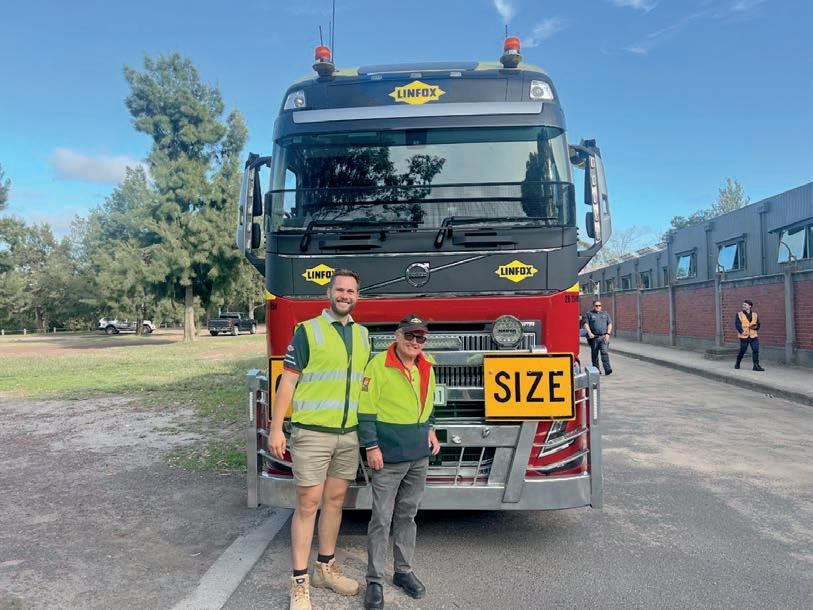
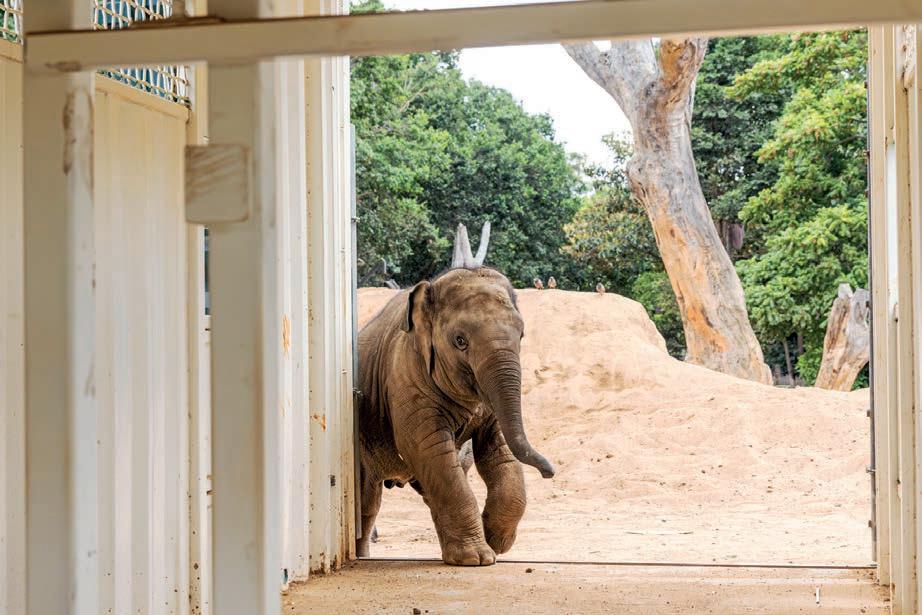


three headed to Melbourne Zoo and ve transported to Taronga Zoo in Sydney.
“ e ones we brought over from overseas were all babies and they’d been nurtured individually with their handlers for the entire trip,” said Mick.
Interestingly, the 15-yearold male bull elephant, Luk Chai – who was the rst elephant to be transported to the new habitat at Werribee Open Range Zoo – was born to one of those elephants at Taronga Zoo. He was transferred to Melbourne Zoo to take part in a breeding program, where he had very great success, fathering three calves.
As Lucy explained, “When Luk Chai joined our herd, there was a plan to breed him with three viable females.
females and a male.
“With elephants, if they don’t breed regularly, they can become infertile, that’s why it was very important to breed them at Melbourne Zoo before we moved. ey were all born within a few months of each other. It was also important to know that they’d be 1-2 years old by the time of the move, so they’d be old enough to be trained in the crates. e calves are now all approaching 1 tonne.”
As Lucy revealed, the idea to move the elephants to Werribee has been many years in the making, “We already had the land but we needed the funding – and it was a pipe dream until we secured that funding from the Victorian Government.”
e whole basis of the new
habitat was to replicate how elephants would live and behave in the wild. “It was about going back to nature and looking at how elephants thrive – and that’s in a multi-generational matriarchal herd unit,” said Lucy. “All related females remain in the herd, with the matriarch being the oldest female – in this case 52-year-old Mek Kapah who weighs around 3.2 tonne. All the females then play a part in raising the calves. en the males move between herds.”
With this in mind, Luk Chai was brought to his new home by Mick and the Linfox team. Weighing in at a whopping 4.28 tonne, he is the heaviest in the herd.
Bringing him in rst was a deliberate decision. As a solo bull, it gave him the opportunity to explore his new habitat on his own, before

the rest of the herd followed. en two days later, the next group was transported – a mother and calf in one crate, and another female elephant in the other. en another two days later came the nal move, where two mothers travelled with their calves in two of the containers, and the matriarch Mek Kapah in another.
Linfox compliance manager Michael Stephenson worked with the relevant road authorities and road managers to obtain travel permits for the transport task.
“ is was a really coordinated e ort. Everyone was really focused on getting it done, and getting it done as safely and smoothly as possible. It’s not your usual oversize container move. Luk Chai is a big boy and the total combination ended up at 4.4 metres high,” he said.
“We worked with the NHVR and Department of Transport to con rm the best route. You’d think moving elephants would be a nerve-racking process, but the way it was all coordinated across all the teams, was just incredible and the move went smoothly.
“And when it came to moving the mothers and calves, we could see on the cameras that they were holding trunks.”
e elephants were transported by three Volvo FH prime movers, with three drivers involved. For two of the drivers, it was their rst

time working with Zoos Victoria. “ ey hadn’t been involved in zoo moves before but found it really rewarding – to get them all there, and to see the elephants all together, mixing in their new environment,” said Mick.
e team from Membreys also travelled in convoy with the trucks, keepers and police escorts, to be on hand in case there were any hiccups.
But thankfully, it all ran smoothly, with everything precisely coordinated down to the nest details.
VicRoads even assisted with tra c light control, to ensure that by leaving at the prescribed time, the vehicles would have green lights for the entire journey.
“A lot of work went on behind the scenes,” said Mick.
“It was one of the most professional teams I’ve ever had the privilege of working with – including the Linfox team, the zoo team and Membrey’s. To work with that group from the zoo, they just live and breathe their work.
It was an amazing sight.
“ ey had cameras in each container, and the person sitting with me in the truck was watching the elephants the whole way and letting me know they were all okay.”
Mick also spoke of the heartfelt moment when the elephants were reunited, “It was extremely emotional for me to see all the elephants back together in their new enclosure. A lot of us couldn’t look each other in the eye!”
e elephants will now be
given some time to explore their new space before the habitat is opened to the public. “ e elephants have settled in beautifully. We stand there and are in awe of them,” said Lucy. “It’s quite a thrill for all of us to watch them as they discover all these new spaces. ey’ve moved like a herd of elephants would in the wild, with matriarch Mek Kapah leading the herd through the landscape.
“And for Mek Kapah, what a journey she’s been on. She was brought into Melbourne Zoo as a young female in 1978. We’ve learnt and grown this herd around her. It’s an incredible sight to see her in this expansive environment, grazing on grass with all these calves around her – that’s exactly how it should be!”
e new larger space will also give Werribee Open Range Zoo the chance to continue to breed the elephants and grow the herd.
“We have our beautiful bull elephant Luk Chai, who will be able to wander in and out of the herd – and we can see biology run its course,” added Lucy.
She also praised the e orts of the logistics team. “It took a whole team to make this happen. e empathy and the care everyone showed for the elephants is something we’ll never forget. We are so grateful,” said Lucy.
“It was a highlight for everyone in this team to be involved in such an incredible event.”

Our Victorian correspondent strikes trucking gold when he heads to one of Australia’s most original mining towns for the weekend.
BY GRAHAM HARSANT
RECORD attendances at truck shows seem to be the norm so far this year and Clunes in Victoria was no ex ception, the grounds chock-ablock with a massive variety of brands on show.
Clunes Historic Truck Show for vehicles 25 years or older on March 9 o ered no awards, but similarly to Lance eld, was an opportunity to just park up and chat to other truck owners and interested members of the public.
ere’s an old Mack Elite amongst the throng with Av oca Transport painted on the doors, along with the name Steve Gleisner.
Steve’s father bought Avoca Transport in 1948 as an al ready established business. e Elite is now owned by Steve’s son, Fred, who also turned up with his 1966 B61.
On the Elite, Fred said: “Dad passed away two years ago from cancer, and I wanted to keep his name on it as a trib ute. At the time I had a West ern Star, which was a pretty good truck, but running two was not an option so I moved the Star on and this is my daily drive now.
“ e shed on the Western Star was a bit bigger, but I’ve still got 50” in this which gives me a lot more space than the Euros – important because I travel everywhere. It’s also a bit lighter and better on fuel.
e truck is a 1998 model, which was around the time Mack went from Renault to Volvo ownership.
“ e Elite name means it is all Mack running gear – engine, gearbox and di s. e old man bought it when it was about three years old and put 2.8 million km on it without


a spanner touching it. It was a Wednesday truck for sure.
“When I decided to use it as my daily it was getting long in the tooth, so we did a rebuild, which turned out to be a Friday job, unfortunately. It was back to the drawing board and now she’s pretty reliable again.
“I go everywhere in this truck. It’s been to every corner
of Australia since I’ve had it over the last three years. Darwin, Townsville, Perth and not just once either. I told you I do a bit of everything.”
As well as the Elite, there’s that 1966 B61 with a 25C motor, quad box, Mack tandem drive and camelback rear end.
“I’ve had it about 18 years, and it’s been a toy; I’ve never


worked it. e previous owner used it as a farm truck out of Beaufort. It’s been a good toy and has kick-started a lot of conversations.”
Fred drove the old B61 the 100 or so kilometres to Clunes which is a feat in itself, given he was just a week out of hospital, where he’d spent three weeks.
“ at gave the guts a bit of a workout but we made it here. I’d had few stomach pains going on; actually, I was in the truck when I pulled up at Cooper Street BP and called an ambulance.
“I ended up in hospital and got diagnosed with stage IV cancer. I’ve just had a big section of my bowel removed two weeks ago and I’m looking at probably starting chemotherapy in four weeks. I have it in my liver as well so hopefully the chemo will take care of that.
“It’s a bit of a shock to the system to nd out that what you think is a belly ache is so much more.
“I’m 36 this year and it
wasn’t quite the news I expected to hear. But anyway, I’m staying positive. I have ve kids – I made the most of being at home when I wasn’t in the truck.” at Fred can have a laugh given what he’s been through shows his positive attitude towards his treatment and the future.
We at Big Rigs and we’re sure all our readers wish you the best of luck, Fred.
Clunes was a welcome change for the Cornwill brothers who are known throughout Victoria and beyond for their award winning T908, ‘Paradise’ and more recently their Legend #59 SAR, ‘Dynamite’. is time however, those trucks stayed at home, with Wayne Cornwill opting to bring an ‘old banger’ to the show.
“She’s just an old 1978 Kenworth K123 Slimline with a 400 Cummins and 15 overdrive,” said Wayne.
“We actually bought it some 10 years ago for the motor which we were going to transplant into another truck. But there was too much history in it so we put it on club plates and bring her out on the odd occasion. She’s here obviously, and we’ve taken her along to Castlemaine and Koroit as well.”
Wayne was the solo occupant of the truck on the drive up from Geelong.
“ ey were all scared to get in it because of how rough she is bobtail. Our mate, Fingers reckoned he wasn’t going anywhere in something that wasn’t air-conditioned. One hundred k’s per hour and wind the windows down and you get a bit of air in the cabin!”
Wayne commented that Clunes was probably one of the best truck shows he’d attended: “I’ve been able to spend the day chatting with folk instead of washing and polishing.”
Continued on page 20














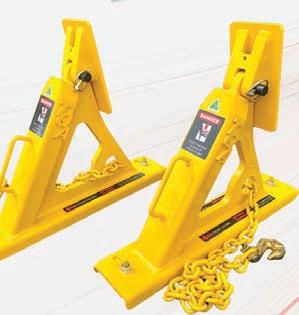
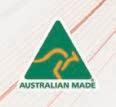








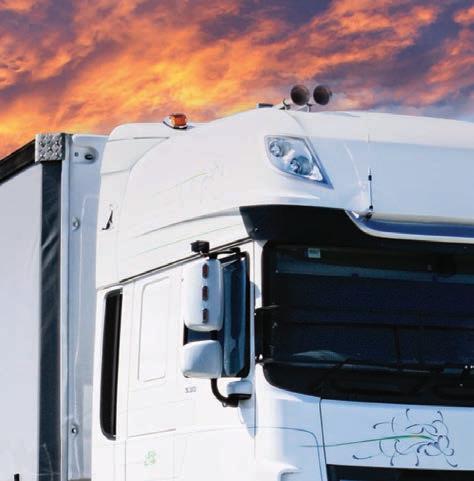







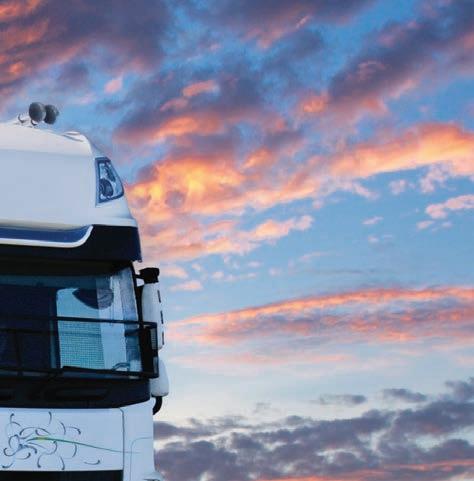





From page 18
BILL Fitzpatrick was a legend down Charlton way and sadly passed away last year.
His last drive, a 2000 Kenworth cabover, showed up at Clunes, courtesy of his sons, Billy Jnr and Paul, along with grandson, Murphy.
“ is was the last truck that the old man drove, and we thought we’d bring it to Clunes so people can remember him.
“Ten years ago, we’d sent him to an auction to buy a stock crate and a T650 Kenworth, and he came home with this truck for himself.
“He didn’t worry about us. We asked about the one we’d sent him to buy and he replied that it wasn’t any good. Yeah, right!
“He worked it right until the week before he passed away. He was getting pretty old and doddery but at 91 he was still working. Mum tried to get him out of the truck on
more than one occasion but he wouldn’t listen to her.
“He didn’t listen to us either. He did what he wanted to do; he had learned to never listen to his kids.”
Will the truck stay in the family? “We reckon Murphy’s got his eye on it, so yes, it probably will.”
I walked past Bert Fagan’s truck and he asked me if I knew what it was. I said Dodge and he said no. I said an International and again he said no. Which goes to show how much (or otherwise) I know about trucks.
“It was built by Bill Norling of W&H Norling Engineering back in 1977 for Pakenham Blue Metal as an agitator.
“Bill’s son, Craig Norling told us that his dad only built six of them and this is number one out of the six.
“It has a di erent chassis to
an International although it’s made up of Inter stu . It used to have a Dodge bonnet and it did have a D line grill but I changed that because I don’t like ‘em. It has power steering, and a 653 GM. It’s an Alison automatic with a three speed Joey box and bogey on Hen drickson at the back.”
Bert has owned the rare beast for seven or eight years.
“If International got an or der from the truck and they couldn’t handle, it they would handball it on to Bill Norling to do the job.
“Originally it had a Norling badge on it but I never got it. A friend of mine has one for me which will be really cool. It is similar to a Chevrolet badge.”
is is a little part of history that few people in the indus try or out of it would know about.
And that’s the great thing about truck shows such as Clunes. You’ll always nd out something new.
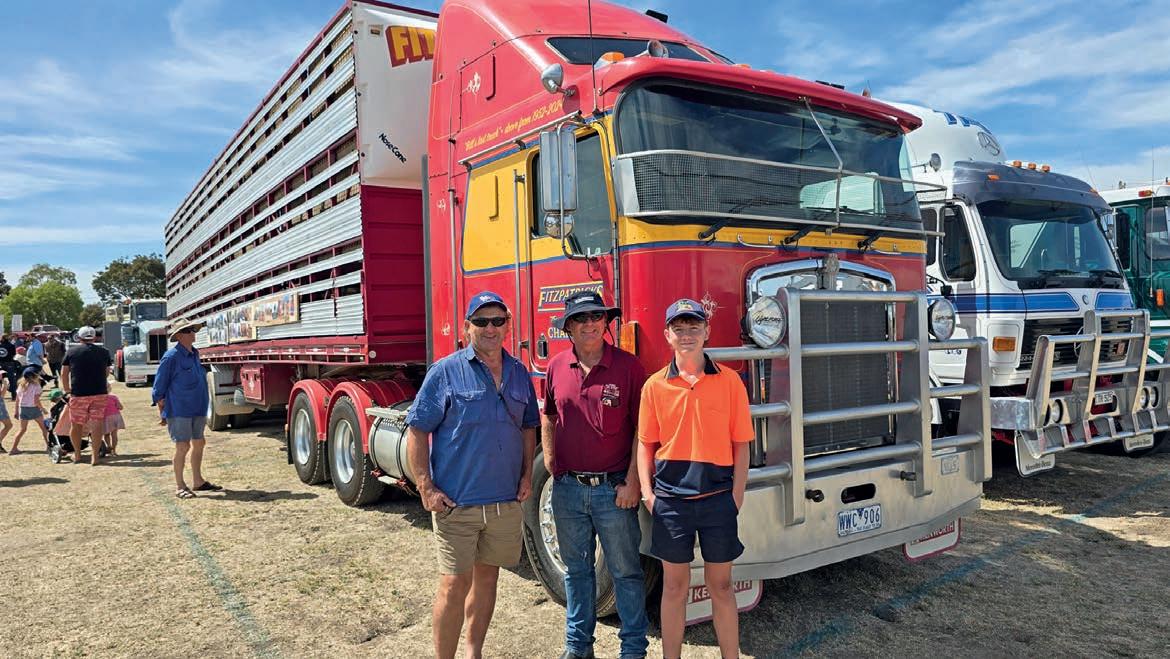
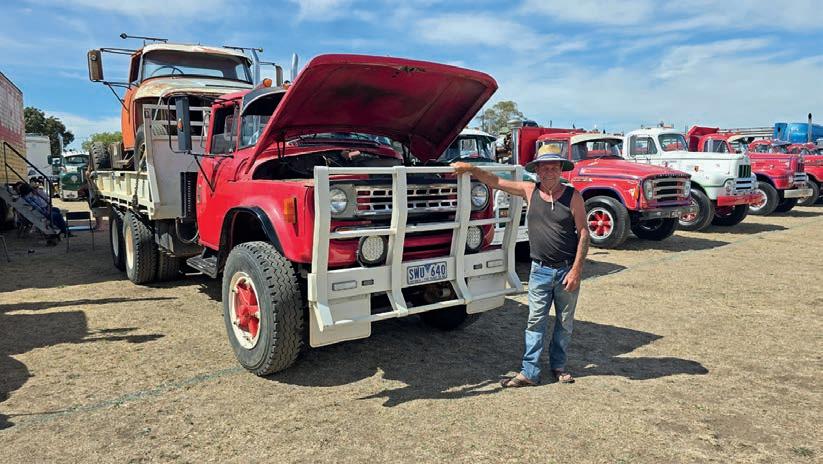



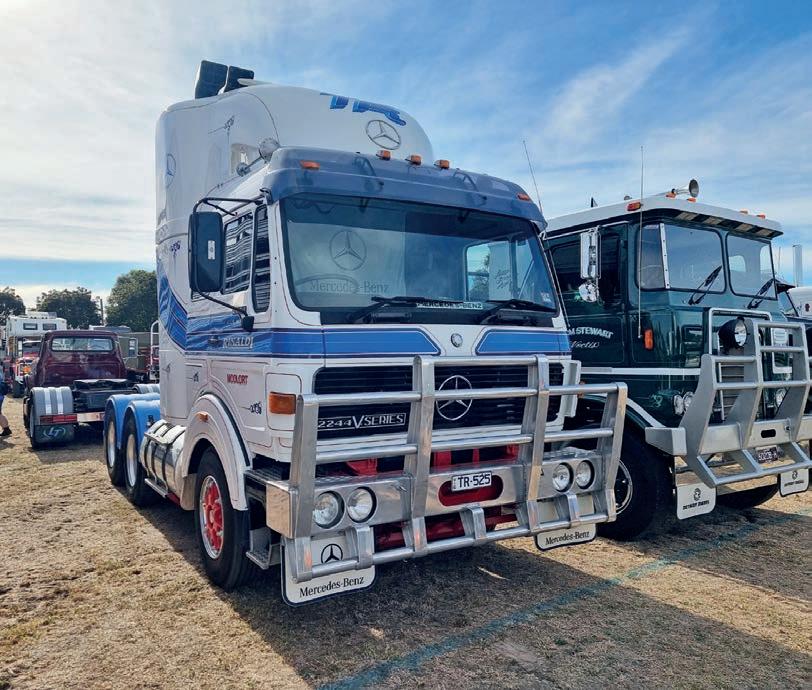




MAXIMISE YOUR PROFITS WITH COMPLIMENTARY SERVICING FOR 3 YEARS.*
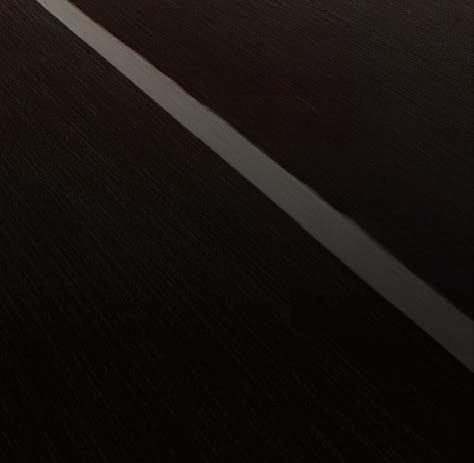




Start hauling with your new Cascadia knowing you’re already ahead, with complimentary Complete Servicing for three years or 450,000km (whichever comes first). Plus enjoy class-leading fuel efficiency, cutting-edge safety technology, and the ultimate in driver comfort. Available on selected models for a limited time.


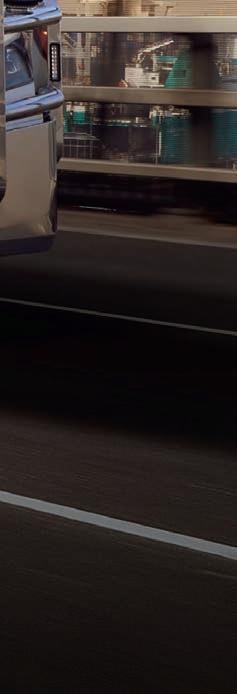



It was the end of an era at this year’s event in Kyabram. Now everyone’s hoping someone will step up to take over the wheel.
BY GRAHAM HARSANT
RAY and Michele Grima insti gated the White Truck Muster at Kyabram, Victoria, 20 years ago. After 10 events Ray has had enough and feels that if it is to continue, others can step into the breach.
No one can argue that Ray has not given his all to the event.
“ at very rst Muster was done in conjunction with ATHS Australian Chapter, and was, in fact their rst event and the rst ATHS event any where in the world, outside the US,” said Ray.
“Now they have come to our aid again by e ectively staging this year’s show which allowed us to go ahead under their public liability insurance um brella, without which we could not have gone ahead.”

e American Truck Histori cal Society (ATHS) is seriously considering taking the White Muster into the future with a small sticking point being its timing – only three weeks after their Lance eld show.
We shall wait with bated breath because the White Muster has become a staple on the truck show circuit.
Ray has done a wonderful job over the past 10 shows, drawing people from near and far. “It brings people from all around Australia and around the world. ere are a lot of White tragic’s out there.”
One such tragic is Werri bee-based Craig Collins who owns CRX – Collins Road Express and brought along his mint 1980 Road Boss which has an interesting background.
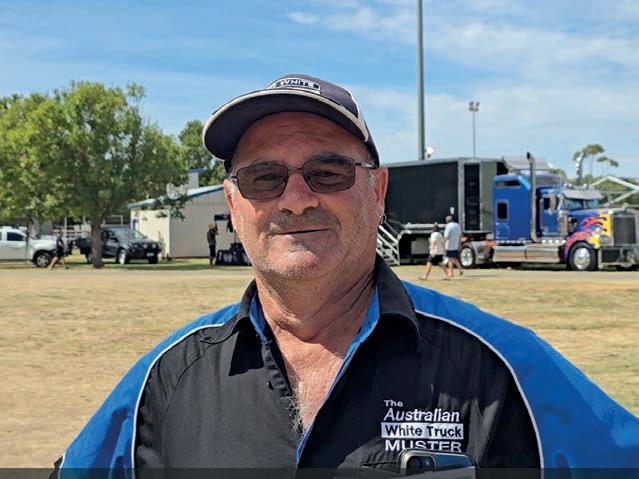
“It had a 290hp, 12.7-litre Rolls Royce engine in it – one of only nine, I’m told,” said Craig.
“Apparently, they may have had some in Road Commanders as well. Originally we think it was a Caltex fuel tanker.
“I was using it every day with that motor for four or ve years but I couldn’t get parts for it. I’m a Caterpillar man so I repowered it with a 3406C PEEC. It’s a later model engine and I like the cruise control part which makes for easy driving with the super 10 overdrive.”
Craig’s had the truck for 30 years. “I bought it from John George’s at Campbell eld. He was selling up and moving his eet on.
“It was pretty much a wreck, and I just built it up over quite a few years. It had already been stretched by John George and had a tray on the back until I got the taught-liner built for it.”
Along with the Road Boss, Craig has two prime movers and CRX made a living delivering anything from clothes to toothpaste for K-Mart, Myer and Target to their country stores, with the prime movers hauling steel or anything else in between.

“ is truck hasn’t done much for the last 3 or 4 years as I’ve slowed down a bit and become semi-retired. I like taking it to truck shows like this and Castlemaine and Alexandra where it has won Best Rigid – not bad for an old girl.”
Craig was joined at e Muster by his mate, Andrew Senkinc who owns a 30-year-old Sprint Car daubed with Craig’s business colours.
“It’s a Buckley chassis, midbar and goes in vintage races,” said Andrew.
With a 360 cubic inch Chevy motor at 650Hp and weighing only 850 kilos, she has a pretty good power to weight ratio. And before you

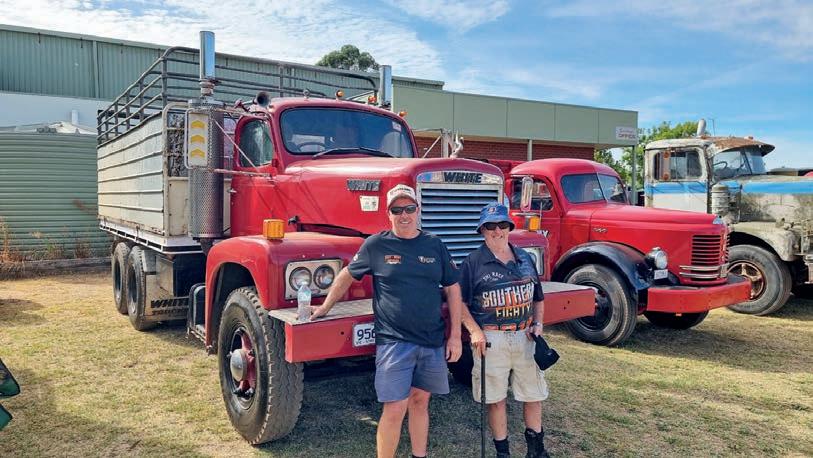
ask, no, it doesn’t travel in his taut liner. He’s too tight to buy ramps.”
Yes, we know you’re only joking, Andrew.
TJ featured in a recent story on the Koroit truck show, with his Mack Muncher, so it was a surprise to see him at the muster with not one, but two Whites. To be more speci c, they belong to dad, John, or Spud as he’s known to friends.
“We wanted a farm truck,” said Spud. “And we found this old girl [a 1966, 2300 model] at a wrecker’s for $5000.
“Like TJ I’m a KW fan, but Kenworths are too good to be paddock wagons! Seriously
though, this had been sitting for 12 months, we hopped in, and she red right up.
“We’ve had her for 20 years now. Flick the isolator and she just goes. e poor thing gets ogged to death moving cattle, hay or silage.”
Spud res the truck up and the 653V motor is as sweet as new. He points me to the pedals in the cab and the brake pedal is bent at a 45 degree angle at the retaining pin.
“ at’s because it’s the accelerator, not the brake,” he tells me. e brake pedal in on the right-hand side.
“So, people get in it for a drive, forget it’s in the middle, go to brake and speed
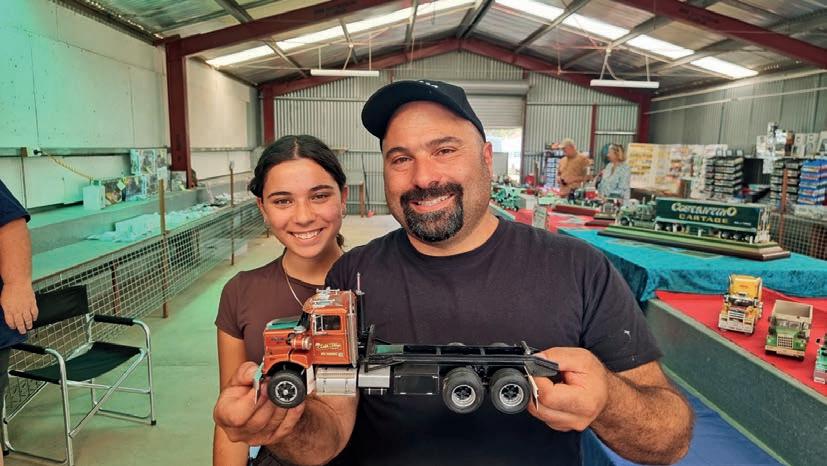
up instead. ere they are standing on the ‘brake’ and going faster and faster. It’s a great laugh!” eir other White is an exK&S that also came from a wreckers – this time for the princely sum of a semi load of hay.
A late 60s model, TJ and Spud cleaned it up and she sits in the shed beside e Mack Muncher.
Spud went on to tell me a story of driving a Kenworth B-double from Campsie way, through Sydney and on to Warrnambool without a clutch.
ere’s a man who can drive a truck!


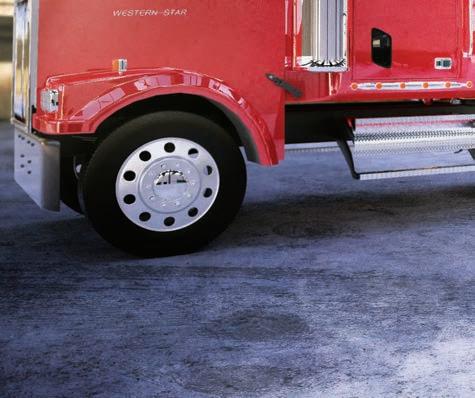
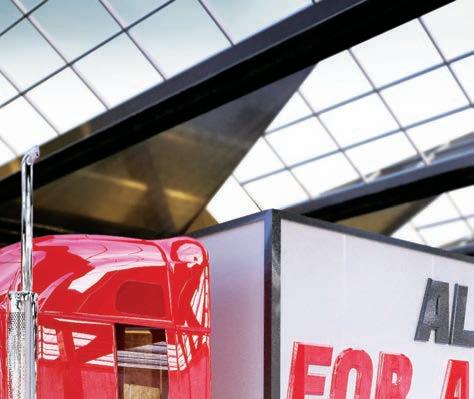

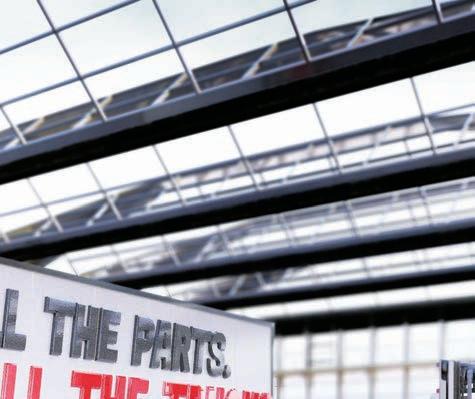



























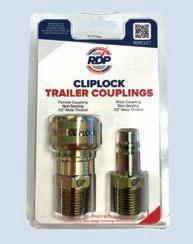










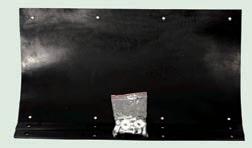






SLOW payments by some clients are having a devastating nancial impact on many owner-operators and small eet companies.
at has been expressed to Spy by a lot of drivers in the past six months as cost of living expenses across the board have skyrocketed.
A ected operators still have to pay their fuel and other costs on time or face being denied access to them.
Veteran owner-operator Col Wallace was one of the drivers I interviewed recently and he was critical of slow payers.
“ ere are many clients who are slow payers and that has been on the rise in the last six months. Some haven’t paid for three or four months,” Col said.
Other drivers have told Spy they often wait three to six months after delivering freight or equipment.
A serious incident I heard of was from an owner-operator who was owed $13,000 by a client who he had considered a friend.
is client didn’t answer the phone as the debt was being chased and when the driver nally tracked him down, it

didn’t have a positive ending.
“I was told he had no money and was going bankrupt,” the driver said.
Drivers also say it is almost a mission impossible to get clients to agree to a rate increase after fuel costs rise.
Often clients will shop around and accept another operator at a lower rate.
Looks can be deceiving
On the positive side there are many clients who do pay on time, as one NSW driver divulged.

“I have regular clients that I have carried for over many years and they always pay within seven days,” he said.
Now this lad is certainly in the millionaire category but you wouldn’t know it by looking at him or his old truck.
“I don’t drive around in a shiny big new truck and deliver to most parts of Australia. I do very well, but really don’t want it common knowledge. People get jealous,” he said.
He reckons that if people think you are well o some will want to borrow money.


“Looks can be deceiving,” he
The eagle has landed at SA roadhouse
Former truck driver Neville Jacob knows what other driv ers expect when they stop at his Cadney Homestead Road house in South Australia.
Several truckies told Spy they like stopping at Cadney along the Stuart Highway, 150km from Coober Pedy.
So Spy phoned the roadhouse and spoke to Neville who said on average about 20 trucks a day pulled up there.
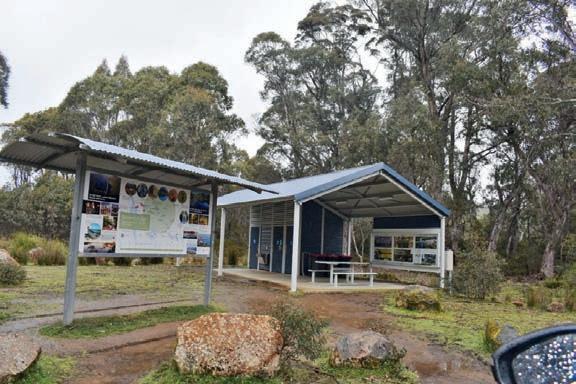
e roadhouse has toilets and showers for truckies which is welcome in such a remote area.
“We have parking for about 15 heavy vehicles and the drivers like our rump steak during the day and night, and bacon and eggs for breakfast,” Neville said.
More than 20 years ago Neville drove road trains between Adelaide and the NT and has fond memories of it.
“A lot of the drivers who come here are on the Adelaide to Darwin run but some are from Melbourne. Many of them carry refrigerated goods or general freight but some
camel haulers also park here,” Neville said.
One of my many contacts sent me a pic of the exterior of the roadhouse which features a painting entitled ‘ e Eagle Has Landed’.
Neville explained the origins of the mural. “A woman from a nearby station painted it and it is a big attraction. A lot of big wedgetail eagles inhabit around here.”
Derwent Bridge rest area
ere is a nice little rest area to stop brie y at near the Derwent Bridge, located along Tasmania’s Lyell Highway. It is roughly midway between and Hobart and Strahan which is a 300km trip. It has limited parking for heavy vehicles especially if a lot
e road transport industry is in Neville’s blood and I was not surprised to be told he had an old truck stored in a shed out the back. “It is a 1987 Superliner but isn’t registered,” he said. e roadhouse is open from 7am to 8.30pm and as an added attraction there is a swimming pool.
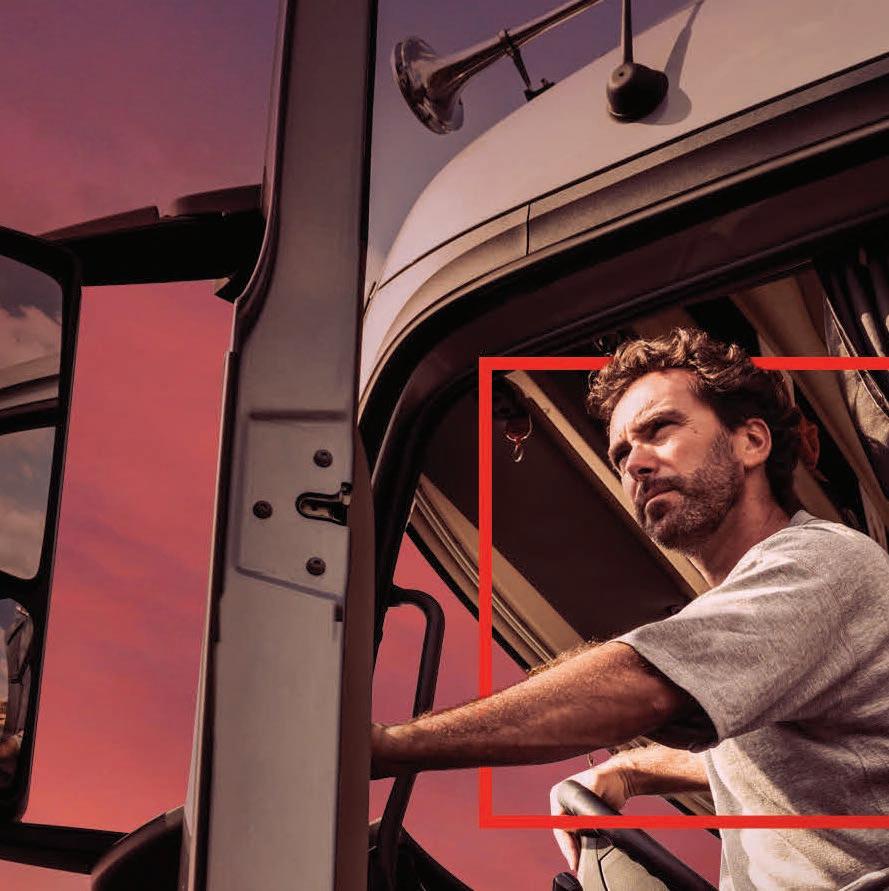











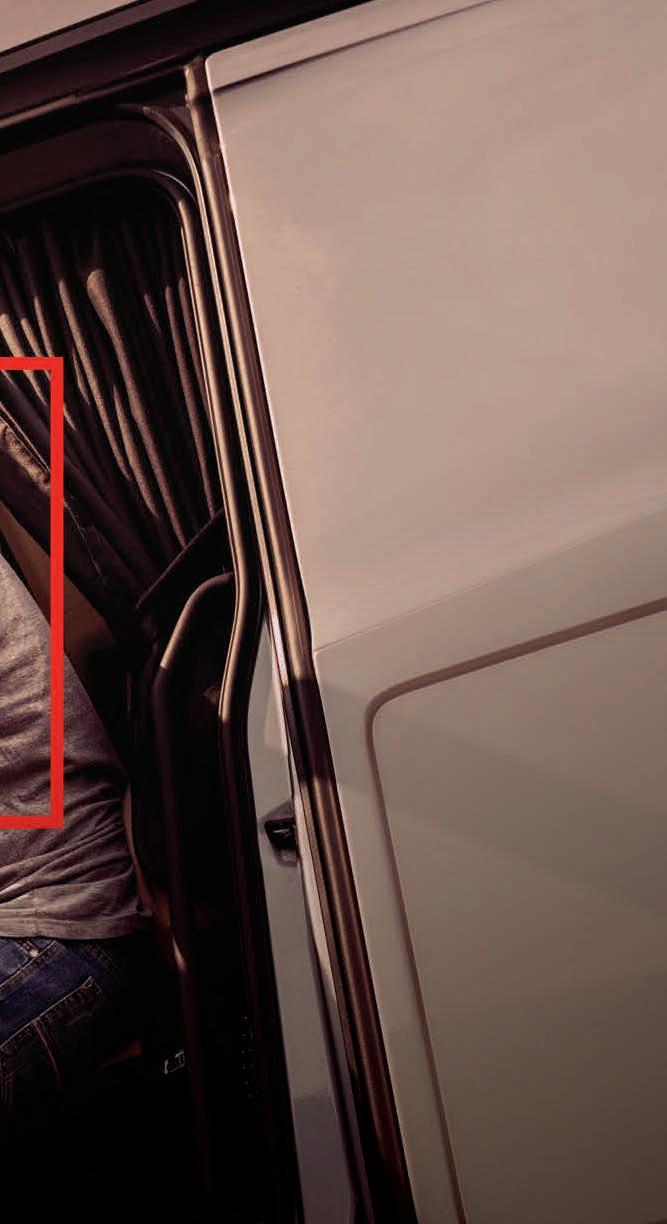
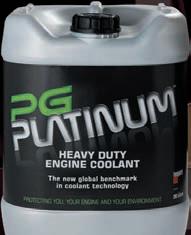









of caravans and other motorists are there.
It does boast tables and chairs under shade and toilets which are popular.
Earthquake shakes drivers
Truckies in Townsville had scary experiences when a magnitude 4.4 earthquake struck.
e earthquake shocked residents at 9.30pm on Saturday, March 1, when it shook homes.
Power went o to thousands of houses for a short period after the quake.
Several truckies who were snoozing in their sleeper boxes at roadhouse parking areas on both sides of town told me of their experiences.
“I thought a bomb had exploded or a vehicle had crashed into my truck,” one said.
e quake was traced to a depth of 10km and whilst the tremor lasted just a few seconds, it horri ed many residents.
From crab pot to gas cooker
A truckie who loves seafood is the envy of road transport colleagues in Sydney because of his ability to catch mud crabs whilst in North Queensland.
e lad does a regular overnight run between two coastal towns and spends a night in
his sleeper box at a roadhouse parking area.
It is located a few hundred metres from a creek where our man sets up a crab safety pot.
When he arrives back there the following afternoon he checks the pot and often nds a large male buck crab inside.
After placing the crab in his fridge freezer to euthanise it humanely, he boils water in a pot on his gas cooker.
When it boils the crab is placed in the pot and cooks perfectly in about 15 minutes.

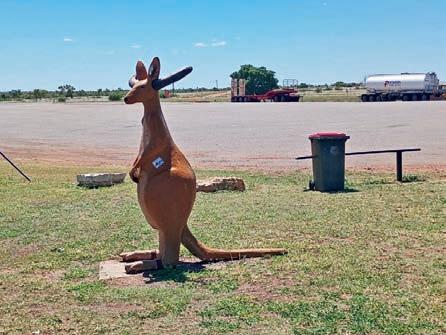
I am told the aroma coming from the cooking process really tantalises the tastebuds of drivers parked nearby.
He even brings back a small bucket of salt water from the creek to add avour.
Many of his seafood connoisseur mates in NSW are full of envy because of the exorbitant price they have to pay to buy a cooked mud crab at a market.
In the outback Queensland town of Camooweal, which is 12km from the NT border, you some across a strange looking statue.
For decades it has been located near the local roadhouse and is referred to as a Bullaroo or Bu aroo.
e story around it is that

many years ago in a ood a female kangaroo mated with a male bu alo or bull, which resulted in such a weird creature.
I rst did a story on it in the late 1980s when a lady named Aidan Day ran the roadhouse.
e story about how it all came about involved a painting done by an NT artist featuring a kangaroo which had either bu alo or bull horns.
At the time a policeman then based at Camooweal told me some tourists were scared to stop there fearing they would be attacked by a bullaroo or bu aroo.
Over the past few years numerous truckies have asked about the real story behind this gimmick.
Many truckies around Oz possess a wonderful sense of humour as was evident when tropical cyclone Alfred struck southern Queensland.
Cyclones are not funny in any shape or form but its name sure resulted in lots of comments blown Spy’s way.
Whilst those who contacted me were hopeful that nobody would be injured they took time to well and truly take the mickey out of Spy.
Because my Christian name is the same as the cyclone, I received calls and emails from numerous drivers.
One Tasmanian truckie phoned me with a big laugh as he said, “I hear you are blowing a lot of wind.”
A South Australian also thought his comment about me “passing wind” was quite funny.
A contact from WA joked about why a cyclone would be named after me.
One Brisbane driver contacted me with this, “I’m sure you have been teased about your name and the cyclone. We would have been a lot happier if cyclone Alfred had stayed away.”
Some of the other comments cannot be published in a family newspaper but I can certainly tell you they were witty.

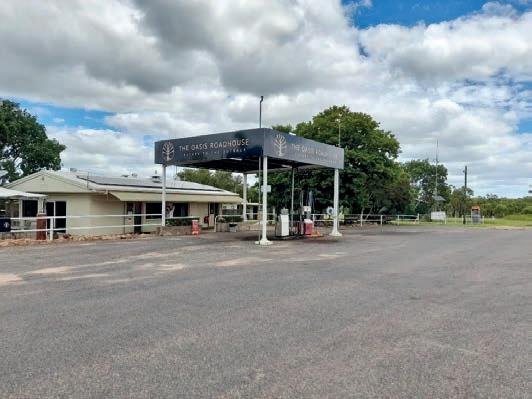
contacted me with the com ment of the week re the cyclone.
“You really have had an in uence as it is called Alfred and Lismore is a low lying ood zone on the banks of the Wilson River.”
Remote outback oasis
e aptly named Oasis Roadhouse near the end of the Hann Highway and close to the Lynd Junction is undergoing renovations which will result in a new eatery that will likely be popular with truckies.
For the past 15 months Josh Storey has run the Oasis which has ve employees including two chefs, Nick, and Frenchman Tim who hails from Paris.
“ ere are plenty of meals here for truck drivers including steaks and the big breakfast. We provide huge serves which are reasonably priced,” Josh told Big Rigs
NSW driver Ted Markwort stopped there in February and purchased a T-Bone steak with veggies.
“It was delicious and the sta were friendly,” Ted said. e roadhouse has parking across the road for heavy vehicles and clean toilets and free showers for drivers. It is open from 6am until 9pm and fuel is available 24/7.
“ e new eatery will be on a deck and we intend having Friday and Saturday night events there during the football season,” Josh said.
Another feature of the roadhouse is Australia’s smallest licenced bar in which just three people can t comfortably in.
Spy has been to the Oasis on many occasions but not for at least 10 years.
It was previously owned by the Royes family and before that by outback legend Bill Toohey.


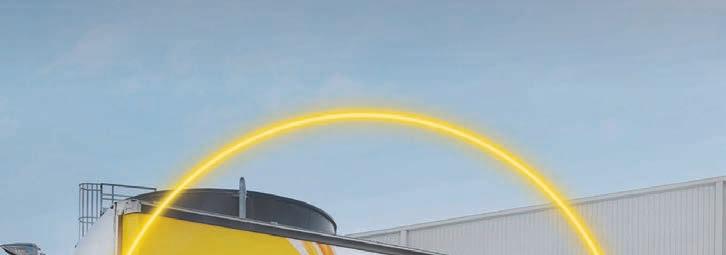
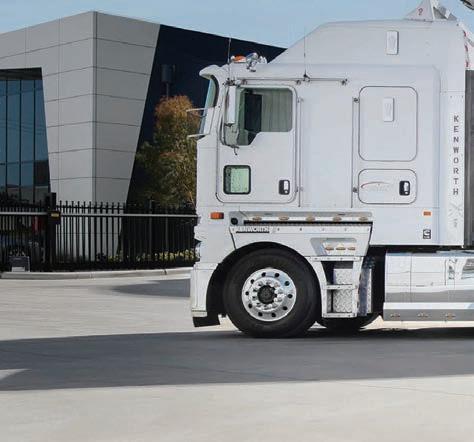
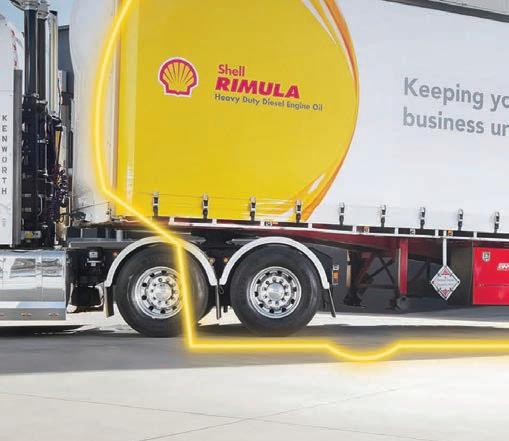








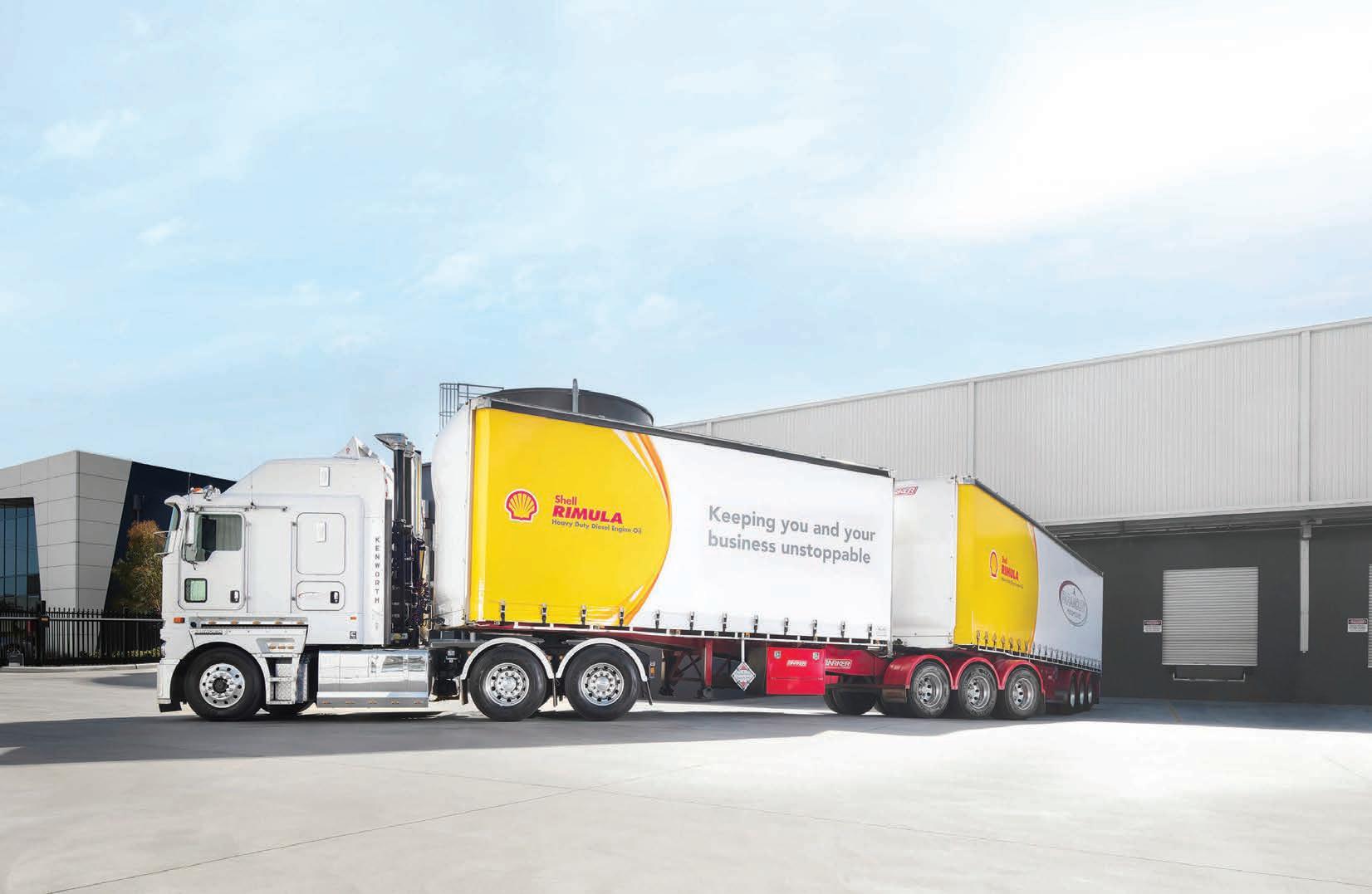

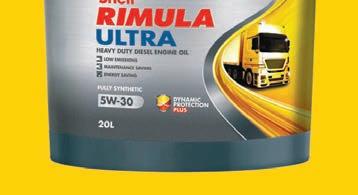

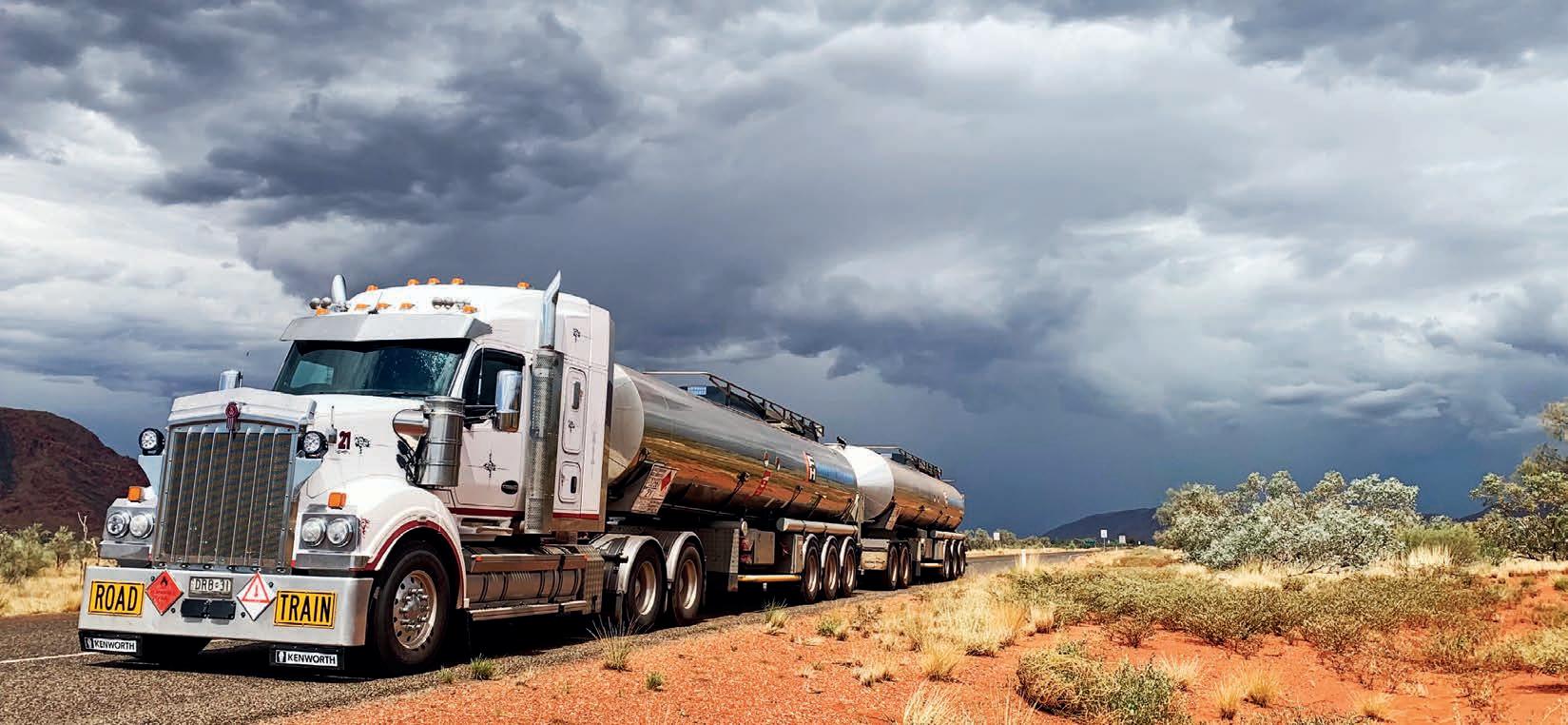
SHELL Rimula has partnered with Big Rigs in a big way – so there are even more reasons to send in your best truck shots.
Each month, the Big Rigs team will choose a #PicOfTheMonth, with the lucky winner receiving a $500 Shell Coles Express Gift Card.
Keep an eye out for our regular posts on the Big Rigs Facebook page, calling for your best truck photos and add yours
in the comments, or email them directly to senior writer Danielle Gullaci at danielle. gullaci@primecreative.com.au.
Don’t forget to include a brief note about the truck and where the photo was taken.
We’ll feature some of the best photos in each edition of Big Rigs, with one winner an nounced each month.
Keep those amazing truck pictures coming!
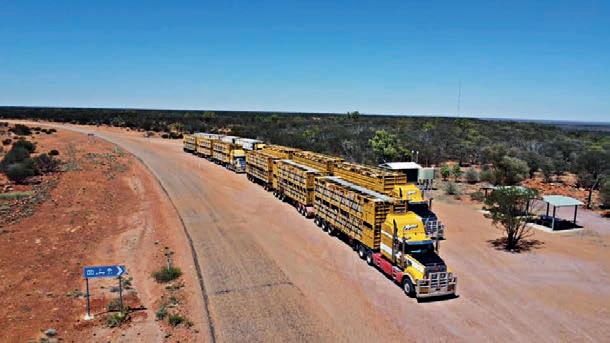
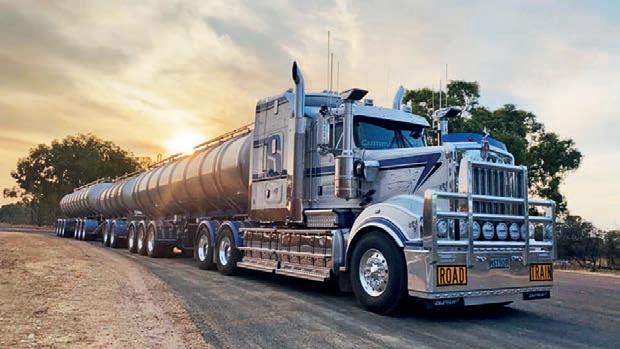





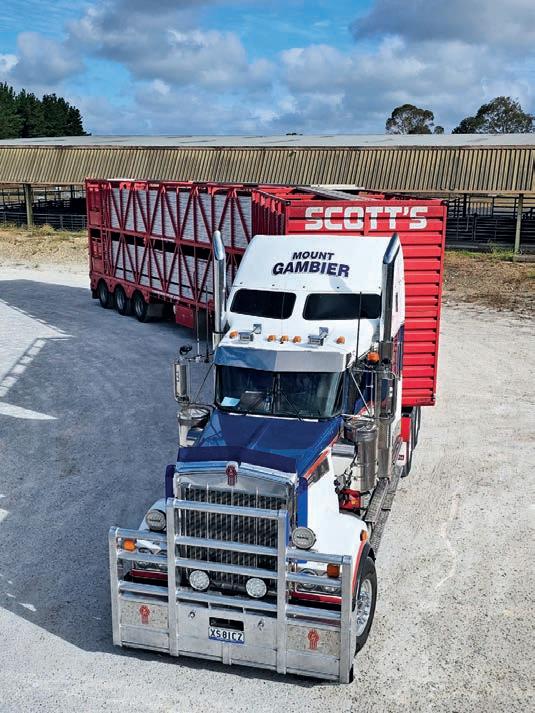
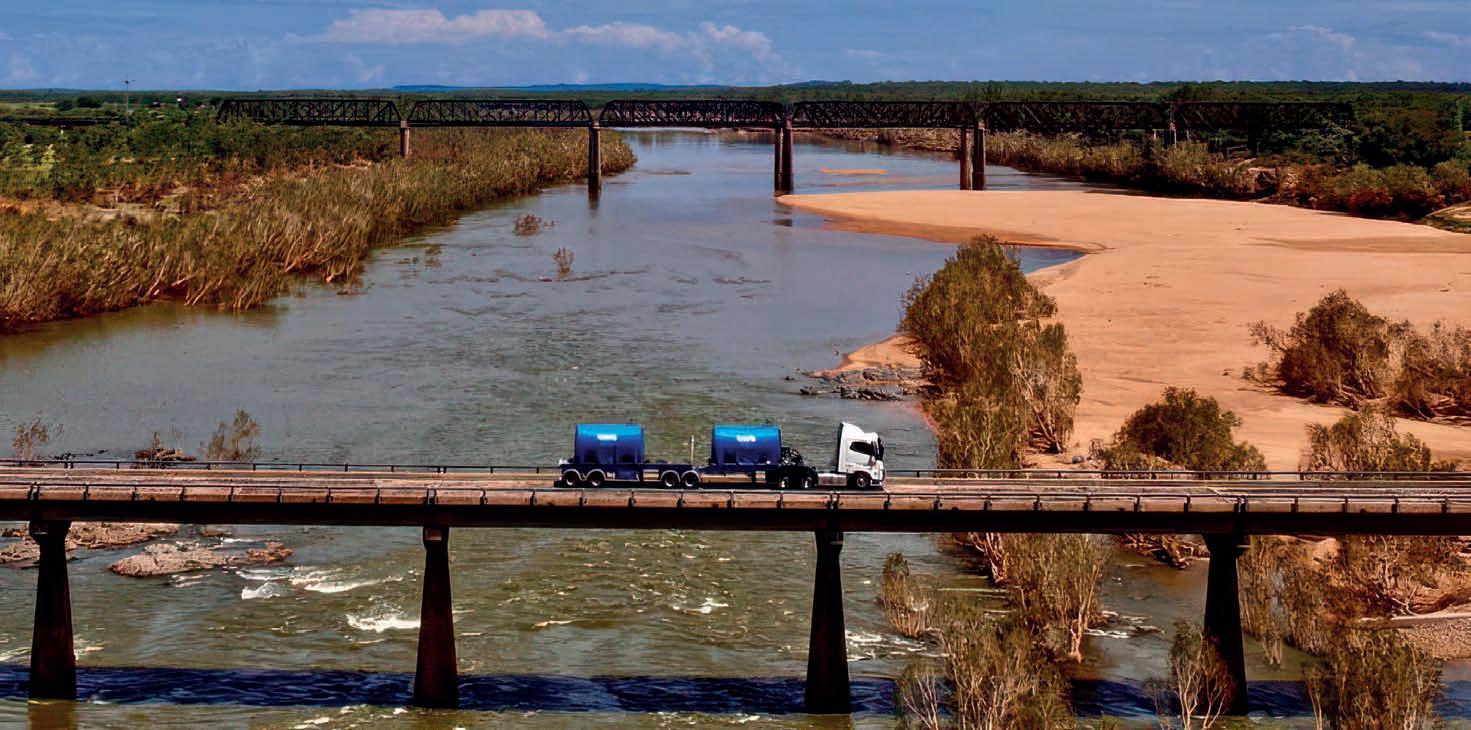

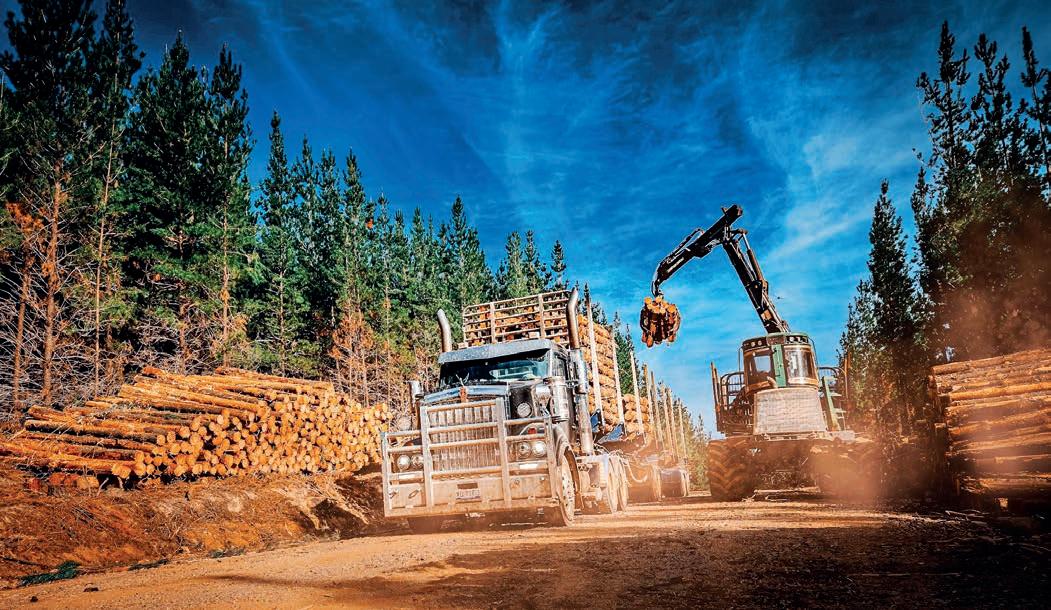

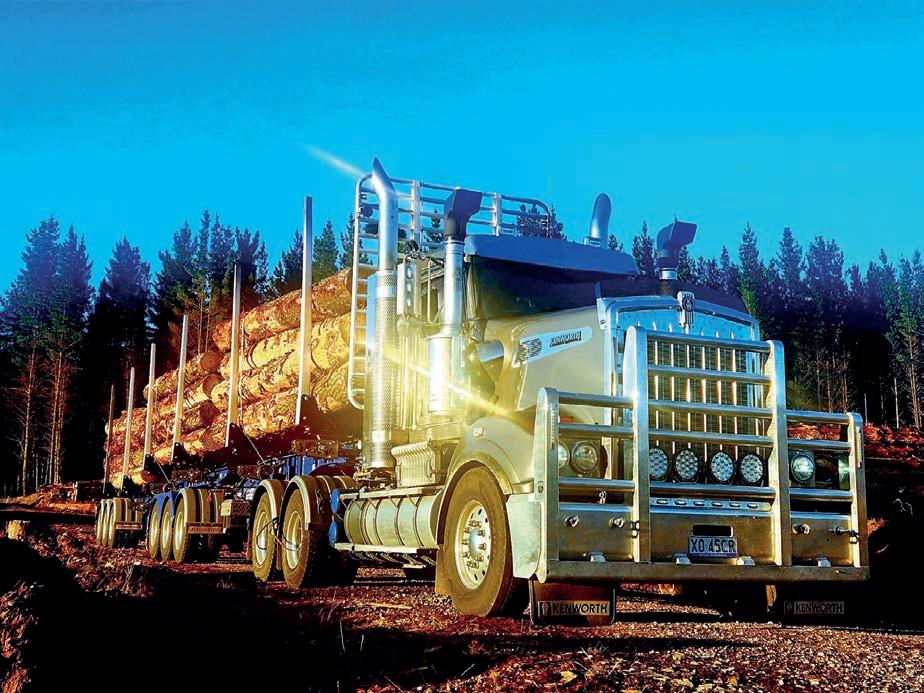
IN less than ve years, bespoke trailer manufacturer Robuk Engineering has grown from a three-man team to a sta of close to 60 people.
Based in the Port of Brisbane, Robuk designs and manufactures premium custom-built aluminium and steel trailers for the bulk haulage market.
A commitment to the highest quality standards and continuous improvements based on customer feedback has helped the brand develop a loyal following.
Robuk’s story began in June 2020, when James Yerbury started building his own trailers from a small shed in rural Queensland.
“ ere were just three of us in the beginning, and then orders started picking up. We quickly grew to a group of
12 employees, all living onsite during the week before heading home to our families on weekends,” recalls Darren Riedel, who has been with the company since day one.
With growing demand, the team soon needed a larger space. In February 2021, the business moved to its current site in Hemmant, which is now undergoing a major expansion. Stage one of the project is set to begin in early April and will be completed before the end of the year.
At Robuk, the focus has always been on evolving and improving.
“When we started, there was a huge boom in the grain industry, and we predominantly built grain tippers. Now, we’ve just passed 800 trailers in operation,” said Darren. volved in daily operations, whether he’s out on the work shop oor, travelling for servic ing, or working on new prod uct innovations. e close-knit team ensures that every trailer delivers reliability, quality, and value to customers.

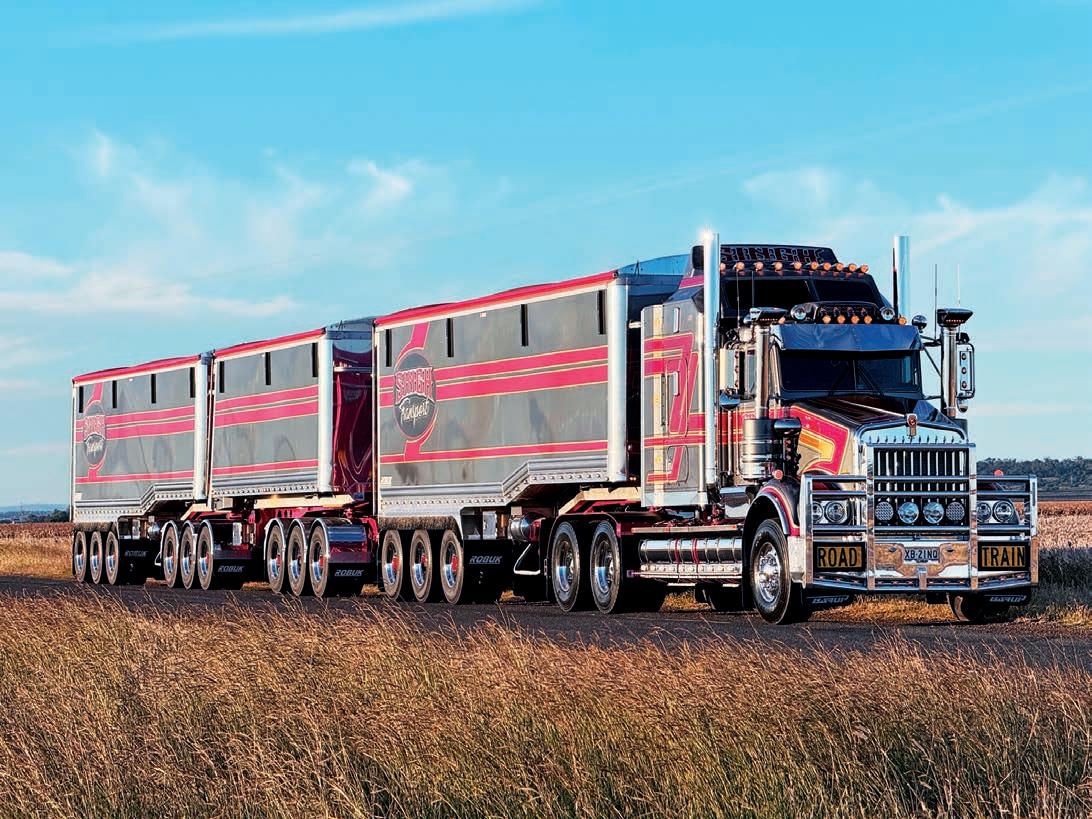
“ e expansion of our production facility will allow us to increase output and reduce lead times. With harvest coming up, we want to ensure we can get trailers to customers as quickly as possible. Speed to market is critical for us.”
Trailers and dollies carrying the Robuk badge can be found operating across the eastern seaboard, from Townsville to
dangerous goods trailers for mining and explosives, moving oor trailers, side tippers, and high-volume side tippers for the waste and mining industries.
To support continued growth, Robuk has strengthened its team with new hires across all areas, including workshop sta and sales representatives.
Matt Huigens, who joined the sales team in early 2025, highlights what makes a Robuk trailer stand out: “It ticks
service and after-sales support, and that is re ected in the loyalty of our customers.
“We’re always improving our trailers by listening to our customers’ needs.”
Jeremy Glover, who is based in Victoria, shares the same commitment to putting customers rst.
“Providing ongoing support is just as important as delivering a high-quality product. We make sure our customers feel supported long after they take delivery of their trailer.”
Ensuring top-tier quality in turing process, Robuk also
“We put a lot of trust in our suppliers because it’s the Robuk name on the side of the trailers,” explained Darren.
“For example, we predominantly use Hendrickson axles – a choice largely driven by customer preference. ey provide a reliable product and excellent service, which aligns with our values.”
With new innovations on the horizon and an ever-growing commitment to customer satisfaction, Robuk continues to evolve – always listening, always improving.

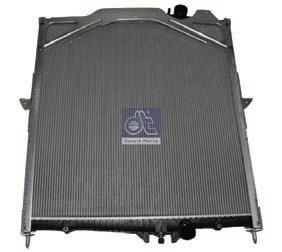


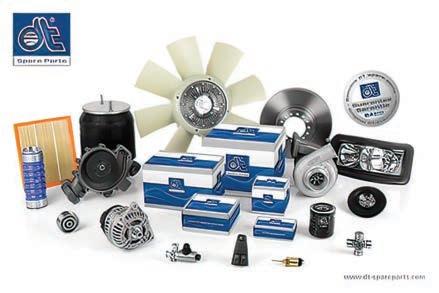




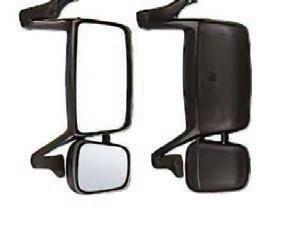



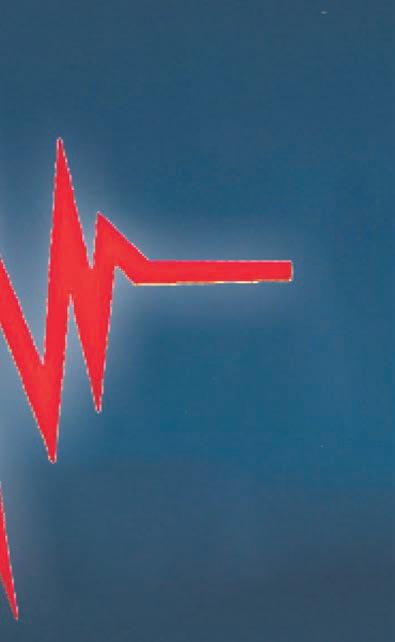











WITH over 150,000 parts across 30 product groups, SAMPA delivers one of the most comprehensive selections of commercial vehicle components in the industry. Our extensive range includes suspension systems, drivetrain components, fth wheel assemblies, air springs, landing gears, and much more – all engineered to meet the highest industry standards for durability and reliability.
From heavy-duty trucks to light commercial vehicles, SAMPA ensures that eet operators and distributors have access to durable, high-performance parts for any requirement. Every product is
rigorously tested at our worldclass R&D Centre, CAMP, and manufactured in our 215,000 square metre integrated production campus, guaranteeing quality, reliability, and long-lasting performance.
Beyond quality, SAMPA is committed to cost-e ciency and long-term reliability. Our products help reduce maintenance costs, prevent unexpected breakdowns, and ensure your eet operates at peak performance, no matter the conditions.
Experience SAMPA’s expertise in person
If you’re looking to take your eet to the next level, we in-
vite you to visit us at the Brisbane Truck Show from May 15-18, 2025 at the Brisbane Convention & Exhibition Centre. SAMPA will be at Booth No. 314, where you’ll have the opportunity to explore our full range of products, including fth wheels, air springs, drag links, V-arms, landing gears and so much more.
Come see rst-hand how SAMPA can support your business with durable, high-quality parts.
For more information, phone 03 9394 5000, or visit the website at sampa. com/en.
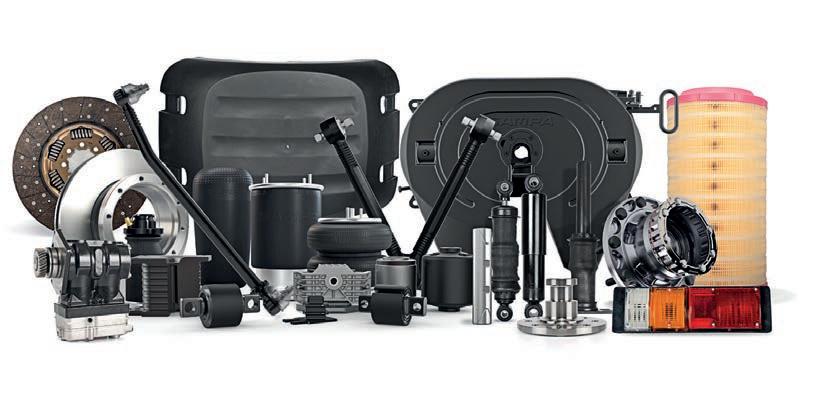
SCANIA is powering a pair of highly advanced mobile reghting solutions for the oil and gas industries, via Fire and Safety Australia.
e rst of two Scania P 500 XT 4×4 re ghting appliances, with bodies built by Frontline Fire and Rescue in WA, has just been delivered to the emergency response team at the premises of one of Fire and Safety Australia’s clients in Queensland.
Prior to deployment to Queensland, the appliance was ‘road’ tested at the Fire and Safety Australia Perth Live Fire Training Academy, where Scania said it passed its test with ying colours.
e appliance carries 3000-litres of water, 200-litres of B-class foam, and is equipped with a two-stage
2000-l/m pump, and a 2000l/m in-cab remote control roof mounted monitor.
According to CEO of Fire and Safety Australia, Steve McLeod, the new Scania is the perfect appliance for remote contracted emergency response services protecting Australia’s mining, oil and gas industries.
“ is appliance features the latest modern design and high levels of crew safety. We’re excited to get this into the hands of our emergency services ocers on-site so they can deliver contracted emergency response services in remote regions of Australia,” McLeod said.
“Fire and Safety Australia is constantly working to raise the standard of emergency response services for our clients. is is the rst of two new Scania 4×4 Fire Appliances. Built
in Perth at Frontline Fire and Rescue they will raise the bar for safety, preparedness, and re ghting capability across the board.”
Benjamin Nye, Scania Australia’s Director of Truck Sales, said Scania is a key partner to re ghting services across Australia with more than 700 appliances in action daily, providing reliable and safe transport for life-saving crews.
“Our expertise in providing the correct and exact conguration of base vehicle for emergency services and their preferred bodybuilders across Australia, means we can deliver a tailored solution for every task,” Nye said.
e Scania is equipped with a 500hp six-cylinder 13-litre engine that can rush from 0-80 km/h in under 25 sec-
onds, providing rapid deployment to the re front in great safety, thanks to the all-steel CrewCab that exceeds European and Swedish crash test standards.
e Waterous CLVT Engine driven pump, rated at 2000-l/ m at 1000Kpa, allows for both stationary and pump-and-roll operations, enabling e cient re ghting from multiple positions.
e Scania CrewCab body can accommodate a crew of ve, with dedicated lockers for extrication tools, technical rescue equipment, rst aid, and hazmat supplies.
e appliance also features Vehicle Rollover Protection, self-contained breathing apparatus storage in the rear cabin seats, and a quick stow ladder gantry to ensure crew
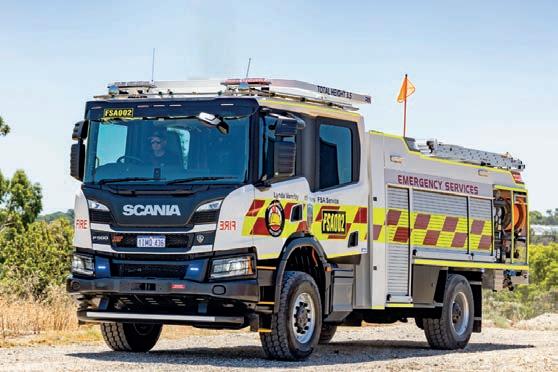
members are always prepared for action.
e new Scania appliances also meet the stringent Safer Together standards for the oil and gas industry. e inte-
gration of large-volume water delivery and foam application will also aid in asset protection, especially when isolating gas supplies and valves during an emergency.
FOR Scania, 2024 delivered nancial results at an all-time high, however it was also marked by delivery problems and challenges in the brand’s battery electric vehicles ramp-up.
“Despite this we made good progress in transitioning to sustainable transport through new partnerships, products and services,” said Christian Levin, President and CEO, Scania and TRATON GROUP.
Levin says 2024 saw robust demand for Scania’s products and services. “I am proud that Scania delivered at record levels in 2024 despite macroeconomic and geopolitical concerns, nally reaching over 100,000 vehicles. anks to resolving many of the supply chain issues, we had the most stable production ow since the pandemic. We captured market share in Europe and Latin America: a testament to the excellence of the Scania Super driveline and the successful reduction of our order book to more normal levels.”
He continued, “Demand for trucks was more hesitant in Europe compared with previous years. In contrast, demand in Latin America continued strongly, with good momentum particularly in Brazil. Once again, we reaped the bene ts of having a global production system, with hubs in both Europe and Latin America balancing regional uctuations in demand.”
A major milestone was reached for the manufacturer in 2024, with Scania reaching half a million trucks produced in Brazil since production started there in 1957. e production hub in Brazil supplies products not only to the Brazilian market, but to around 30 markets in and outside of Latin America.
Levin says upcoming establishment of Scania’s third industrial hub in China will create even more of this global resilience in the business.
“ e new plant, which is due to start production at small scale this year, will deliver our products to customers in Chi-
na and wider Asia with a setup of regional supply chains, manufacturing and commercial operations.”
Levin added that a major highlight last year was making Scania autonomous vehicles commercially available –a key step in the road towards a safe, decarbonised future transport system. “We also launched start-ups to accelerate the sustainable transition of transport. One great example is Erinion, a company that will support the adoption of electric trucks by installing charging points at customer locations across Europe,” Levin said.
Another highlight for Scania was receiving the Green Truck Award 2024, which the brand has won seven times in the last eight years. Despite all these successes, there were also various challenges. As Levin reported, “Updating our software platform to meet new cybersecurity legislation while also ensuring new, value-adding functionality for our custom-
ers proved to be a bigger challenge than anticipated.
“Complexity and quality issues in the implementation of the software meant that many of our customers had to wait too long for their vehicles to be delivered. Letting customers down is not acceptable, and I can assure you that everyone at Scania is doing their utmost to resolve these issues.
“In another setback, our ramp up of battery electric trucks did not move as quick-
trial system to electri cation is a major undertaking that requires new types of partnerships and taking bold decisions in often unchartered territories.
“We are doing everything in our power to shape this new ecosystem, investing our time, money, and competence. Battery electric trucks require a vast number of completely new components, and many of them come from suppliers we are forging new partner-
strategy. “And we are focused on establishing the resilient supply chains needed to make large-scale electri cation feasible across di erent regions and applications,” said Levin.
“Our commitment to decarbonising our business in line with science is unwavering, and we are determined to do all we can to narrow the gap as we approach our 2025 target horizon. We have also introduced new targets for 2032 across all scopes to ensure our continued e orts and full focus in the years

FOUNDED in 1992 by Peter and Jenny Foott, FOOTT has grown into a trusted provider of waste, recycling, processing, and event solutions across regional Victoria and southern New South Wales. Today, the company employs over 100 people under the direction of FOOTT chief executive o cer Andrew Yeoland and continues to see the bene ts of investing in upto-date technology to run its operations.
FOOTT operates a diverse eet of approximately 40 Volvo trucks ranging from 6-pallet tray trucks through to B-double tautliners – however, around 75 per cent of the eet is comprised of kerbside waste collection side loaders, Bucher front loaders and hooklift vehicles.
Over the past three years, FOOTT has experienced exponential growth, recently commencing three new council kerbside collection contracts. e introduction of Victoria’s Container Deposit Scheme (CDS) has also expanded operations, with seven FOOTT trucks being allocated speci cally for CDS collections across Northern Victoria.
“ e size of the business has doubled in the last three years,” said Head of Logistics and Business Integration Zane Foott, who is also Peter and Jenny’s son. “I joined the business in 2016, and like all good family businesses, I’ve
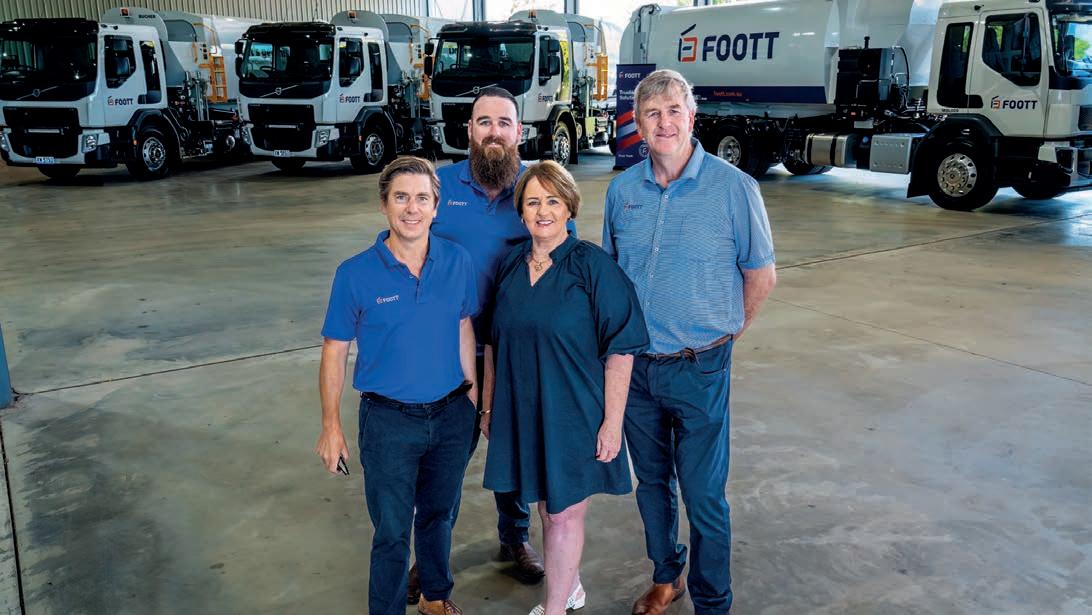
I started out as a driver, spent some time in sales and then went into operations, where my skillset is most suited,” he said.
“My younger brother Aidan still jokes that I was that kid always playing with trucks – I never grew out of it!”
For more than a decade, the business has relied on Procon Telematics - Transport to aid with e ciencies, integrating its Fleetlocate software across the entire heavy vehicle eet.
More recently, FOOTT be-
AI (Arti cial Intelligence) cameras to streamline their waste pick-up. e ProView AI Camera Module is fully integrated with the Fleetlocate platform – so only one User Interface is required.
As Zane explained, “When the company rst turned to Procon, it was solely utilised from a GPS perspective. But as we matured as a business, it sparked conversations with Procon Director, René Bueman, about how we could utilise the software from a

tenance perspective.
“ at’s how we came across these ProView AI cameras, which we’ve been using for about nine months. e key reason we chose to implement this technology was to protect our drivers.”
Zane revealed that when residential waste collection services went from weekly to fortnightly, there was an increase in calls coming through each day from residents claiming their bin had been missed.
“We pick up about 95,000100,000 bins a week and we were getting 50-80 calls a day about missed bins. Often what the resident had done is put more rubbish in
ed. When our drivers know they’ve done the job and there’s a call saying they haven’t, they can take that quite personally. Now we can pull footage that shows our drivers were there – based on the time or GPS location.”
Zane added that incorporating the AI cameras (that allow Live View and Video Requests) has led to huge efciency gains. “We’ve been able to knock back about 90 per cent of ‘missed bin’ calls. Not having a truck run around unnecessarily is a big e ciency gain.
“It’s also been good for morale because drivers aren’t going back to collect bins, they know they’ve emptied. Be-



In the event of a road incident or closure, drivers can also quickly and easily alert others. “If our drivers go down a road and a tree is down, they can stop and ick a text with a time stamp and we can send it to the council, with a drop pin of exactly where it is.”
Along with boosting efciency, the technology is helping to protect drivers and ensure safety. “When a road user calls and says your driver was tailgating my car, we can check the footage from our operations room without the need to go to the truck. at’s where the protection for drivers comes in. It means we can provide that evidence and back up our drivers,” said Zane.
And on the contrary if a driver is doing the wrong thing, FOOTT can address that too. “ e AI tech is quite impressive. It will pick up a wide range of Safety Events, including if a driver is not wearing a seatbelt, or runs a stop sign, so in those instances we can go through that with the driver.”
Zane added that drivers have been overwhelmingly positive about the integration of the new AI camera technology in the trucks. “ ey’ve really taken it on board. ey don’t look at it as being like ‘Big Brother’, instead they look at it as providing protection for them out on the road.
“Our trucks aren’t just travelling major highways, they’re travelling through school zones and around local streets and homes, so this tech is supporting our drivers to be responsible out there while they are working.”
With the AI camera technology now tted to the entire kerbside eet, there are plans to roll it out to all other vehicles in the FOOTT eet too.
As FOOTT has continued to grow, Zane says the relationship with suppliers has become even more critical. “Over time, our relationship with Procon has become more of a partnership. ey’ve taken the time to understand our business and what we’re looking for, and worked with us to help us achieve that – and that’s why we keep coming back.”






Australia has recently introduced new regulations for trucks, marking a significant step toward improving road safety for heavy vehicles.
IN response to new regulations, PACCAR Parts is launching a retro t solution for Autonomous Emergency Braking that brings earlier model Kenworth trucks in line with the new standards.
New Australian Design Rules (ADRs) aimed at improving road safety for heavy goods vehicles came into effect in February 2025. Among these is ADR 97/00, which mandates the tment of Advanced Emergency Braking (AEB) to most heavy goods vehicles over 3.5 tonnes Gross Vehicle Mass (GVM).
Advanced Emergency Braking Systems (AEBS) are de-
ward collisions, alert drivers, and automatically apply the brakes if the driver does not respond. e crucial technology seeks to minimise the severity of in-lane frontal collisions, particularly in monotonous highway driving conditions, said Brett Medlin, the Technical and Account Manager for leading truck braking system specialist Knorr-Bremse. With the new mandates in e ect from February 2025, most new locally built trucks including Kenworths will come with the new safety systems installed by default, so it’s important for drivers

gy and how it operates, Brett explained.
“Bendix Fusion is an Advanced Driver Assistance System (ADAS), designed to enhance vehicle control and safety across diverse driving conditions. e technology is already tted as standard on most new Kenworth models, ensuring compliance with ADR 97/00.”
PACCAR has been an early adopter of AEB technology, equipping locally manufactured Kenworths with the Bendix Fusion technology since the model T610 which launched in 2016. is integrated system combines radar, camera technology, and the Bendix ESP (Electronic Stability Program) to provide comprehensive collision mitigation and enhanced braking capabilities to improve road safety.
Brett continued, “ e collision mitigation system PACCAR uses on its locally manufactured Kenworth trucks is the fully-featured version of Bendix Fusion that includes Enhanced Autonomous Emergency Braking, Enhanced Stationary Vehicle Braking, Multi-lane Autonomous Emergency Braking, and Highway Departure Warning and Braking.”

“Nose-to-tail collisions is the second-most common accident involving trucks after rollovers. In scenarios like a car cutting o a truck, or moving out from a lane of stationary tra c in front of the truck, the Bendix Fusion braking system applies the brakes in a much faster way than a driver can react.”
AEBS is not just relevant for new trucks, compatible older vehicles can be upgraded with the latest life-saving technologies to better support drivers in safety critical situations.
PACCAR Parts is now pro-
viding its customers the ability to upgrade certain older Kenworth trucks that are compatible with the latest Bendix Fusion system.
“Most Kenworth trucks that have an electronic stability program on it could have the electronic brake controller upgraded with the Bendix Fusion system. So long as you’ve got the right level of electronics and valves on the truck, you can retro t it,” said Brett.
“AEBS not only improves the safety of these vehicles, but a lot of tenders including
government, construction and grocery projects specify the level of technology that must be on the truck, including the tment of AEBS.”
PACCAR customers who are considering retro tting the Bendix Fusion system to their vehicles should speak to their PACCAR Parts dealer. e dealer will coordinate with PACCAR’s technical team and Knorr-Bremse’s technical support team to ensure the chassis number is compatible and guide the implementation of the retro t safety system.


Stay ahead of the curve with Bendix Fusion – Knorr-Bremse’s fully integrated advanced driver assistance system.
Combining camera, radar, and braking technology, Bendix Fusion enhances safety with collision mitigation capabilities and o ers features like adaptive cruise control.
Bendix Fusion is available now as a retro t solution for compatible Kenworth trucks.
Contact your local PACCAR Parts dealer today to retro t your trucks with Bendix Fusion!





TELETRAC Navman, a leading connected mobility platform, has announced the ndings of its AI and Driver Safety survey.
e supplement to its 2025 Distracted Driving & Driver Safety Report found that 83 per cent of eets say that AI is the future of safety.
“ e use of AI by eets is expanding from, primarily, eet planning to eet operations,” said Alain Samaha, CEO, Teletrac Navman.
“ ere are clear safety advantages in harnessing AI with vehicle and dashcam data including preventing accidents
by reducing distracted driving, and our customers are turning to Teletrac Navman and TN360 as a partner in achieving these results.”
According to the survey, 26 per cent are testing or piloting AI safety solutions and 18 per cent are exploring options.
Distracted driving incidents, such as using mobile devices behind the wheel are growing.
Forty-nine per cent of respondents to an earlier survey from Teletrac Navman said that distracted driving had a direct nancial cost on their business.
Technology, training, and
developing a culture of safety are three tactics being employed by eet operators to reduce the number of incidents.
As such, 32 per cent of respondents said that AI will e ectively be used to monitor driver behavior in real time and to reduce distracted driving incidents (16 per cent); predicting and preventing potential accidents (17 per cent); improving vehicle maintenance (14 per cent); and enhancing training/coaching through data insights (13 per cent).
However, implementing AI is not without its concerns
and challenges. Despite 66 per cent of teams being aware of the safety bene ts of AI, 23 per cent of respondents said they were concerned about data privacy and 14 per cent fear resistance from drivers or sta .
Forty-seven per cent of respondents said that human interaction is crucial for e ective decision making and 37 per cent said humans provide accountability and ethical oversight.
“Camera and telematic data, in combination with AI, have the potential to be a very powerful tool for eets who need
to cut their exposure to risk,” added Samaha.
“However, people are integral to making that happen,
especially in situations where there may be concerns from drivers and unions. E ective communication is key.”

IN a rst-of-its kind agreement, Transport Certi cation Australia (TCA) has type-approved Teltonika Telematics’ FMC650-MCX650 as a ‘white-label’ telematics device.
is enables TCA’s certi ed and registered application service providers (ASPs) to adopt the device for providing services within the National Telematics Framework – subject to meeting further assessment criteria by TCA.
Paddy Goodall, Austroads General Manager of Service Delivery, congratulated Teltonika Telematics on the achievement.
“Obtaining type-approval for the FMC650-MCX650 provides Teltonika Telematics customers and partners with con dence that the telematics device has been independently assessed and meets the performance-based requirements outlined in the Telematics Device Functional and Technical Speci cation,” he said.
“ is white-label approach provides exibility to telematics providers wishing to become a certi ed ASP. Leveraging the availability of the type-approved Teltonika
device means that telematics providers can choose to overcome the need to present their own device for type-approval as part of the certication process.
“Existing ASPs may also elect to use the Teltonika’s telematics device – so long as they can demonstrate to TCA how the device and the data it generates is incorporated into the ASP’s system,” he explained.
Kęstutis Grauslys, Chief Executive O cer of Teltonika Australia, said obtaining the type-approval from TCA was a signi cant mile-
stone for the company.
“As a hardware manufacturer with a strong connection to our local market, we are encouraging our technology partners to use our type-approved telematics device for RIM and TMA schemes.
“For our partners looking to become TCA certi ed, our type-approved device can bring signi cant time and cost savings and reduce time to market,” he said.
“Teltonika has long shown a commitment to industry leading compliance across the globe. I’m very proud

to see Australia now added to that list with TCA. My team and I look forward to helping more Australian businesses reach their full potential.”


















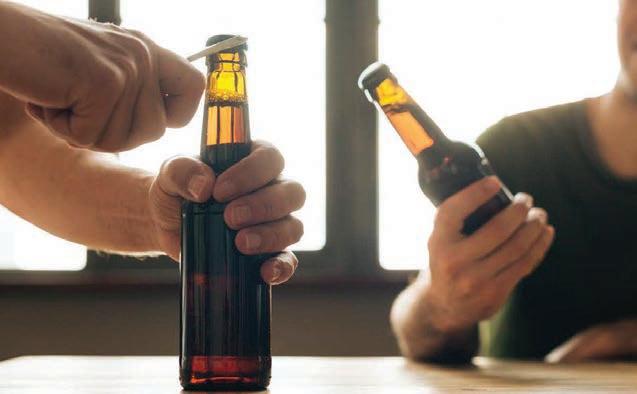





















































































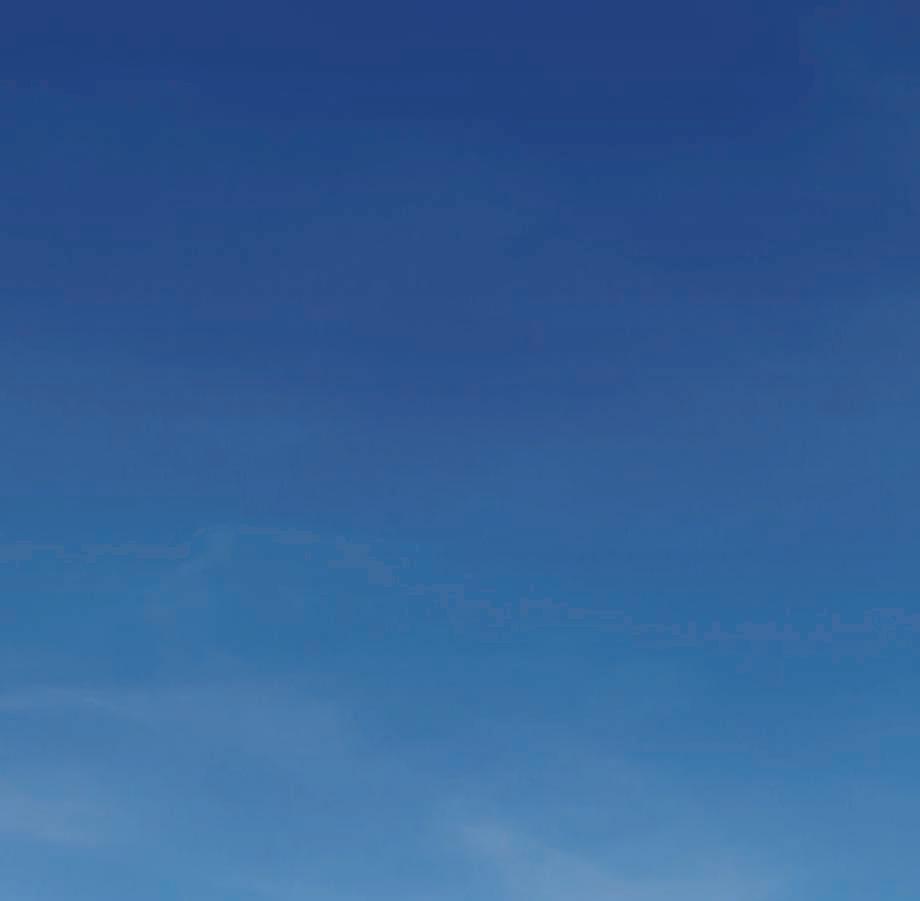

Take your fleet operations to the next level with Geotab, the industry leader in telematics. Our advanced solution combines real-time vehicle data, powerful analytics and intuitive dashboards, empowering you to make smarter, faster decisions that keep your fleet on the road.


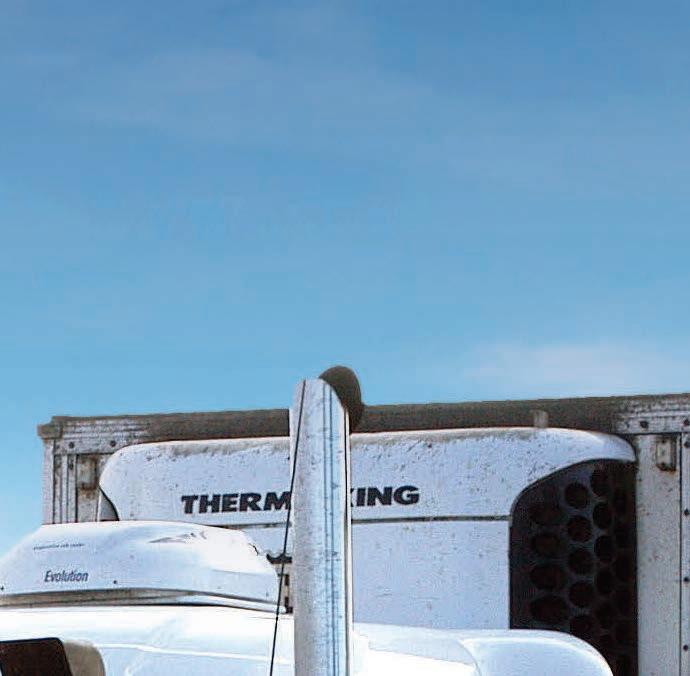










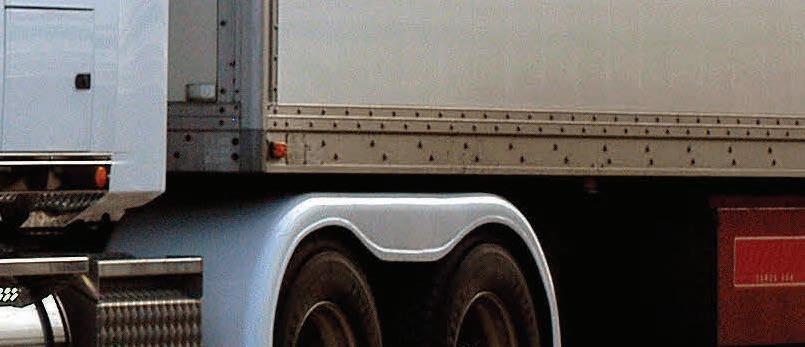


DEPARTURE DURATION
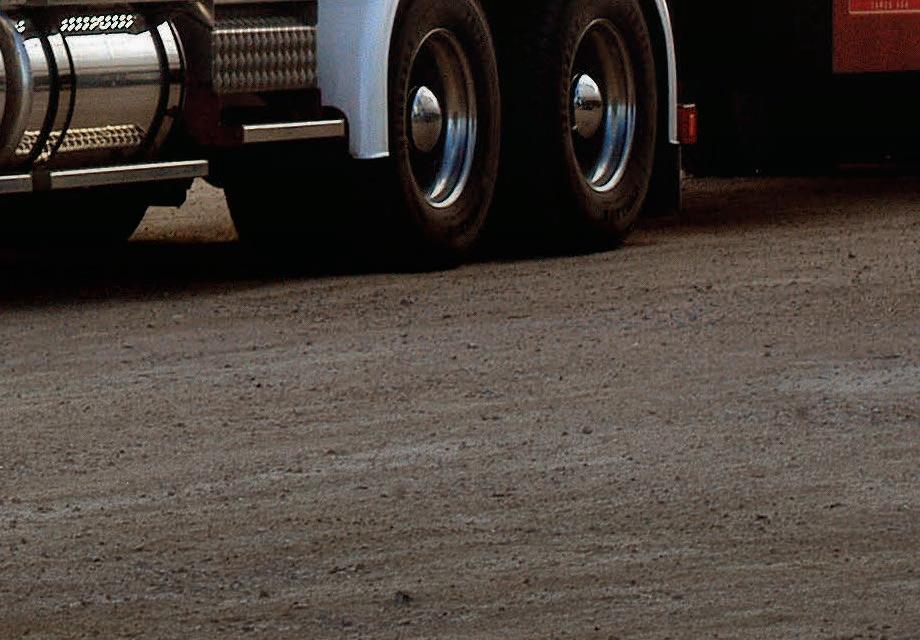
AT Aussie CTI Systems, we’ve designed, built and tested our components to suit Australia’s tough, demanding conditions, giving transport operators a simple, safe and reliable means of controlling tyre pressure from the cabin.
e team is headed up by Andrew Kee and includes Stuart, David and Nik (names that many in the industry will recognise). is experienced team are passionate about the work that they do and o er more than ve decades in CTI design, development and manufacture. ey know the job and what works best for your operation.
CTI is no longer an untried and yet to be proven concept but is now known as a crucial and invaluable option o ering many bene ts for drivers and vehicles. e industry acknowledges this, and many contracts now have a requirement for a CTI system to be tted to all their haulage trucks.
Let’s look at the benefits:
Increased traction: Aussie CTI allows you to adjust the tyre pressure according to road
safety on loose, wet or uneven terrain, increasing vehicle mobility. Traction is increased by up to 2 ½ times giving you the equivalent of 20 drive tyre footprints instead of eight.
Reduced tyre wear: By maintaining optimal tyre pressure, Aussie CTI reduces tyre wear, often extending the life of the tyres by double or triple, therefore reducing replacement costs. It reduces punctures and all but eliminates blow outs.
Improved fuel economy: Proper tyre in ation reduces rolling resistance and improves fuel economy which saves money.
Better stability: Properly inated tyres contribute to the vehicle’s stability, helping to prevent rollovers and other accidents.
Reduced maintenance costs: Aussie CTI helps reduce shock which prevents truck vibration and damage, reducing maintenance costs, which can be expensive in terms of downtime and repairs.
Improved safety: Properly inated tyres contribute to better vehicle handling, reducing the chance of jack-kni ng with up to 20 per cent shorter
BY MAINTAINING OPTIMAL TYRE PRESSURE, AUSSIE CTI REDUCES TYRE WEAR, OFTEN EXTENDING THE LIFE OF THE TYRES BY DOUBLE OR TRIPLE.”
Enhanced o -road capability: Aussie CTI allows drivers to lower tyre pressure when o -roading, increasing the vehicle’s ability to traverse challenging terrain.
Improved driver comfort: Properly in ated tyres contribute to a smoother ride, reducing whole of body vibration by up to 60 per cent which reduces driver fatigue and improves comfort.
Better resale value: Well-maintained vehicles with properly in ated tyres tend to have better resale value, which can be important for companies looking to upgrade their eets.
Many industries benefit enormously from the use of Aussie CTI: Log haulage: Traction is improved 2 ½ times. Tyre life is often doubled. Up to 60 per







cent less road damage.
Road trains: Tanami, Tropicana, Gibb River roads, along with others that are a challenge. Large corrugations, gravel roads, gibber rock require reduced tyre pressures on the drive and steer tyres.
Tippers: Running 90 PSI on
traction and reduces the likelihood of jack kni ng.
Electrical service industry: EWP and pole trucks. Two big bene ts for this industry are maximum traction which reduces bogging and the ability to use 2x4 and 6x4 trucks where traditionally 4x4 were es the chance of being bogged when servicing hives and the reduction in vibration which reduces stress and death for bees and cracked honeycomb when transported.
Aussie CTI Systems will be displaying at the Brisbane Truck Show (May 15-18) at site 221 on the mezzanine















FOUNDED by father and son duo Dean and Logan Piggott in 2021, Wyndham Steel Solutions helping clients design and construct their dream homes and buildings.
ey put their considerable experience in the steel and construction industries to work for the family business, with Dean’s younger son joined their side in 2023, bringing a background in Insurance Building, focusing on compliance and business management.
Starting out of a small factory in Melbourne, the business provided a personal touch for their early clients, from hand-drawn blueprints and hand-painted nishes on the steel to fabricating everything from the factory. e duo focused on installing one residential project weekly while building up their client lists.
Four years on, and they’re still keen to keep all services in-house: from drawings executed on AutoCAD and Tekla programs to fabricating steel products and working a painting station to streamline the production process. e in-house team also completes all structural steel project installations.
“Keeping everything inhouse has allowed our business to grow our capacity, allowing us to install roughly two jobs a day, keeping a constant ow of work on our books,” said General Man-

ager Noah Piggott.
“We have recently ventured into the brick steel lintel market and o er services for delivery and lifting of all lintels required for construction projects, with all projects installed with our Isuzu crane trucks.”
“We are currently about to break ground with a new purpose-built factory, warehouse and o ce space. is will be our biggest in-house project to date, and we are excited to see the build come to life.
“ is new space will be approximately three times the size of what we have now, so between the new factory and our new Isuzu, our capacity for jobs is set to triple in size.”
e business relies on a eet of Isuzu crane trucks to carry the weight of every
project, with the small but dedicated team transforming how homes and commercial buildings rise from the ground up.
Wyndham Steel Solutions’ new crane truck is an Isuzu FRR 110-240 AMT with a long wheelbase and a F.lli Ferrari crane installed onto the custom tray built by LVTC Transport Equipment, which joins two other Isuzus – a FVL 240-300 Auto crane truck and a classic NPR 300.
e new FRR 110-240 is underpinned by an Isuzu 4HK1-TCH 16-valve engine, which provides f 177 kW (240 PS) at 2400 rpm and 765 Nm of torque at 1600 rpm.
With a generous GVM of 11,000 kg, the FRR 110-240 AMT has ample payload for
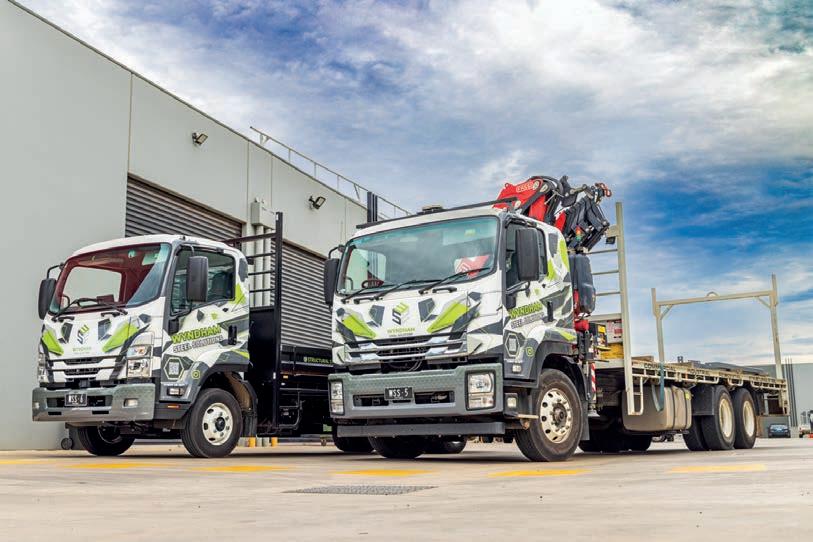
quired load of steel. is is supported by a long wheelbase of 4.99 metres, which provides plenty of room to move their products.
Graphic designer Rickie Arnott created the stylish look for the FRR with the wrap installed by locals Brand FX.
’We selected the FRR 110240 because of its ability to carry structural beams and brick steel lintels, its manoeuvrability no matter the job site, and because it’s economically friendly with its fuel consumption,” said Noah.
“ e F.lli Ferrari crane was hand-picked due to the length we required at full capacity, and for length-toweight ratio, we found the FRR is the perfect match to get the crane on site.
“We can then use the crane
truck and stabilise the weight of T-Bars, which are lifted into place over structures such as garages.”
With clients ranging from small builders, high end architectural rms and Tier 1 high-volume builders, Wyndham Steel Solutions is tackling everything from residential and commercial steel packages to complex architectural installations. ey’re taking steel design, fabrication, installation – and their trucks – further than ever before.
“At Wyndham Steel Solutions, we pride ourselves on impeccable service and product quality, ensuring that all project deadlines are met to the highest of standards,” explained Noah.
As an out t that relies heavily on its eet to deliver a full-package service, Wyn-
ing to its transport partner to provide infallible backup support as the business expands and trucks that will last the distance under heavy duties.
e FRR 110-240’s sixyear standard warranty (or 300,000 km) and six years of roadside assistance, which is available 24/7, are helpful in this regard.
“Geelong Isuzu, particularly our Sales Manager Rob Fitzgerald and Dealer Principal Phil Halleday have been fantastic to deal with,” said Noah.
“Because our business relies heavily on our Isuzu eet, the support from a dealership that is willing to go the extra mile is vital.
“We have thoroughly enjoyed going back and buying three Isuzu trucks through the dealership.”
ISUZU Australia Limited
(IAL) has kicked o its popular Truck of the Year competition for the 28th consecutive year – and it’s open to Isuzu truck owners right around the country.
e competition sees hundreds of Isuzu trucks entered annually from across a range of trades and industries.
IAL Marketing and Advertising Manager Sam Gangemi said Isuzu Australia was thrilled to welcome Isuzu truck owners to another year of the competition.
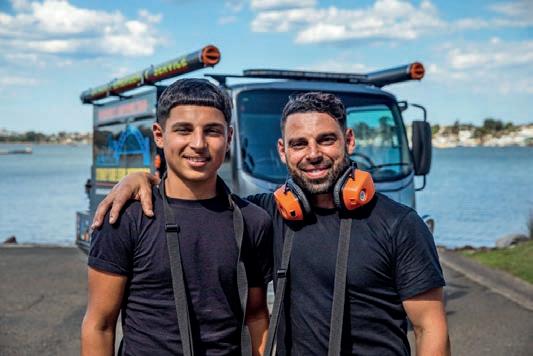
movement or a dozen other industries.
“Every year, we are blown away by the calibre of trucks and also the support of our customers who rely on Isuzu for their transport,” he continued.
“We can’t wait to see what 2025 has in store!”
Trucks merchandise prize packs and generous cash prizes to PR opportunities with Isuzu Trucks that can take business exposure to the next level.
Monthly winners will receive an Isuzu Trucks merchandise pack valued at $300 RRP.
Plumbing won the title of the top truck with an NLR 45-150, which sports a highly customised body for carrying plumbing and leak detection equipment.
“ e competition truly serves to highlight that Aus-
“Life on the road is never dull, and neither are the entrants and the Isuzu trucks that support them,” said Gangemi.
tralian air for ingenuity and drive to create the perfect rig, whether it’s a truck being used in trade, waste, freight

e Truck of the Year competition opened on March 3, 2025 and closes on December 1, 2025. Entrants can nd instructions on how to enter, plus a full list of terms and conditions at isuzu.com. au/news/truck-of-the-year.
Multiple prizes are up for grabs, from monthly Isuzu
For ‘Series’ Prize winners (one each from Isuzu’s N, F, FX/FY truck series), a $1500 cash prize is awarded, with one of the three kingpins then going on to score the title of Isuzu’s Truck of the Year and the massive Grand Prize of $6000. Last year, Sydney Side
“We’ve designed a custom NLR 45-150 that’s equipped with everything for our business of leak detection and plumbing in Sydney,” said Sydney Side Plumbing Director Mohammad Mourad.
“My Isuzu truck has a high-pressure water jet out the back, PVC pipe holders on top, and emergency lights and an LED board that can display messages while working on the road.”

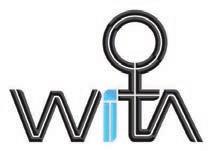


FUEL prices are a major concern for veteran owner-operator Col Wallace who drives an old but reliable Kenworth T904 from his Brisbane base.
Col, 62, was sitting in the driver’s seat when Big Rigs saw him parked up in North Queensland earlier this month.
“I have dreaded the day that I come across you because I am a shy bloke and don’t normally allow my picture to be taken,” Col said.
However, after a minute he repented and said he was happy to appear in Big Rigs which he reads often.
Col had transported crane weights from Oakey to Mareeba on the Atherton Tablelands and was taking cars back south to Brisbane.
A truckie for 20 years, Col enjoys stopping at the Ampol Emerald roadhouse in Queensland and the one at Caiguna on the Nullarbor in WA. I asked Col if there are enough rest areas around Australia and surprisingly he answered “yes”.

“I like stopping at ones where there is no noise at night so I can have a sleep,” he said. His ambition in the next year is to quit smoking or at least cut back.
However, realistically he feels that may well be a mission impossible.
As for hobbies Col answered swiftly, “Trucks and having a beer on my days o .
I like Great Northern Super Crisp and Miller’s Chill,” he said.
e worst road he gets on is the Belyando between Clermont and Charters Towers and the one near Miles. “Both are very rough,” he said.
In conclusion, Col added that rising fuel prices were a ecting all owner operators and small eet companies.

WHEN Townsville-based driver Terry Russo nomi nated his worst road as the 110km stretch of the Flinders Highway between Hughen den and Richmond, he came up with two apt reasons why.
“Going along it is like swirling around in a wash ing machine or being a cork bobbing around the ocean in rough seas,” he said.
e 49-year-old truckie drives a Kenworth T909 for B&K Bulk Haulage out of coastal Townsville and was sitting on a milk crate behind his shiny rig when I saw him parked up at the BP Cluden Roadhouse.

the Flinders Highway and the Astron at Hughenden. Terry said more rest areas are required for truck drivers with decent facilities.
An outdoors man, Terry likes camping and shing and his favourite spot is the waters of the Tinaroo
on the scenic Atherton
“I catch some black bream and Barramundi,” he said.
On a hot day o , Terry also enjoys a cold beer at the Yungaburra Hotel, also on the Atherton Tablelands. “I was born and bred there,” he said.
mine,” he said.
“I am carrying cement powder and lime between Townsville and a western
A driver for 20 years, Terry likes stopping at the Puma Julia Creek Roadhouse on
He barracks for the local side the North Queensland Cowboys as well as the Melbourne Storm in the NRL.
WHEN Big Rigs saw Dave O’Keefe late one evening, he was sitting in the driver’s seat of his Kenworth cabover enjoying some tucker.
which closed many roads in the north.
“I was home at the time,” he said.
as a batter, pitcher or elder. “I am a bit of an all-rounder,” he said.



e 45-year-old driver works for MBT out of Lake Macquarie in NSW and mentioned how hot it was at Townsville deep in the tropics.
“I have brought up waste oil from Brisbane to Townsville and have a backload of oil from here to deliver to Gladstone,” he said.
e worst road he has been along recently is the Gregory Development Highway between Clermont and Charters Towers.
“ e road is all over the place and up and down in many parts and is di cult to drive on,” he said.
His NRL football team is the successful Penrith Panthers which have won four premierships in a row.
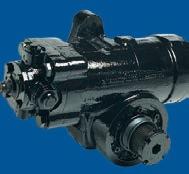









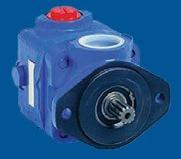




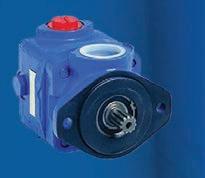












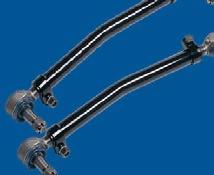














e Kenworth is powered by a Cummins 550hp motor and has an 18-speed gearbox.
Dave’s favourite roadhouse is the Caltex at Wodonga in Vic toria. “Great food and friendly sta ,” he said.







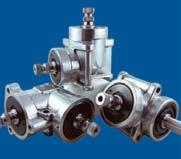

“It is a good truck but a bit dirty at the moment,” he said.
Dave was fortunate to have not got caught up by the oods
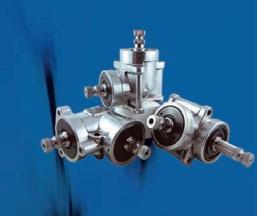




Dave added that more rest ar eas were required for truckies.
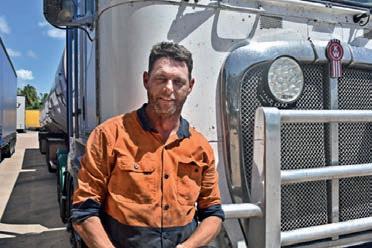
Outside work Dave plays baseball in the Newcastle competition. I asked if he excelled


















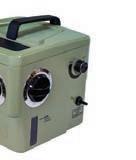

FIRST-AID skills save lives, and in our industry, we unfortunately may need to use them more than most.
In fact, over 67 per cent of truck drivers will be the rst responder to an accident at some point in their career. e importance of rst-aid knowledge can’t be underestimated.
Considering the remote regions many of our members drive through on a regular basis, the need for rst-aid is ampli ed.
It can be a long time before medical aid is on the scene of an accident. Alarmingly, road deaths are also on the rise in Australia and have been for
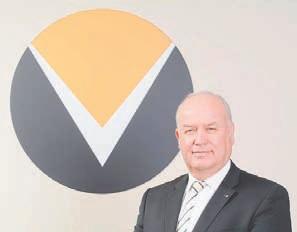

the last four years. Anything we can do to help reverse that trend is an opportunity we should not shy away from.
at’s why we’re pleased to announce NatRoad has secured new funding to enable the roll out of our existing Truckie First Aid e-learning program in multiple languages. Developed by St John Ambulance Australia in partnership with NatRoad, this
easy-access training package was originally launched in October 2023. e training has so far reached around 1500 truck drivers. Funding has been obtained through the National Heavy Vehicle Regulator’s Heavy Vehicle Safety Initiative, supported by the Australian Government.
e funding will allow the online rst aid training to be translated into up to seven new languages.
is will make it easier for drivers with English as a second language to be fully immersed in the learning experience, while reducing any potential barriers to taking the course in the rst place.
e project will be completed by the end of this year, leading to more drivers out on the road with skills such as how to perform Cardio Pulmonary Resuscitation, how to stop various types of bleeding, and how to ensure an airway is open and unobstructed.
ese three skills alone can save lives in the crucial rst minutes of a vehicle crash or roadside incident and prevent irreversible damage.
If a person is not breathing, it only takes three minutes for their brain cells to start dying. If you succeed in reopening their airway or restarting their heart, you give the emergency services valuable time to arrive and provide further care.
A person can also bleed to death in less than ve minutes, if the rst responder doesn’t know how to stem the bleeding e ectively. e rst ve minutes are critical, and the more people out on the roads with this knowledge, the better.
As anyone who’s been a rst responder knows, it can be extremely stressful. Knowing what to do when the time comes can improve the mental health outcomes in the aftermath of an incident.
A recent national survey by St John found that people who had undertaken rst aid training were signi cantly more likely to have con dence in their ability to provide care in an emergency (74 per cent) compared to those that had not undertaken rst aid training (31 per cent).
Even though 33 per cent of Australian adults surveyed recently had witnessed a health
or medical emergency in last 12 months, rst- aid training across the board in Australia is quite low compared to other countries. Road safety is an issue that must be approached from more than one perspective. NatRoad is also focused on raising the AusRAP star rating levels of highways, and a raft of other initiatives to keep us all safe. More details are available in our Road to 2028 national reform agenda, available on our website, as are details of the Truckie First Aid program. Truckie First Aid is a training program that takes 30-40 minutes, is available to everyone, everywhere, even on your phone at a rest stop. Truckies can save lives, do the training and be ready. Free, online Truckie First Aid training is available to complete any time at: truckiefirstaid.org.au.
One of the VTA’s primary functions is serving as the uni ed voice of the freight, logistics, and transport industries. is means engaging proactively with government bodies at all levels to shape legislation and policies that impact both our members and the industry as a whole.
IN the ever-evolving world of freight, logistics, and transport, the Victorian Transport Association (VTA) stands as a crucial advocate and support network for its members. By championing policies and initiatives vital to our sectors, the VTA plays an instrumental role in driving growth, sustainability, and innovation.
e bene ts o ered by these associations are vast, including advocacy, education, networking, and much more.
For example, the VTA has been a strong advocate for infrastructure investments that enhance transport e ciency and reduce congestion. rough persistent lobbying and representation, we ensure that our members’ interests are considered in policy decisions, creating a more favourable business environment.
Beyond policy advocacy, the VTA o ers valuable educational resources that help industry professionals stay informed and competitive.
e transport sector is constantly evolving due to technological innovations and regulatory shifts. Staying ahead of these changes requires access to current information and specialised training. To meet this need, the VTA provides a range of workshops, seminars, and training programs designed to develop the skills and knowledge of industry personnel.
ese initiatives empower our members to remain at the forefront of industry trends, adopt new technologies, and comply with changing regulations.
For the VTA, membership in the Australian Road Transport Industrial Organisation (ARTIO) is particularly valuable. ARTIO serves as a uni ed voice for road freight operators, addressing their speci c needs and chal-
lenges at both the state and national levels.
Being part of ARTIO grants access to essential resources, advocacy, and support tailored to the unique demands of road freight operations.
Networking is another key bene t that industry associations o er. e VTA fosters a strong community within the freight, logistics, and transport industries, providing a platform for collaboration, knowledge sharing, and business development.
Regular networking events, conferences, and forums allow members to connect with peers, exchange best practices, and form strategic partnerships. ese interactions not only bene t individual businesses but also strengthen the overall cohesion and vitality of the industry.
Promoting environmental sustainability within the
transport sector is also a key priority. With growing global awareness of environmental impacts, the transport industry faces increasing pressure to adopt greener practices.
e VTA supports initiatives that foster sustainable development, including the use of alternative fuels and eco-friendly technologies.
By advocating for and facilitating the adoption of these practices, the VTA helps its members reduce their environmental footprint and contribute to a more sustainable future.
Another signi cant advantage of industry associations is their promotion of standards and best practices.
By developing and disseminating guidelines on safety, e ciency, and operational excellence, the VTA helps elevate the overall quality of the industry.
High industry standards not only enhance the reputation of individual businesses but also build trust with customers and the public.
Ensuring that the transport sector operates smoothly, safely, and e ciently benets all stakeholders involved.
In summary, associations like the VTA are invaluable allies to the freight, logistics, and transport industries. rough strong advocacy, comprehensive education programs, ample networking opportunities, a commitment to sustainability, and crisis management support, the VTA provides signi cant value to its members.
Joining these associations not only grants access to a wealth of resources and support but also strengthens the collective progress of the transport sector.


ORIGINALLY, we planned to share this article on the National Heavy Vehicle Regulator (NHVR’s) latest safety campaign, A Truckie Knows.
But, with this month’s weather event hitting extremely close to home for many of us based in southeast Queensland, instead, we’re revisiting how the NHVR deals with emergencies and disasters such as (ex) Tropical Cyclone Alfred.
At the start of the weather season, industry, the NHVR and our jurisdictional partners – particularly in tropical weather a ected states - are generally prepared and anticipate that incidents can arise, and often with short notice.
e NHVR works closely with its peers in emergency response and government to keep informed of the changing weather landscape and position itself to be ready to respond when needed.
During an emergency such as a cyclone, there are multiple priorities, but two stand out as signi cant: ensuring
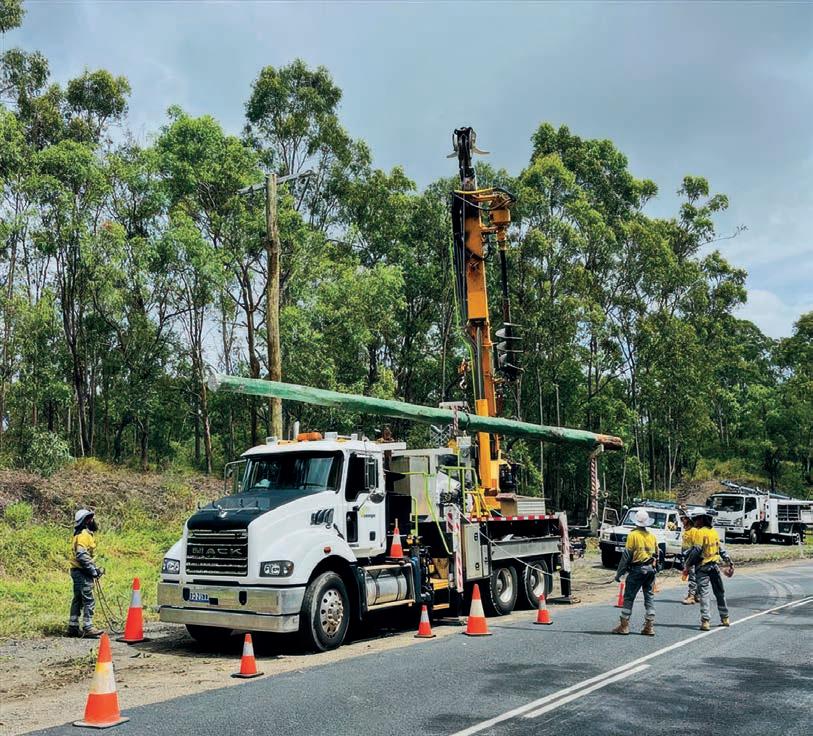
essential supplies and assistance can reach those most in need in a timely manner, and working to safeguard the people delivering those goods and services.
A key element of ensuring timely access is the provision of national notices, to provide “as of right” access
to eligible heavy vehicles, removing the need for permits in emergencies.
e NHVR will work with government to ensure vehicles that need priority access to a ected areas can do so in an e cient manner, to best ensure the safety of local communities.
Over four days leading up to TC Alfred, members of the NHVR, particularly in Access, worked to add an additional 22 Local Government Areas (LGAs) to the Emergency Defence Assistance to the Civil Community Notice. is task involved work-
ing with local government to identify potentially impacted councils, preparing and sending consents, uploading consented roads to the National Network Map and marking high-risk structures, among other things.
e result of this work meant the Australian Defence Force (ADF) could deploy heavy vehicle assets as needed and with con dence across these LGAs to support communities in need, without having to seek or wait for approval.
Emergency events are unpredictable and the ability for the ADF to deploy exactly when needed is critical to the safety of communities.
Generally, during a disaster, freight is essential. Before TC Alfred arrived, critical supplies like sandbags, water, non-perishable pantry items, and other household goods (it always seems to be toilet paper?) were treated like gold.
Heavy vehicles also helped to ensure the movement and removal of potential hazards, such as green waste, so that communities were prepared for the worst.
During the emergency, the NHVR also deployed an Access on-call team to ensure defence assets and other emergency services, such as
Energex, could bring power back online for impacted communities.
To maintain the safety for all road users during an emergency, the NHVR must also focus on its community messaging.
We have a dedicated team of social media o cers who work with their business partners across the organisation, as well as other emergency services and organisations, to deliver timely and relevant information across our social channels.
ese messages include important updates such as road impacts and closures, preparedness information for operators and drivers and contact details where necessary.
Our contact centre is also always available seven days a week, to ensure industry can reach out as needed.
ese disasters can often create anxiety and panic, with the volatility of a weather event like a cyclone making for a di cult time for the community.
But the reliability of the heavy vehicle industry goes a long way to instilling condence and assuredness in those a ected.
So, the NHVR would like to thank everyone who worked with us during this event, as well as those who heeded emergency warnings and helped to ensure a safe community.











































BY DANIELLE GULLACI
AFTER 15 years of running her own successful cleaning business, Rhiannon Cooper was looking for something more.
at’s when her truckie partner Marty Rivett jokingly dared her to get her truck licence. Not being one to shy away from a challenge, she did just that.
Based in Adelaide, Rhiannon is a mother of two teenagers, aged 17 and 18. She was wanting to change careers but also needed something that provided exibility too.
“As well as cleaning houses and running my business, I was volunteering at my footy club – so exibility was the deciding factor on which career would best suit my busy life,” she told Big Rigs.
“I play football, I’m a medic and secretary of the club. It’s all volunteer work but is basically a full time job. I was actually looking for something that complemented being able to continue do that and be there for my kids.
“Once the kids hit their teens, my partner took me out in his truck and began showing me the ropes.”


on knowing I had no experience. ey worked with me.
ONCE THE KIDS HIT THEIR TEENS, MY PARTNER TOOK ME OUT IN HIS TRUCK AND BEGAN SHOWING ME THE ROPES.”
RHIANNON COOPER
son I’ve excelled at what I’m doing.”
Rhiannon’s also not afraid to get her hands dirty either.
“At 10am this morning I was completely covered in oil, so it’s a bit of a messy one,” she laughed.
From behind the wheel of an Iveco Powerstar 550, Rhiannon travels across the state doing predominantly tautliner and at top work, along with some tipper work where needed.
Rhiannon enrolled in a TILE (Training in Lieu of Experience) course, which she completed with Courtesy Driving School and was able to secure her HC licence in 2022.
“ ey said there are too many people dying on our roads, so we won’t give you a licence until we know you can do everything,” explained Rhiannon. “And I value the fact that they were like that and were committed to teach-
“I did the TILE course and Marty took me for a few drives in his truck. I’m now a few years in and I’ve never looked back. I absolutely love being on the road and I love my current job.”
Shortly after securing her licence, Rhiannon got her
Specialising in scrap metal transport since 1974, the company operates across South Australia, contracting to numerous major waste companies.
“GT has been really great and were willing to take me
All of my co-workers have been fantastic, especially my transport manager Anna,” said Rhiannon.
“I would put a lot of what I’ve done and learnt down to her patience. I’ve been able to call her and she’s the voice of reason when I’ve needed it. She’s de nitely been the rea-
“We go all over South Australia picking up scrap metal and we also deliver scrap metal to the ports. A lot of our drivers run tippers out of the scrap yards and into major metal dealers,” Rhiannon explained.
“About 90 per cent of my work is the tautliner or at top work. As hard as the at top stu is, and it’s usually really physical with the chains and whatnot, I really enjoy that work. I like having to work








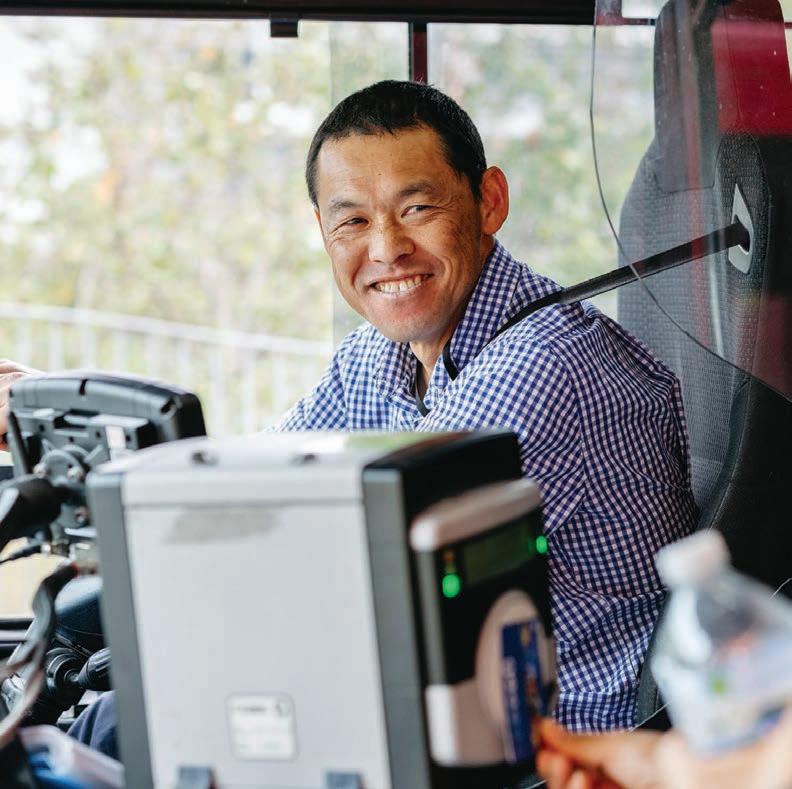

out the weights and load dis tribution.”
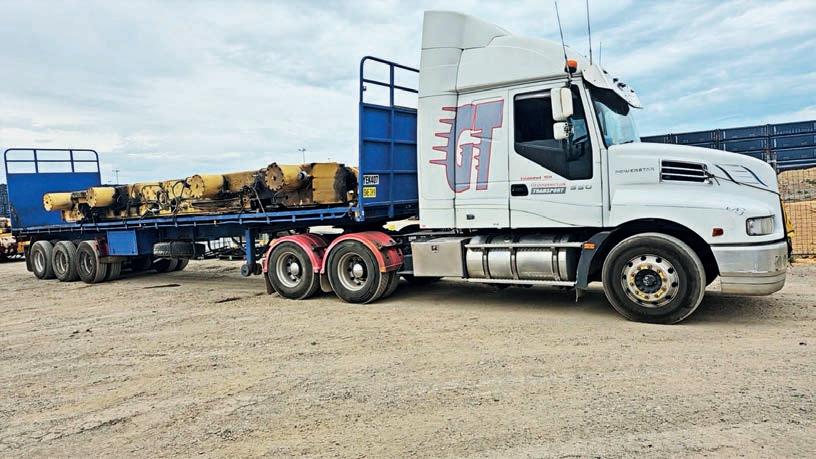
her dangerous goods licence, which sees her doing a lot of work transporting batteries for recycling.
“A battery recycler recently opened up here in Adelaide, so we pick up batteries and bring them to the plant. It has been a learning curve for us and for the scrap yards in terms of the bulk transport of batteries. It’s not something we’ve ever had here before,” explained Rhiannon.
“Before you had to pay to get rid of batteries, now they’re paying people by the kilo for used batteries. At the new Lions Gate facility, about 8000 tonne of scrap batteries have come out of people’s homes and businesses in the last 12 months.
“ e used batteries go into a machine, then the acid goes into silos and is neutralised, the lead gets shipped to China, and the plastic gets recycled.
“Because I’m the only one with a dangerous goods licence I’m usually pretty at
day is di erent. “I go wherever the work takes me.”
More than three years into the job, Rhiannon says one of her biggest highlights to date was seeing the look on a little girl’s face when she saw her behind the wheel. “I was stopped at a zebra crossing in front of a school and this little girl –
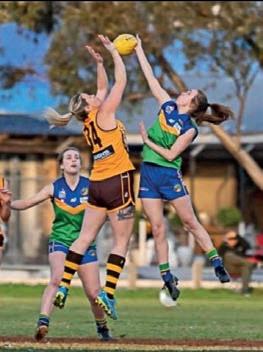
who would’ve been three or four years old – looked up and was so excited to see a female driver. I saw her mouth the words, ‘It’s a lady in the truck’. She had the biggest smile on her face and was waving at me. She was so excited which was pretty cool to see.”
Looking ahead, Rhiannon says she’s now got her sights set on going for her MC licence. ough she reiterated, she has no plans to move any time soon. “I’m not sure where it will take me but for now I’m content with all the di erent things I get to do at GT – no two weeks are ever the same!”
She also had high praise for her partner. “Marty’s been a massive support for me and his continuous push and encouragement means the world to me. With both of us on the road, it is challenging to t life in, but we make it work. He’s away doing interstate and I’m on the road too, so there are challenges with being a trucking family. But as busy as we are, I wouldn’t change a thing.”




NOMINATIONS are being called for this year’s Young Gunnette Award.
e Transport Women Australia Limited (TWAL) initiative is o ered to young women under the age of 30.
TWAL said the award highlights how the peak body continues to promote, motivate, and encourage young females who are already “shining a light on our industry” early in their careers.
Entrants must be individuals who can display that they are contributing to the industry over and above paid employment/business.
“ is can be someone who has demonstrated leadership

and/or who has been involved in a signi cant initiative that has brought about positive change, added value to the industry or is advocating for the industry,” said TWAL Chair Jacquelene Brotherton.
“TWAL is delighted to offer this award recognition to an amazing young woman in the industry. We have some incredible young women in our industry and among our TWAL members and this is a chance to recognise one of them.”
e launch of the 2025 award was announced at the 2025 Apprentice Onboarding for sponsor Cummins on February 10, and both

Cummins and TWAL were delighted that at this large intake of apprentices, 39 per cent were females. Award nominations close on April 17. Nomination forms are available by contacting chair@transportwomen.com.au. e winner will be announced on June 2. Last year’s inaugural Young Gunnette Award went to Ainsleigh omas.
Ainsleigh spent the previous past nine years working for Australia Post and took on the role as StarTrack’s NSW/ACT Linehaul Manager when she was 25, managing about 12 contractors and 102 linehaul movements every night.

Easter Group, located in Wacol, provides time sensitive road transporting solutions to many companies throughout Queensland, New South Wales, South Australia and Victoria. We are a family owned business, operating since 1976. We currently have the following positions available: OPERATIONS ALLOCATORS (Brisbane based only)


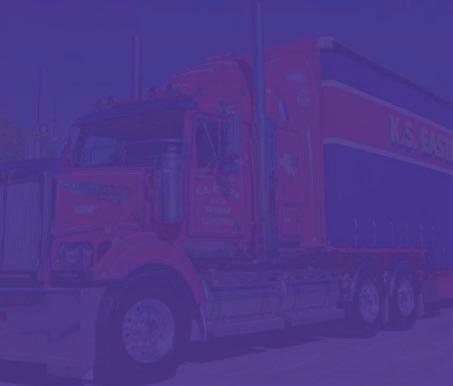

You will be required to work on a rotating roster including Days-Nights-Weekends Previous Operations experience preferred.

(Brisbane, Sydney, Melbourne and Adelaide Based)
Come and work for us as we are committed to:
• Training and further education • Your safety
• Maintaining an impressive Fleet On offer arepermanent full time and roster positions including paid leave entitlements and public holidays. Drivers will need to be available to be scheduled for work falling across the 7 days of the week.
The successful Applicant will:
• Hold a current MC licence (minimum two years) • Have knowledge of the HVNL and Load Restraint • Be professional • Be reliable
To apply for the Operations/Driver positions please contact Operations Manager or by emailing your resume to
(Brisbane based only)


To apply for Mechanic positions please forward your resume to Workshop Manager via email to employment@kseaster.com.au


